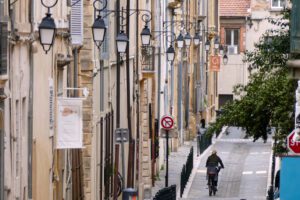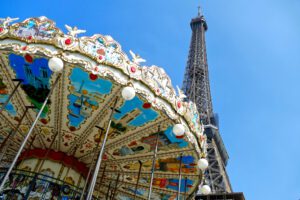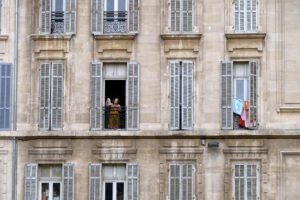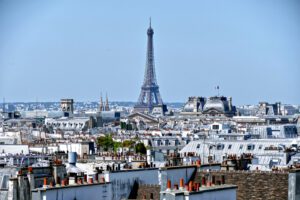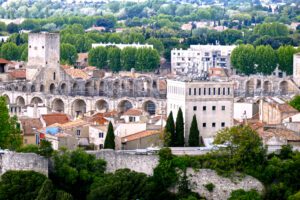Paris is the city of light, love, and unmatched charm! No matter if it’s your first visit or your fiftieth, the French capital never fails to enchant. Whether it’s the elegant boulevards or authentic quartiers, the leafy parks or world-famous museums: Paris blends effortlessly beauty, history, culture, and style.
But where to start and what to see?
Fear you not, as in this guide, I put together all the must-dos during your stay in Paris, no matter if you’re one of the lucky first-timers or a hooked regular. This way, you will soak in the essence of the city from the very moment you arrive.
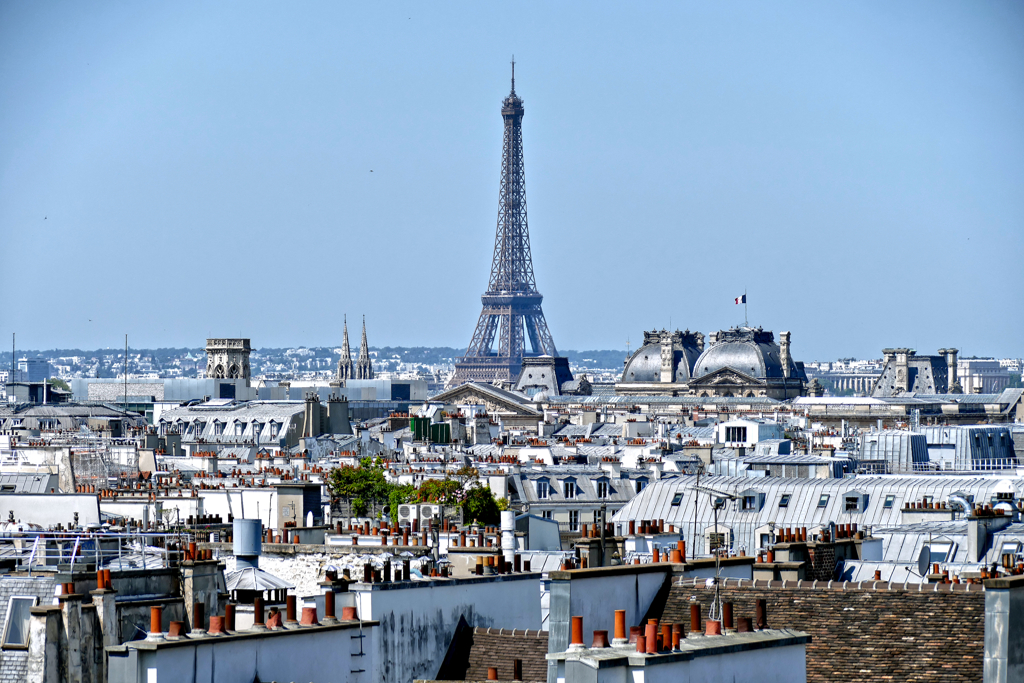
Paris – A Moveable Feast
I was a teenager the first time I visited Paris. For my mother, the city was an absolute myth, and she had long dreamed of strolling along the boulevards and standing in front of the sights she knew from books and films. I don’t know why my father didn’t accompany her. In any case, that made me her designated travel companion.
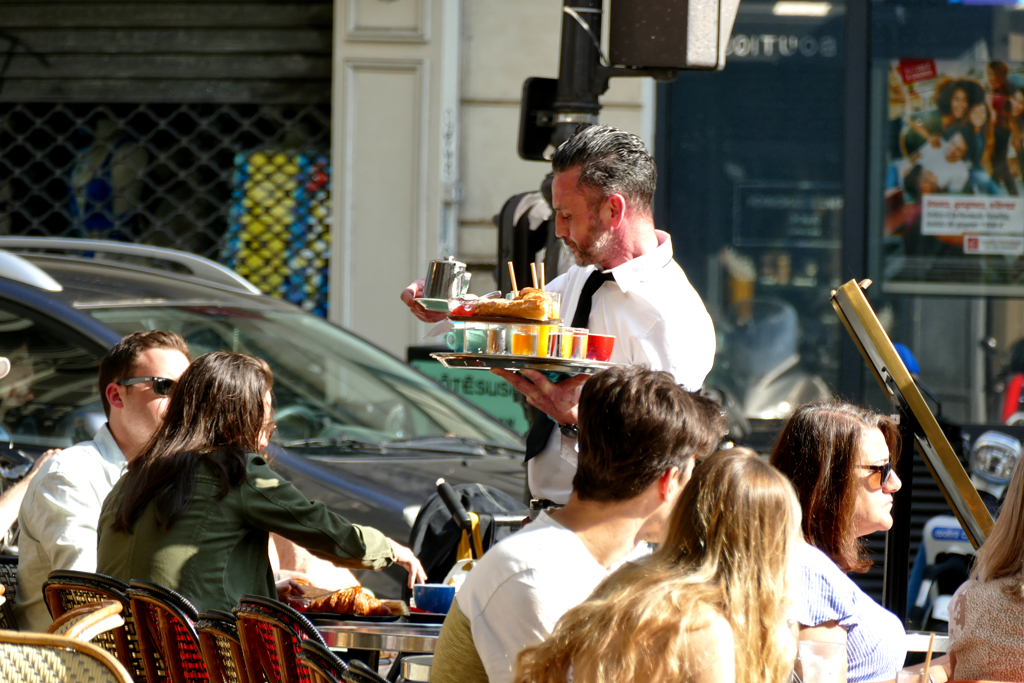
I have no idea where she booked the organized trip. What I definitely know is that such a thing would be unthinkable today, because we traveled to Paris from Hamburg by train. There we stayed in a tiny, somewhat gloomy hotel somewhere near Pigalle. Also, a bus tour was included. One of those where you stare through glass windows and watch the city go by. However, we explored the city most of the time on foot. We visited all the iconic landmarks and we saw all the world-famous paintings. We browsed through the Galeries Lafayette and drank overpriced coffee at the legendary Café de la Paix. It was wonderful in its own quirky way.
A little awkward, but absolutely unforgettable.
A Second Visit
A few years later, by then I was already an older teenager, I went on this infamous Interrail trip with my then-boyfriend. I’ve mentioned some of the slightly wacky shenanigans, for instance, in my post on How I Became A Citizen Of The World. However, Paris had also been on our long list of destinations. It was summer and we had come on a jam-packed night train from Amsterdam. My plan had been to sleep on the train to save money like a hardcore backpacker. In the end, we were lucky we had even seats to sit on, there was no way to lie down and sleep.
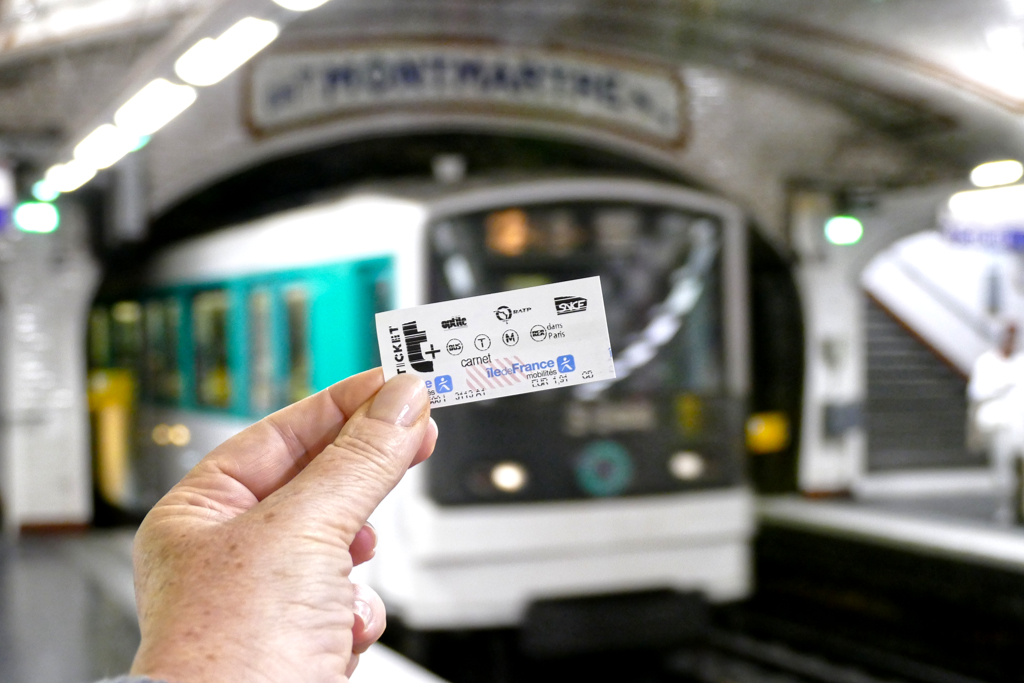
As we got to Paris, we were quite exhausted. Yet, first things first, we purchased a so-called carnet of ten tiny tickets – I love those iconic pieces of carton to this day. Holding my wallet and the tickets and the change, all of a sudden, there were these three little girls in shabby, colorful dresses holding a huge cardboard over my hands, engaging in some weird singsong. I was completely perplexed: What was this spectacle? What did they want?
A Not So Friendly Welcome
As suddenly as they appeared, they were gone. And gone was also my wallet, gone were the tickets, and the change. They had robbed me. I had fallen victim to a classic Parisian tourist scam.
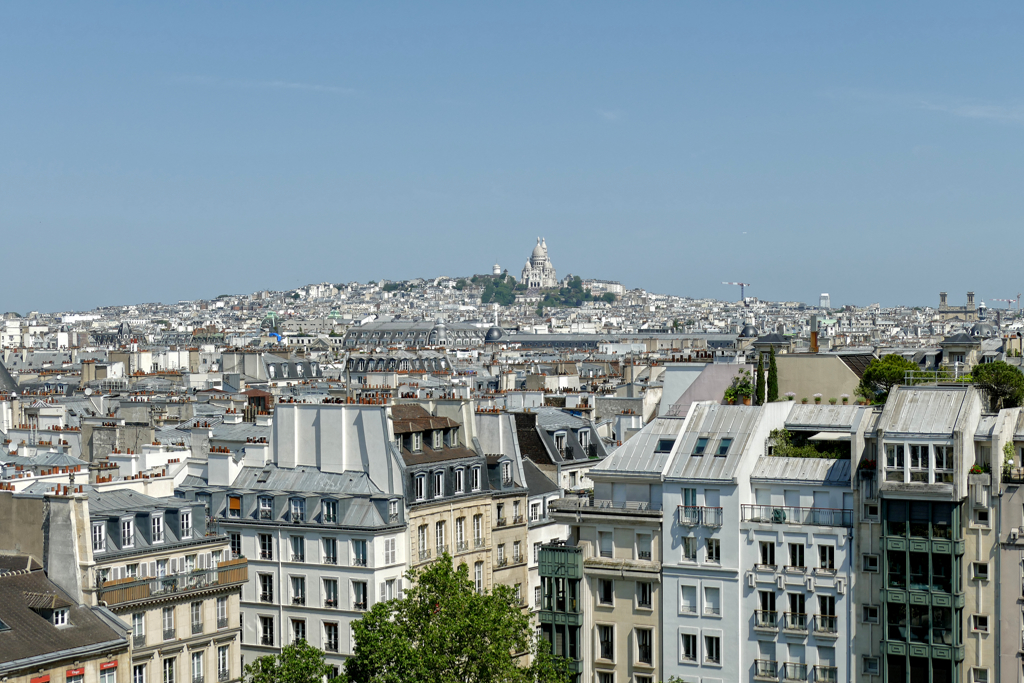
We reported the incident at a police station next to the Bois de Boulogne, where we spent the rest of the day. The next day, we went to see the Eiffel Tower, paid the Mona Lisa a visit at her posh home in the Louvre, and had crêpes and coffee at a street café before we boarded a train at the Gare de Lyon heading for the far less exciting Switzerland.
Today, I cannot even count how many times I have visited Paris since then. And yet the city still manages to captivate me again and again.
We Need to Get the Thrill Back
In the past—and strictly speaking, this past wasn’t that long ago—for many people, travelling was something they saved up for all year. There were no budget airlines, so flying was the exception. There was no internet, so routes and connections were searched for in reference books that were already outdated by the time they went to print. Destinations weren’t constantly at your fingertips. And I have the feeling that we appreciated it more when we actually arrived at those dream destinations and saw the world-famous landmarks in person. Of course, we hadn’t been able to view them from every angle on any platform before finally standing in front of them ourselves.
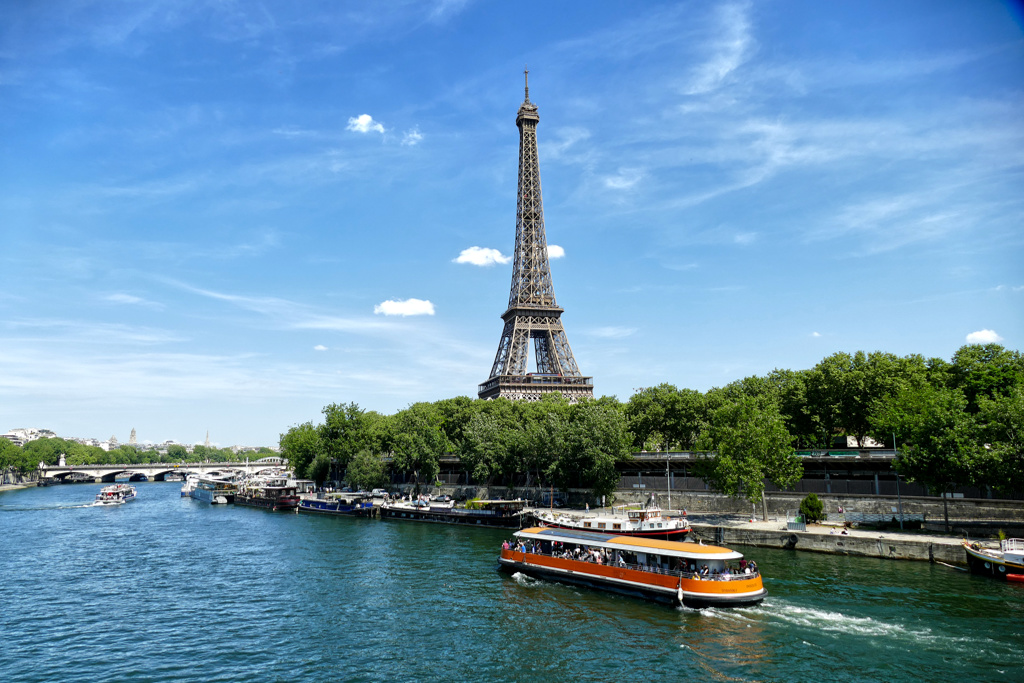
I believe it’s thanks to this constant accessibility, combined with constant presence, that a faster, higher, further approach has become prevalent, especially when travelling, which, to be honest, takes away a lot of the joy. What used to be the goal of our longing is no longer sufficient today. You can hardly entice anyone with the Colosseum or the Taj Mahal these days. And not even the Eiffel Tower, the former symbol of the City of Love and Light. Everyone yawns and shrugs. The alternative now is so-called hidden gems. So hidden that they’re posted on timelines with thousands of views. And first-time visitors to a city? They get left behind in this hype. What’s forgotten is that the hyped icons of a destination made it to the top of to-see lists for good reasons. Namely, because they’re worth it.
It’s Good to Be Back
And that brings me to this post. I’ve compiled a list of what Paris is famous for around the world, for first-time visitors. Whether it’s the Eiffel Tower, the Louvre, or the Sacré-Cœur, all of these places have gained fame because they’re special, unique, and absolutely worth seeing—even if you won’t be a pioneer.
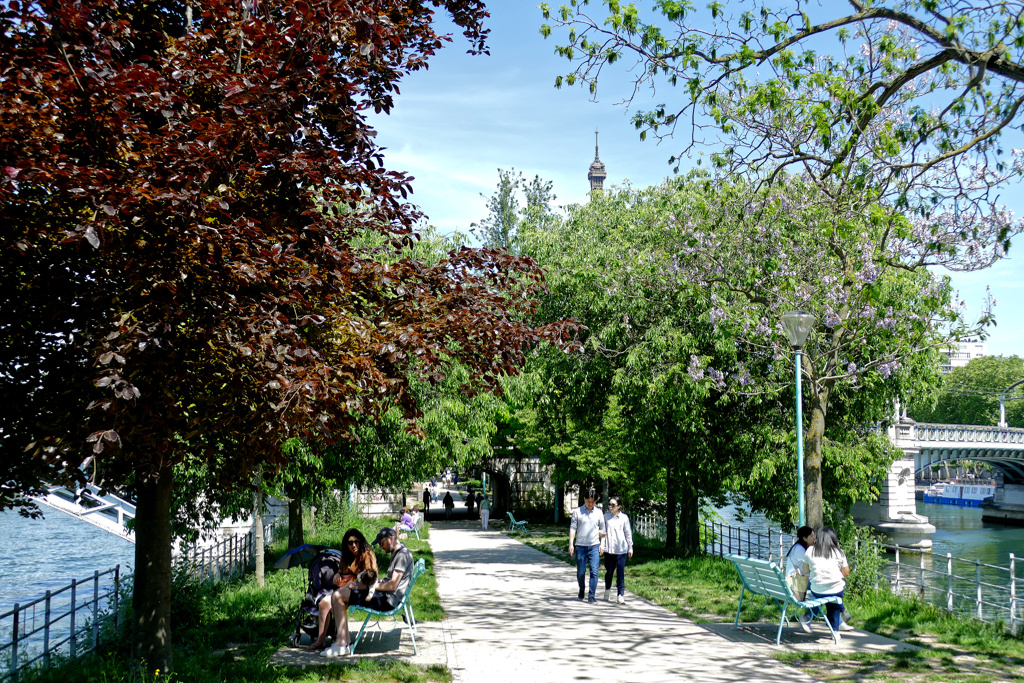
If you’re coming to Paris for the first—or maybe even the second—time, there’s nothing wrong with visiting the usual, unmissable sights. If we are honest, the physical sight overwhelms us even when we have seen the Eiffel Tower, the Louvre, or the Sacré-Cœur a thousand times from all angles on internet platforms.
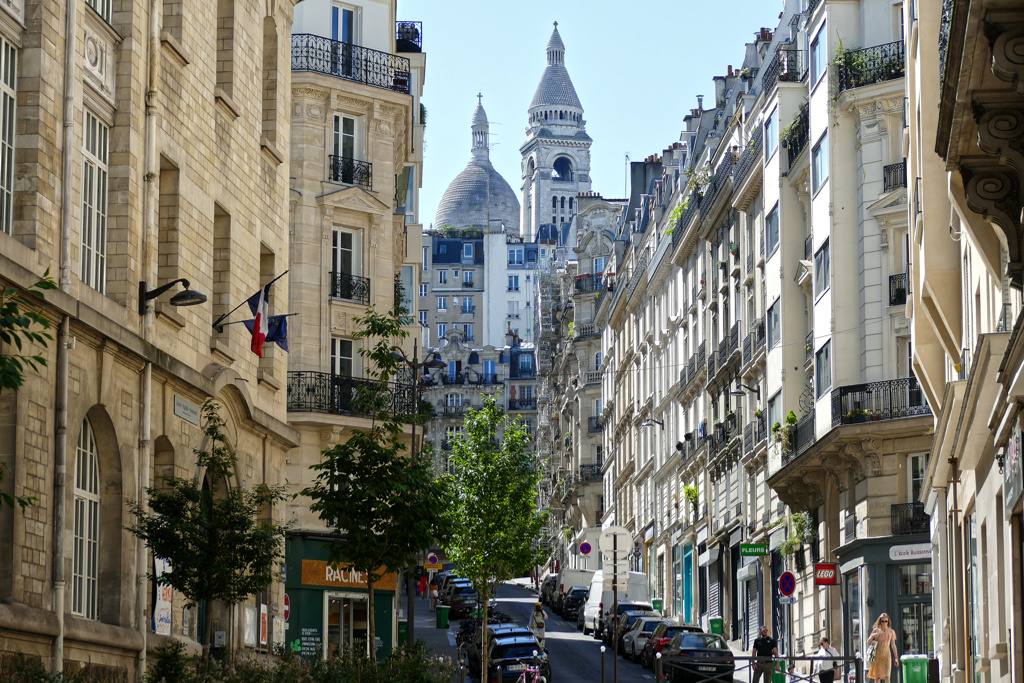
And by the way, even if you’ve been to Paris a hundred times, it can be great fun to go back to all those landmarks and attractions that you have visited for the last time years ago. I know what I’m talking about since I did that just recently for this post. What can I say? Visiting Sacré-Cœur, Père Lachaise, and the Louvre was unexpectedly inspiring and felt wonderful. It was like meeting old friends at a high school reunion.
The Must-Dos of Paris
After compiling my list of all the must-sees in Paris, I came up with 20 spots. Admittedly, that’s a lot. Even if you’re really fast, it’ll take at least five days. Plus, there’s a day trip to the Palace of Versailles, so expect to spend about a week. However, to save time, I’ve grouped the attractions geographically. For example, if you have tickets for the Louvre on one day, you should also visit the Tuileries Garden and the nearby Marais district on that day, instead of traveling across town to the Eiffel Tower or Montmartre. If you stick to my clusters, you’ll save hours, trust me!
While my itinerary is for roughly a week, I don’t assume everyone can spend a whole week in Paris. So you’ll have to choose your very best from my best. I advise you to more or less stick to the clusters in that case.
Of course, there’s much more to see in Paris. The city has around 180 museums, of which I’ll only mention the most important ones here. You’ll find many more in my post PARIS Museum Pass: Skip the Lines and See It All for Less. If you want to experience as much as possible while still saving money, you’ll find many great free activities in my post PARIS for Free!. And if you’re just passing through Paris, my post 24 Hours in Paris will help you make the most of your quick visit.
But now, let’s explore Paris!
Day One
Montmartre
So, where to start? Well, I always begin my visit to Paris in the Montmartre district for a couple of reasons. Firstly, it is very close to the train station Gare du Nord, which connects the city with the airport. If I have an early flight, I don’t need to rush to my hotel and wait to check in. Instead, I can leave my luggage at the storage in the basement of the train station, and off I go.
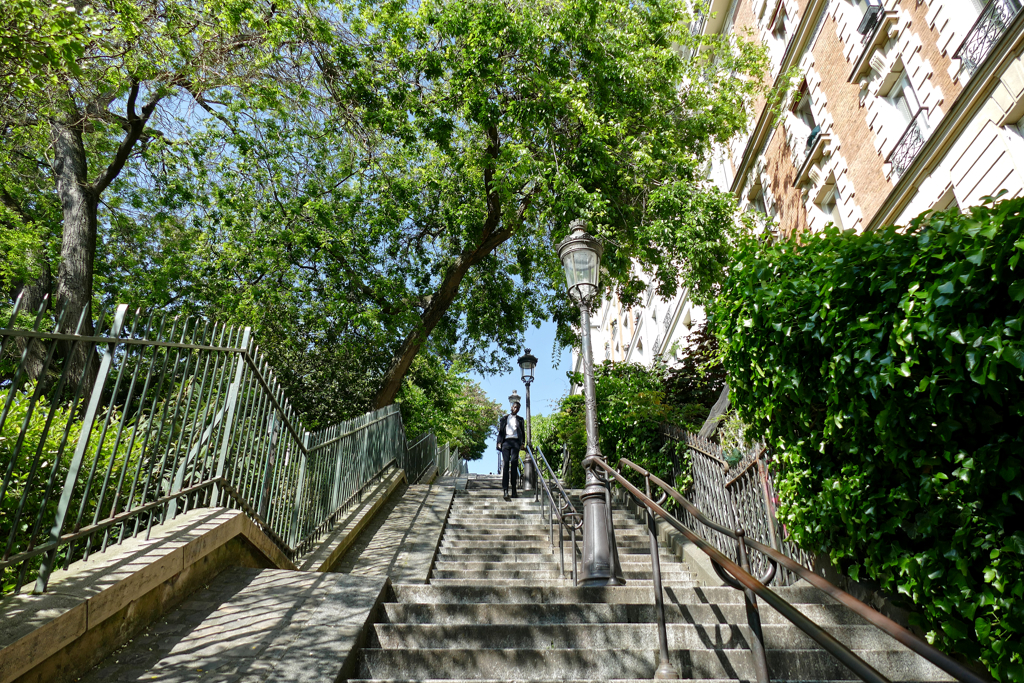
That’s the purely practical aspect. Another reason I think Montmartre is the perfect starting point is that the cobblestone streets winding up and down, the sidewalk cafés, the small, cozy squares—all of it has something iconically Parisian about it. You wander through Montmartre like you’re in an old movie. This is the Paris sung about in chansons.

The entire area is very picturesque and represents everything John and Jane Doe expect to see on their first trip. Therefore, on many days, the alleys are packed with tourists, and the squares turn into a zoo. But honestly, you only have two options. One is to get annoyed and think all this is crap. The other is to ignore the crowds and focus on the essentials: You’re in Paris, it’s beautiful! Enjoy it, man!
Becoming a Myth
Montmartre is, as its name suggests, perched on a hill that today is part of the 18th arrondissement. It became famous as early as the 3rd century AD as the place where Saint Denis, the first bishop of Paris, was martyred by beheading.
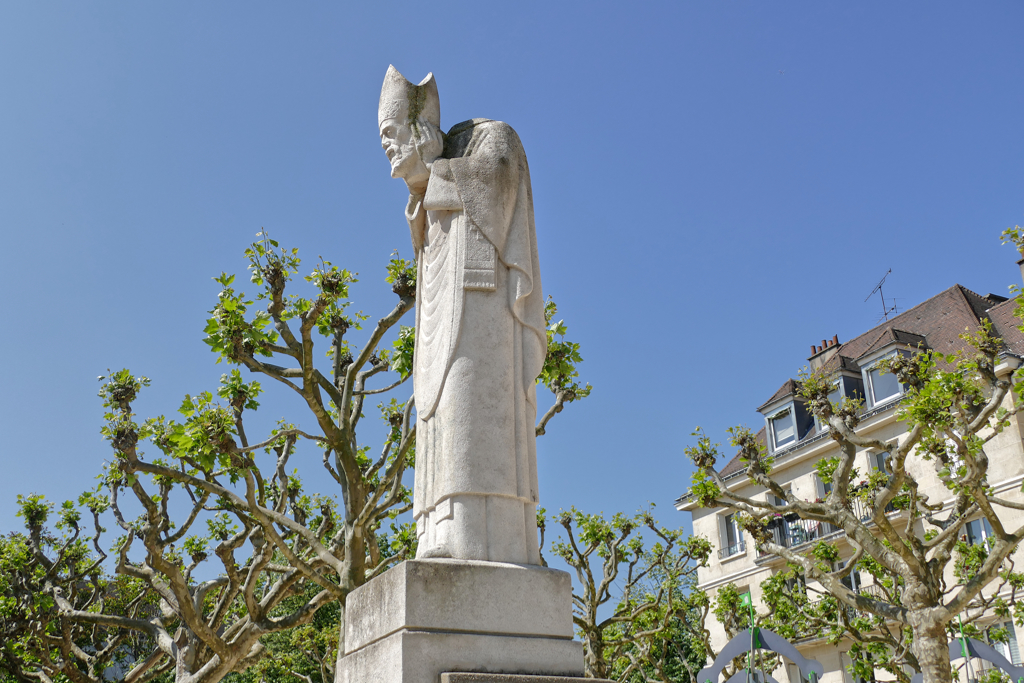
During the Middle Ages and the early modern period, Montmartre was largely a rural village. There were orchards, vineyards, and windmills, but also gypsum quarries. In fact, it was not incorporated into Paris until 1860.
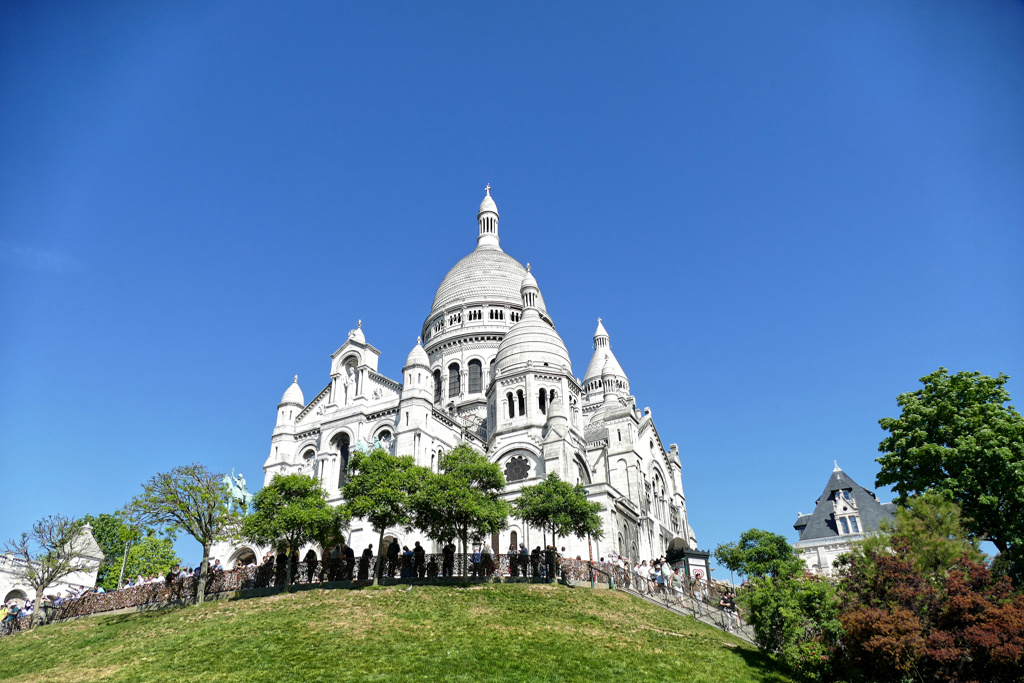
Hosting Legends
In the late 19th and early 20th centuries, the neighborhood became the beating heart of bohemian Paris. Artists such as Picasso, Van Gogh, and Toulouse-Lautrec were drawn here by cheap rents and lively cafés. But most importantly, by an atmosphere that encouraged experimentation and defied convention. There were cabarets and dance halls, most famously the Moulin Rouge and Le Chat Noire.
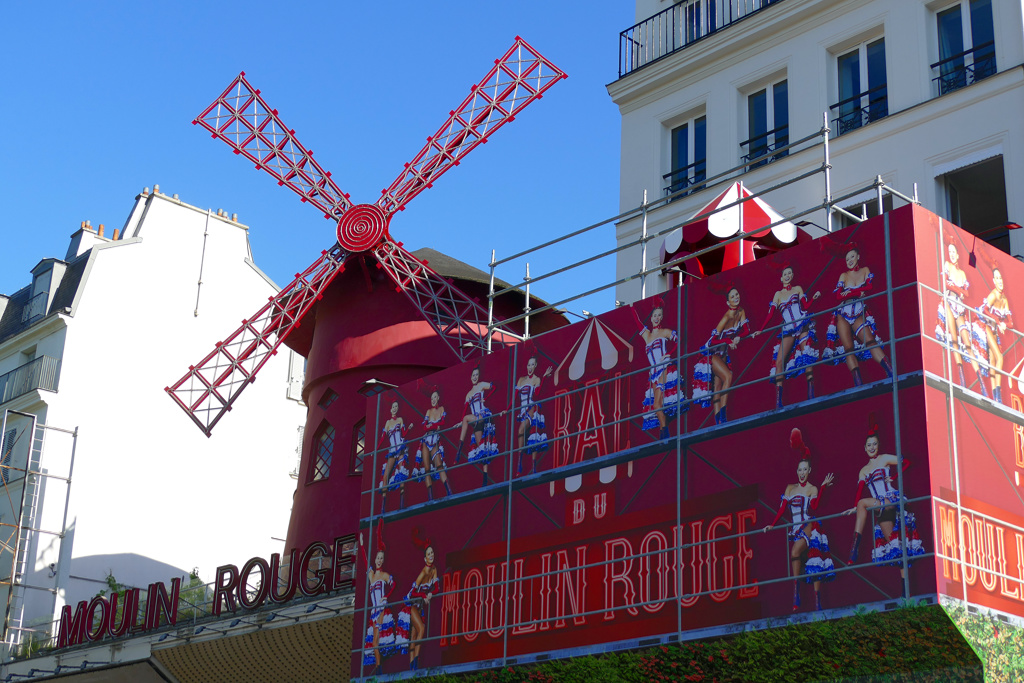
Today, Montmartre still holds onto this artistic spirit, even if it now shares space with souvenir shops and selfie sticks. At its summit stands the gleaming white Basilique du Sacré-Cœur, completed in 1914. Just nearby, Place du Tertre remains a gathering spot for painters who set up their easels. Today, however, they mainly portray tourists.
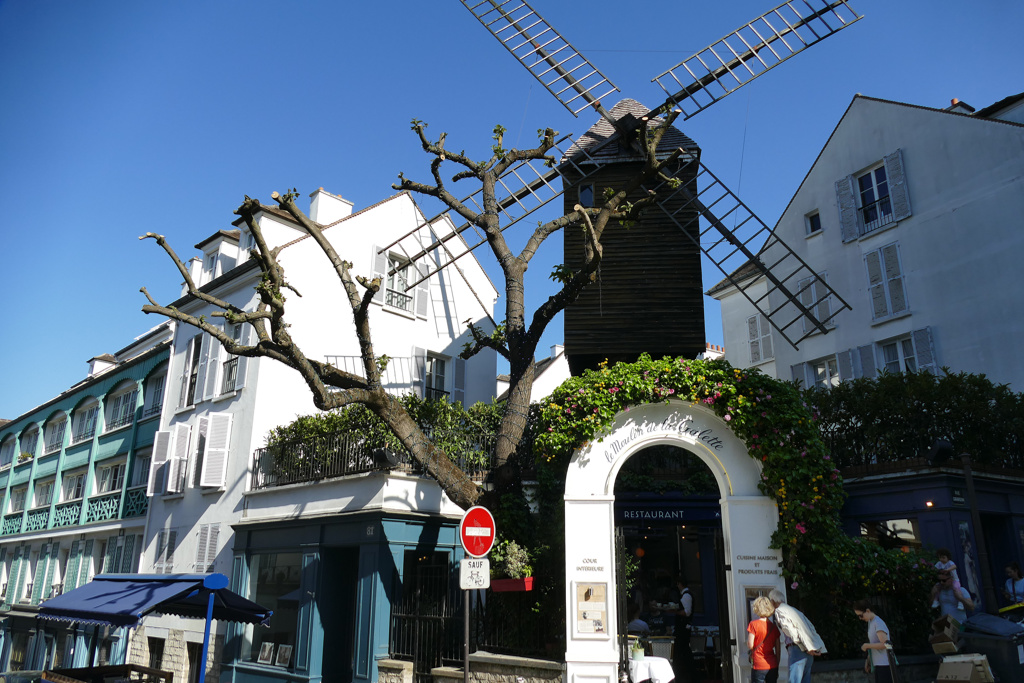
Yet, as you wander a little off the main paths, you’ll discover narrow alleys, steep staircases, hidden gardens, and even a small working vineyard, the Clos Montmartre.
Follow the Fabulous Destiny of Amélie Poulain
Before Emily Cooper made it to Paris, there was Amélie Poulain, and in Montmartre, you can immerse yourself almost entirely in Amélie’s world. The heart of the place is the Café des Deux Moulins on Rue Lepic, where Amélie works in the film.
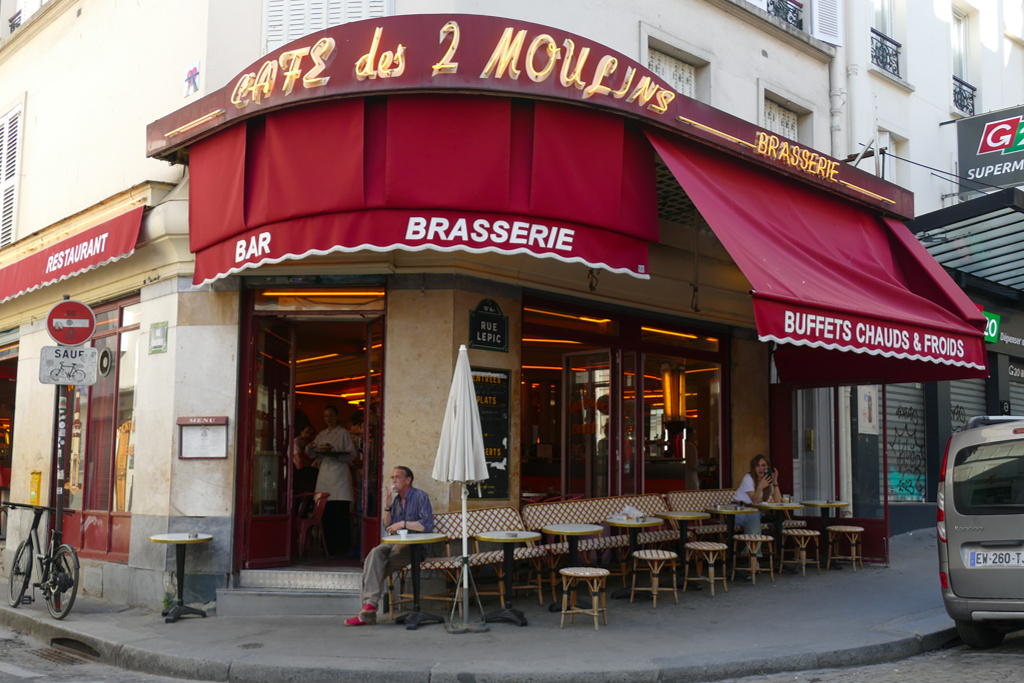
Just a few minutes’ walk away, at the corner of Rue des Trois Frères and Rue Androuet, is the small greengrocer Au Marché de la Butte. In the movie, it is located directly below Amélie’s fictional apartment. From here, you can stroll on to the Lamarck-Caulaincourt metro station, whose characteristic double staircase can be seen in the scene where Amélie describes the market stalls to a blind man.
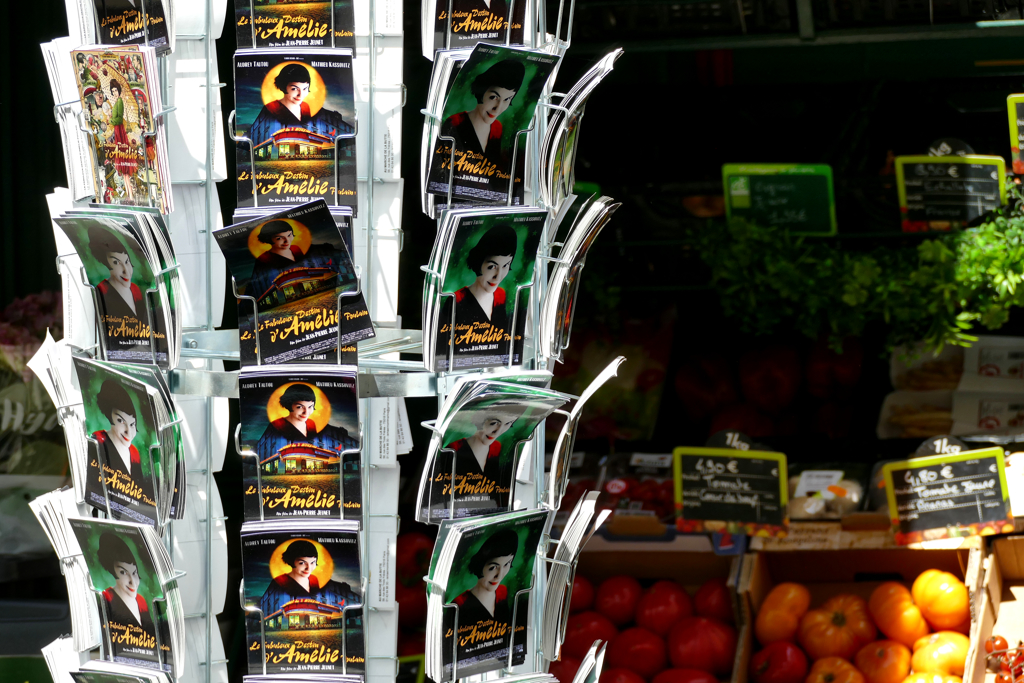
High above sits the Sacré-Cœur Basilica. This is one of the important stops in Amélie’s scavenger hunt with Nino. In the alleys around Place du Tertre and along the winding streets of Montmartre, you’ll discover many little corners that capture the nostalgic, playful charm of the film.
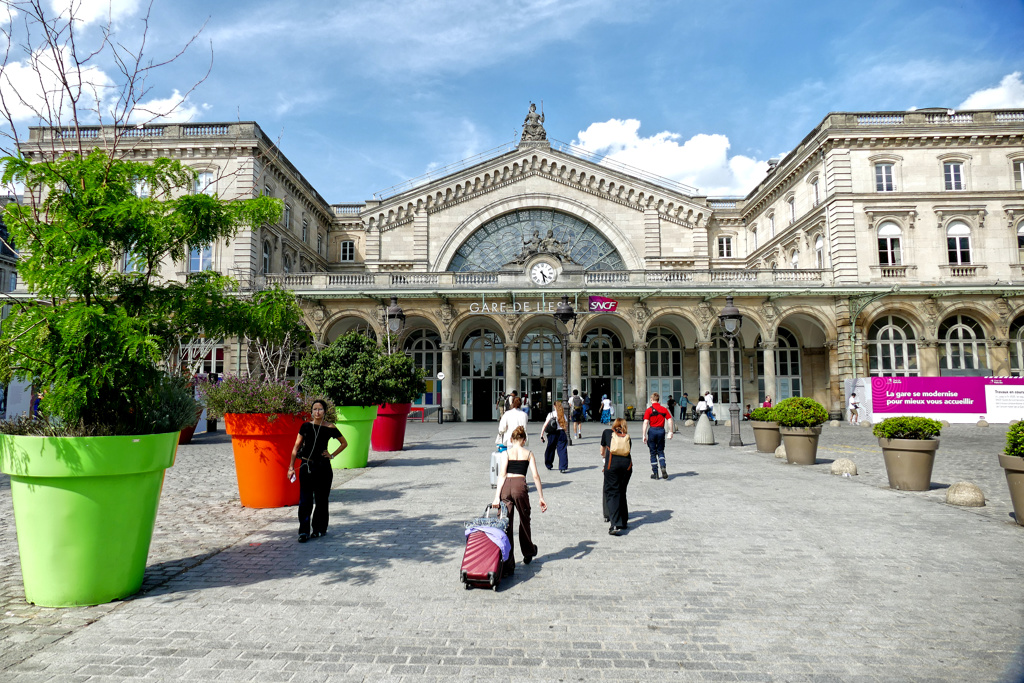
Street Art
Although Montmartre has lost its status as a key meeting place for legendary painters, it still boasts many small, charming works of urban art. For example, there are the mysterious portraits by Sébastien Bouchard.
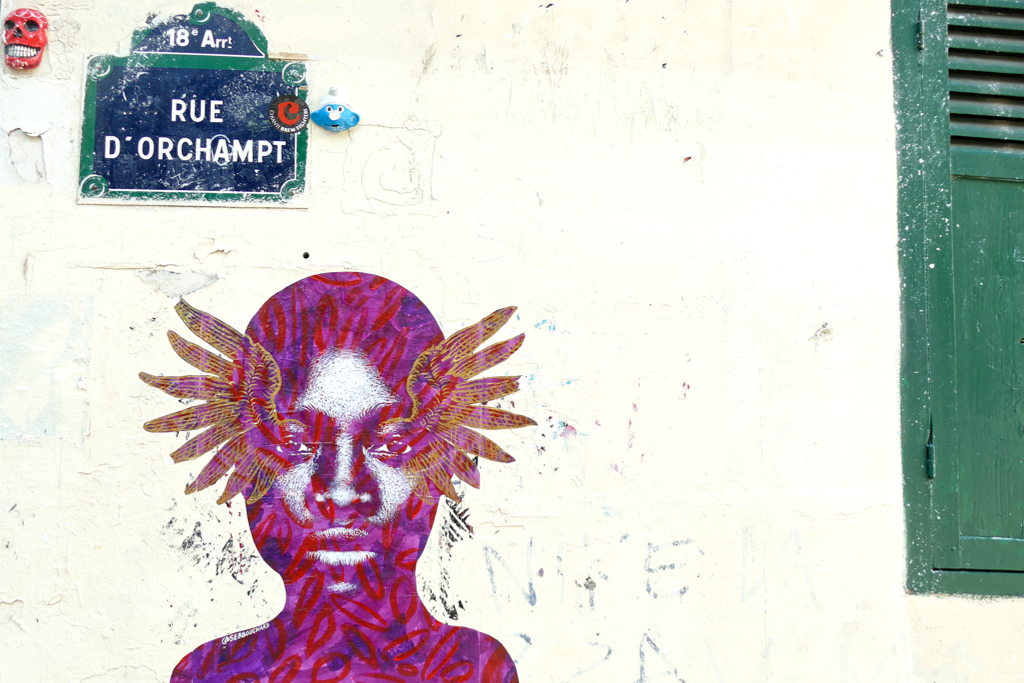
Bouchard was born in Nantes in 1971. With his highly artistic portraits, he wants to bridge the gap between academic art, international folklore, and urban art.
Montmartre’s most iconic work of street art, however, is definitely the so-called Mur des Je t’aime. It translates to I love you wall in English. On the eastern façade of an older apartment building is the lettering I Love You in over 300 variants and 250 languages.
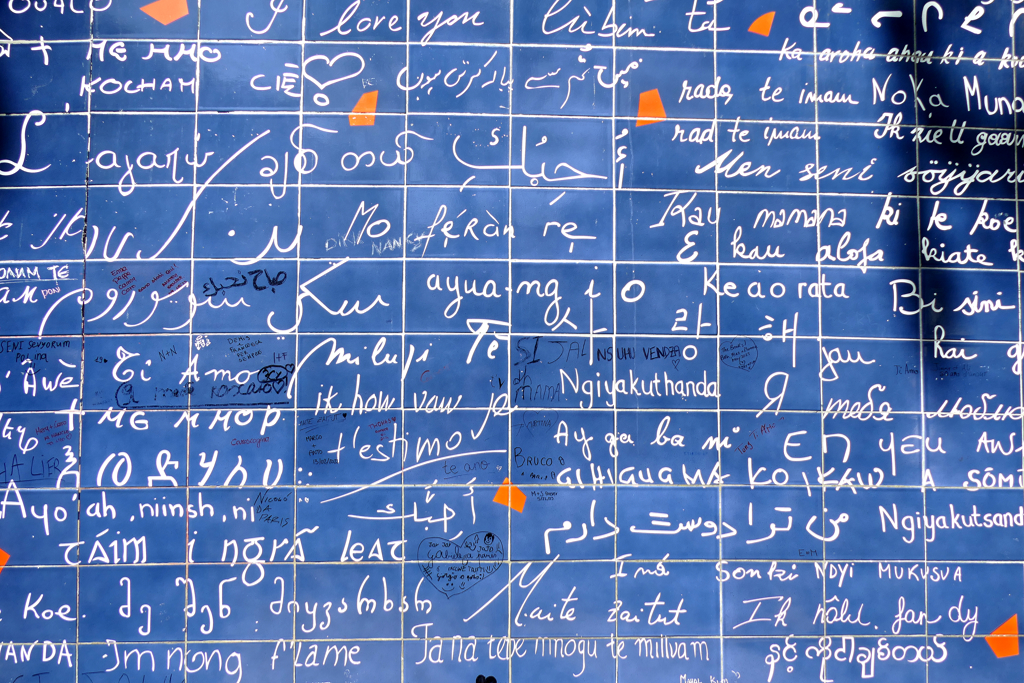
The idea is based on Jules Verne’s journey around the world in 80 days. The initiator, Parisian singer Frédéric Baron, began to collect I Love Yous in 1992. His brother, who was a sailor, brought back new variants from distant countries.
Finally, the wall was created from 612 rectangular, dark blue enameled panels in 2000. Today, the Mur des Je t’aime covers an area of an incredible forty square meters. It can be accessed on weekdays between 8 a.m. and 5.30 p.m. and on weekends only from 9 a.m..
Day Two
Place de la Concorde
We start the second day at one of the most central squares in Paris, from where we visit some of the most iconic landmarks.
The Place de la Concorde is one of Paris’s most famous and historic squares. Covering more than eight hectares, it is the city’s largest square and, along with the Place des Vosges, Place Dauphine, Place Vendôme, and Place des Victoires, one of the five royal squares of the city. However, it is only the second-largest square in France after the Place des Quinconces in Bordeaux.
Witnessing History
Built in the mid-18th century as Place Louis XV, it was later renamed several times. However, its most infamous period came during the French Revolution. This is where the revolutionaries set up the guillotine and executed nobles such as King Louis XVI and Marie Antoinette.
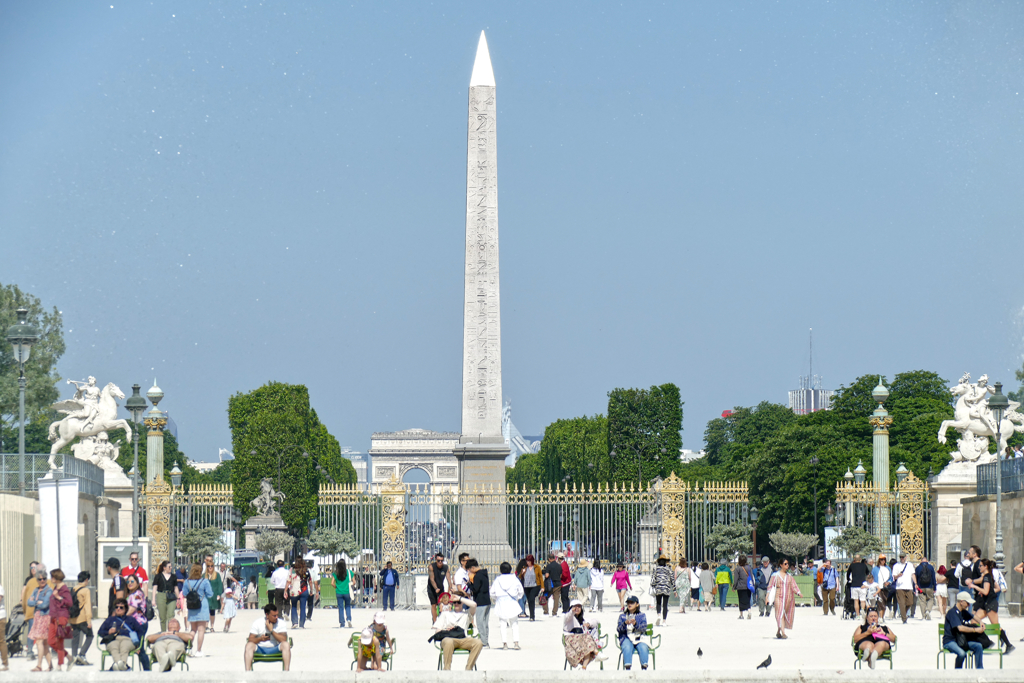
Today, its centerpiece is the striking Obelisk, a 3,300-year-old monument from the Temple of Luxor in Egypt. Elegant neoclassical buildings frame the open space. The view extends in all directions: the Seine and the Assemblée Nationale across the river, the Champs-Élysées to the west, and the Tuileries Garden to the east. This makes the square a perfect vantage point for some of Paris’s most famous views.
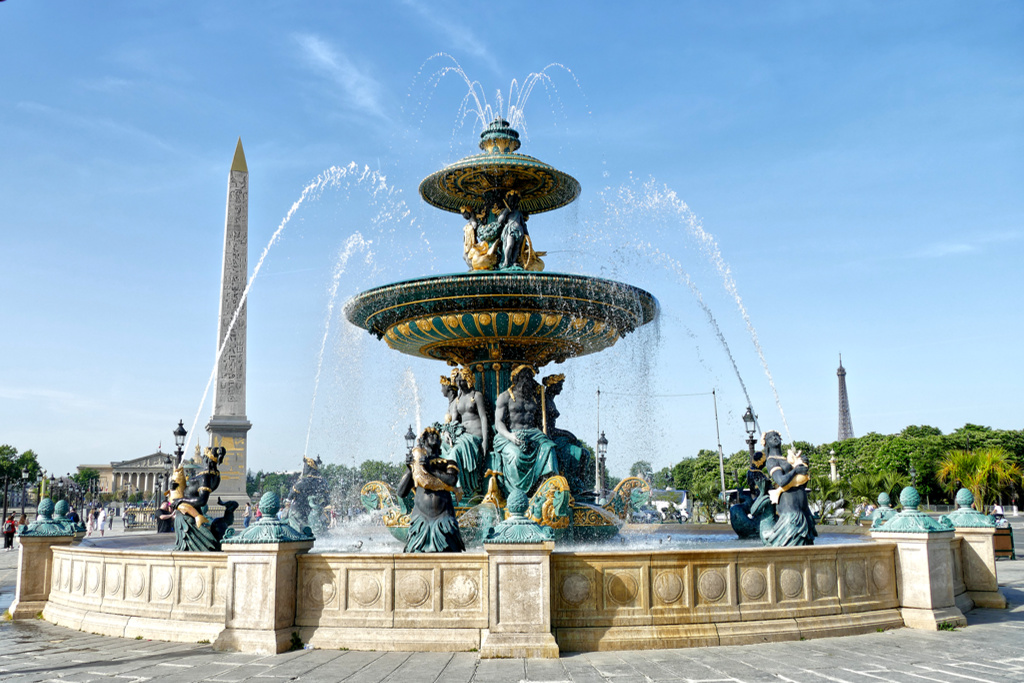
Also, as the square is located at the eastern end of the Champs-Élysées between the Tuileries Garden and the avenue’s tree-lined stretch toward the Arc de Triomphe, it is the perfect starting point for starting at field one, namely by exploring the world-famous treasures of the 1st arrondissement.
Musée de l’Orangerie
Directly at the entrance to the Jardin des Tuileries is the Musée de l’Orangerie.
Originally built in 1852 as a winter quarters for the Tuileries Gardens’ orange trees, it was designed to capture light and heat. During the Third French Republic in the 19th and 20th centuries, the Orangerie was used as a barracks, a warehouse, and an event venue.

In the early 20th century, the Orangerie and its twin building, the Jeu de Paume, were converted into art galleries. In fact, on my very first visit to Paris, the Impressionist paintings now housed in the Musée d’Orsay were on display in the Jeu de Paume.
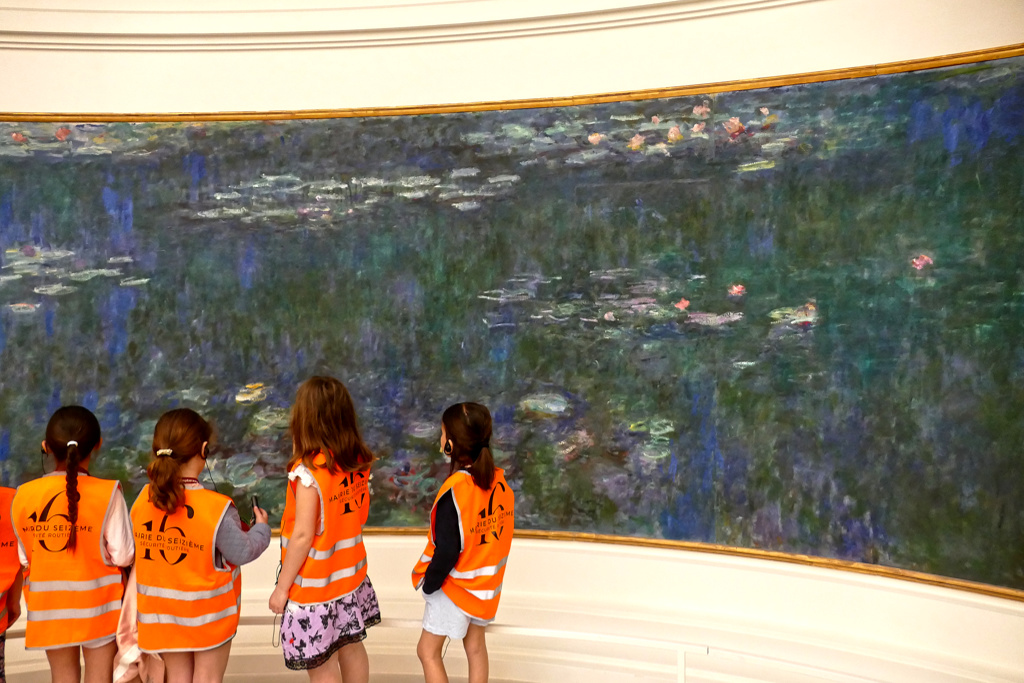
Sistine Chapel of Impressionism
The Orangerie’s most iconic work is undoubtedly Claude Monet’s monumental Water Lilies series. Eight enormous panels are arranged in two oval rooms, which the artist himself conceived as a peaceful oasis for meditation. The French Surrealist André Masson called these water lily displays the Sistine Chapel of Impressionism.
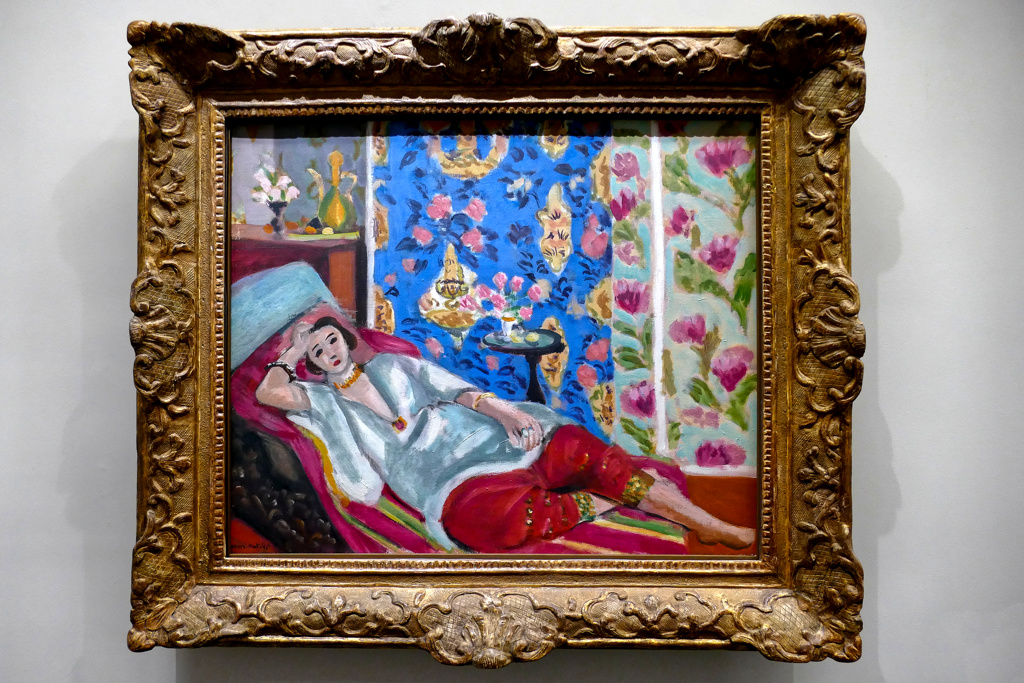
In addition to Monet, the museum houses a remarkable collection of Impressionist and Post-Impressionist works, including paintings by Renoir, Cézanne, Matisse, Picasso, and Modigliani. It thus offers a compact yet comprehensive overview of modern art. Its intimate size, bright rooms, and the tranquil setting of the surrounding gardens make the Orangerie an outstanding place to relish art.
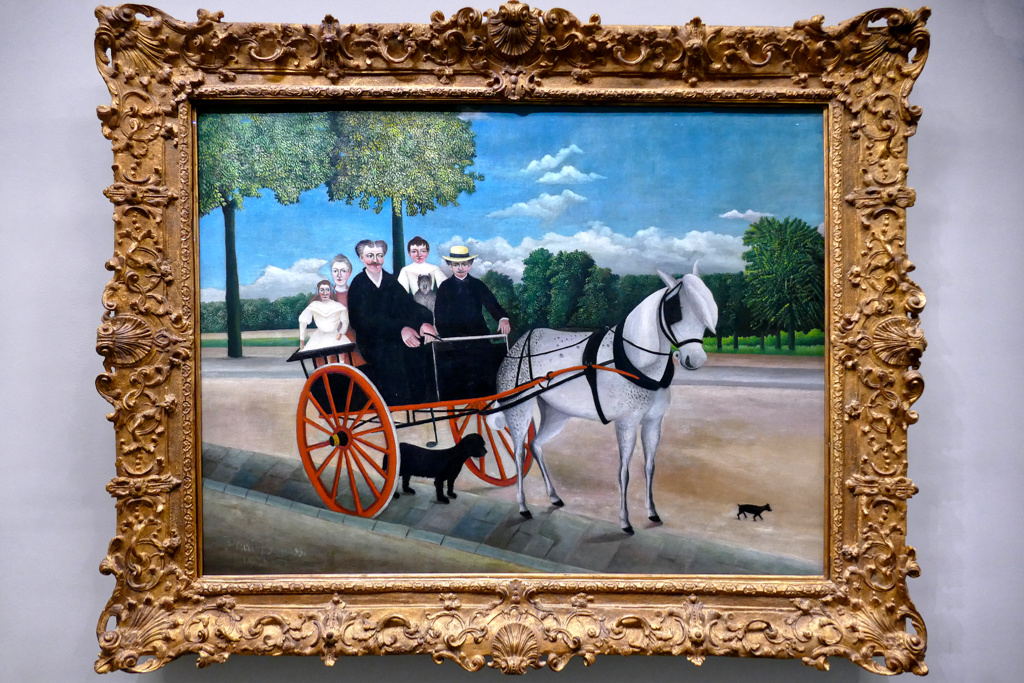
The Musée de l’Orangerie is open from Wednesday to Monday between 9 a.m. and 6 p.m. The general entrance fee is 12.50 €uros. You can buy tickets for reserved time slots on this website*. Even if you happen to have a Paris Museum Pass*, make sure to book a time slot in advance!
Tuileries Garden
Walking from the Musée de l’Orangerie towards the Musée du Louvre, you cross the beautiful Jardin des Tuileries, the Louvre’s former palace park. To me, this is one of the most French icons, and in fact, it has been immortalized in many works of art, such as paintings and also compositions.
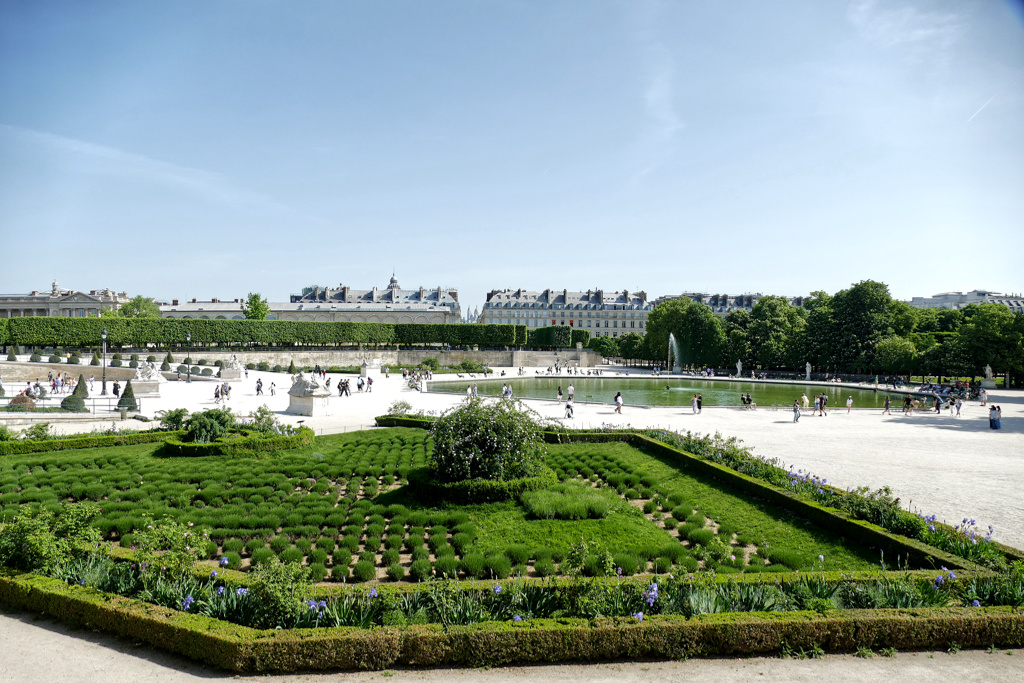
At the time the Palais des Tuileries was built, the western side of the garden was designed in the Italian Renaissance style for Queen Catherine de Medici. She was born in Florence and became a French queen from 1547 to 1559 by marriage to King Henry II. As a matter of fact, the Tuileries remained a private Royal garden until the revolution.
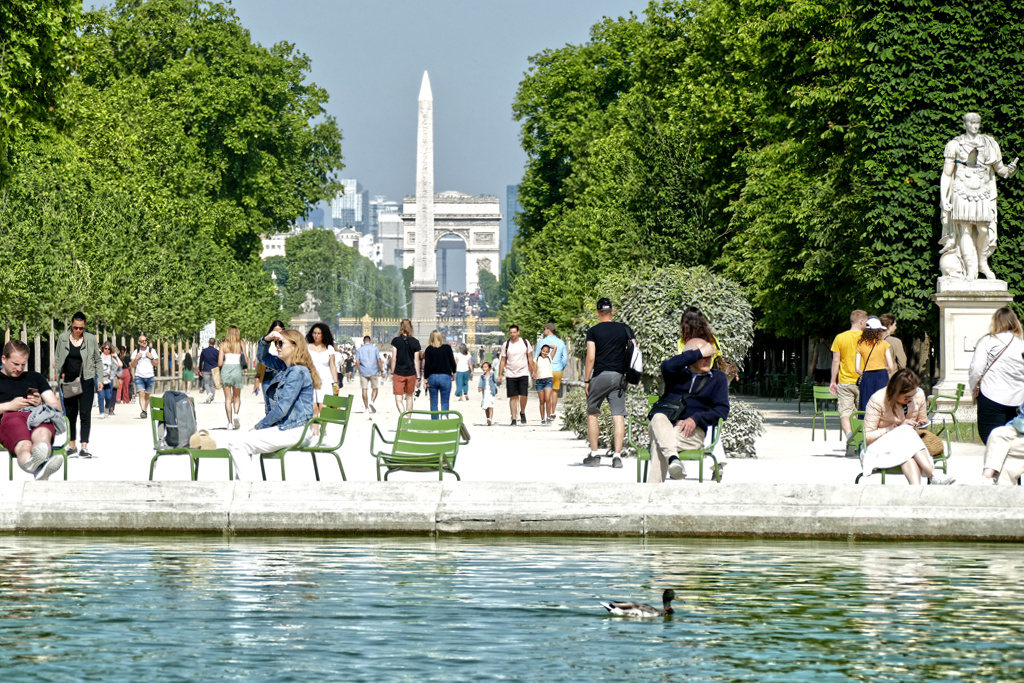
Today, everyone can enjoy the Jardin des Tuileries from 7 a.m. to 9 p.m. It’s a lovely place to stroll among the flowerbeds, statues, and fountains, catching sight of some of Paris’s landmarks in the distance. Or you can relax for a moment on the iconic green chairs surrounding the pools. Just keep an eye on the clock so you don’t miss that time slot for the Louvre, which you hopefully booked in advance!
Musée du Louvre
Yes, the big moment has come, you get to visit what’s probably the world’s most famous museum, the Musée du Louvre. This art museum is housed in the historic Louvre Palace, the former residence of the French kings. Since its opening in 1793, the collection has grown to over 380,000 pieces. However, only about a tenth is on display at a time. A size of almost 73,000 square meters and around 10 million yearly visitors make the Louvre not only the largest but also the most visited art museum in the world.
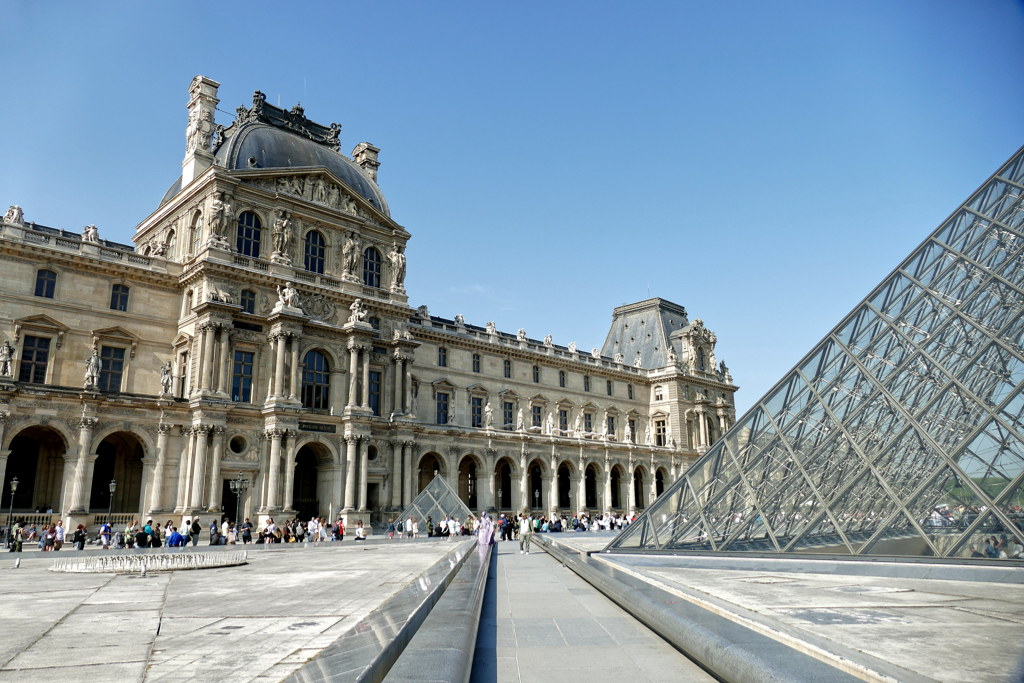
Built in 1190, the building was initially a defensive castle. Eventually, it served numerous governmental purposes. Between the 14th and 18th centuries, it was a royal residence.
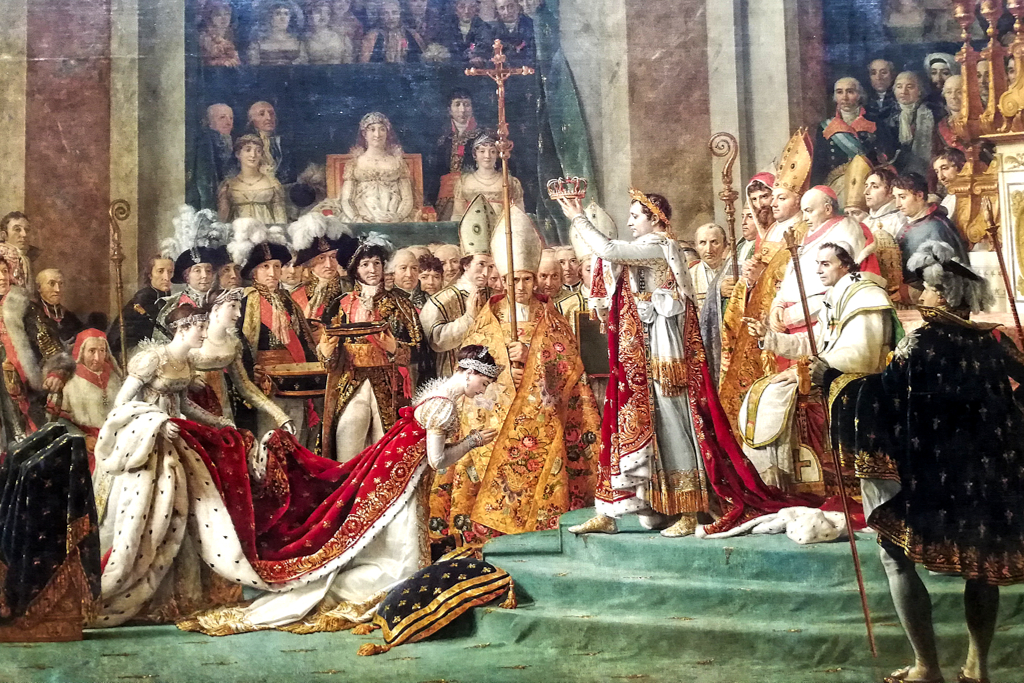
Cardinal Richelieu, who served as a chief minister to Louis XIII, built up a large private collection at state expense. In 1660, about 20 years after Richelieu’s death, the collection moved to the Louvre. Obviously, it was not on public display. Since this was heavily criticized, France’s very first picture gallery was installed in the Palais du Luxembourg in 1750. When Louis XVIII. used the Palais as one of his residences, the gallery was closed in 1779. The works returned to the Louvre depot.
Talkin’ Bout a Revolution
In 1793, in the course of the French Revolution and one year after the abolition of the monarchy, the Louvre was finally opened as a public museum.

This allows visitors to admire some of the world’s most famous works, like the Mona Lisa by Leonardo da Vinci, Wedding Feast at Cana by Paolo Veronese, The Coronation of Napoleon by Jacques-Louis David, and Liberty Leading the People by Eugène Delacroix.
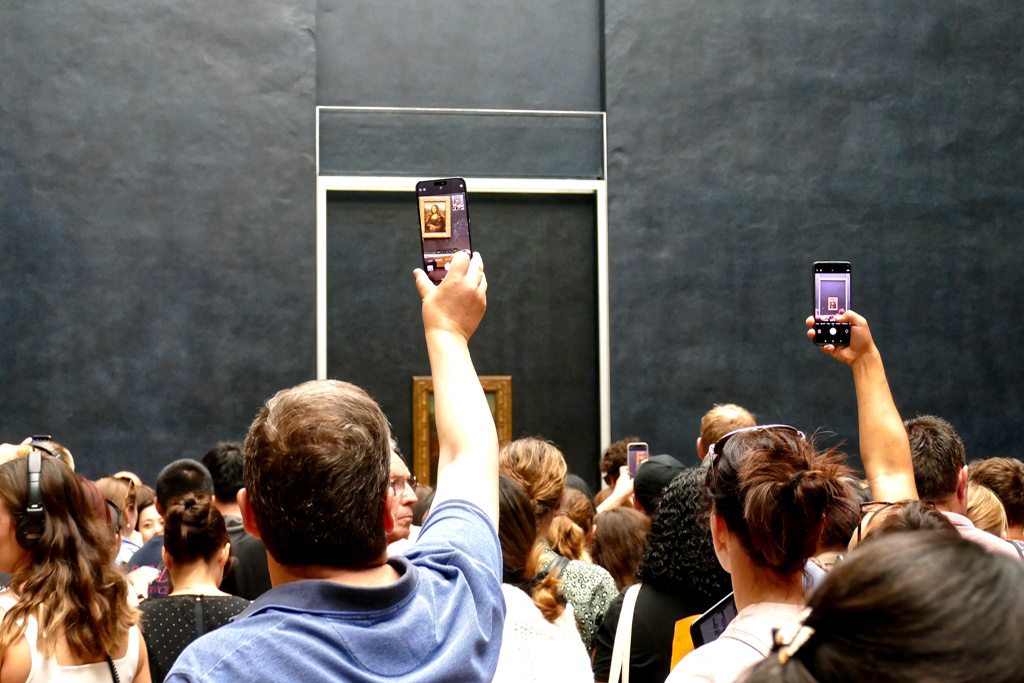
However, there are also amazing sculptures like the Venus de Milo, an ancient Greek sculpture from the Hellenistic period around 150 BC. And this is just a vanishingly small number of the masterpieces you get to admire!
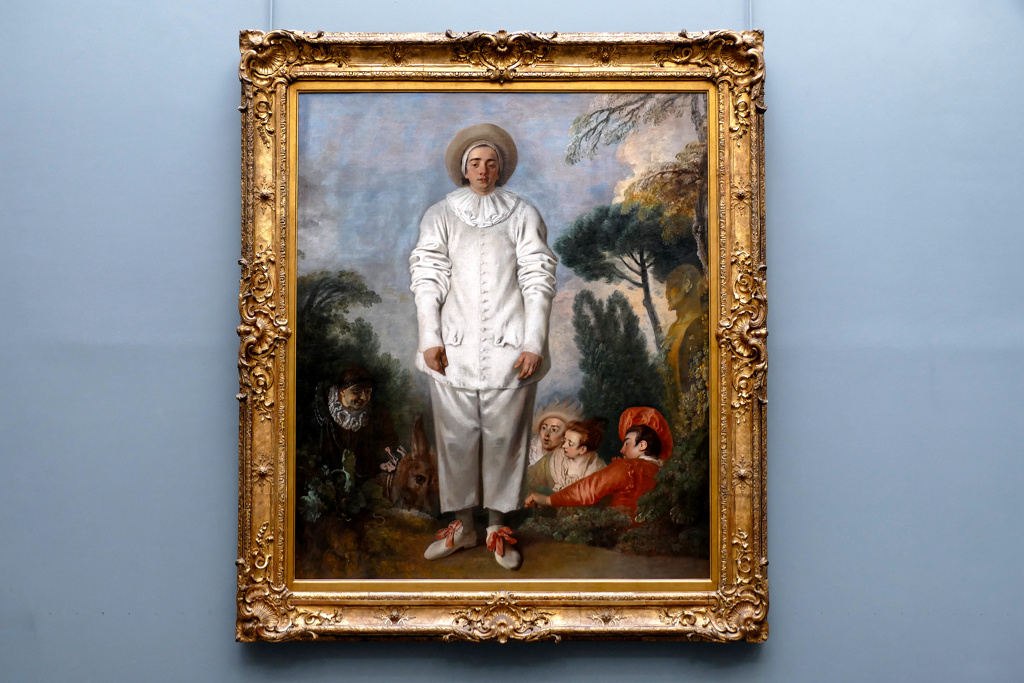
In 1981, President François Mitterrand initiated the so-called Grand Louvre project. Among other measures, the iconic glass pyramid, designed by Ieoh Ming Pei, was installed in the courtyard. It quickly became a famous landmark and serves as the main entrance to the museum. Also, the so-called Carrousel du Louvre opened in 1993. It is a subterranean shopping mall and is directly connected to the museum.
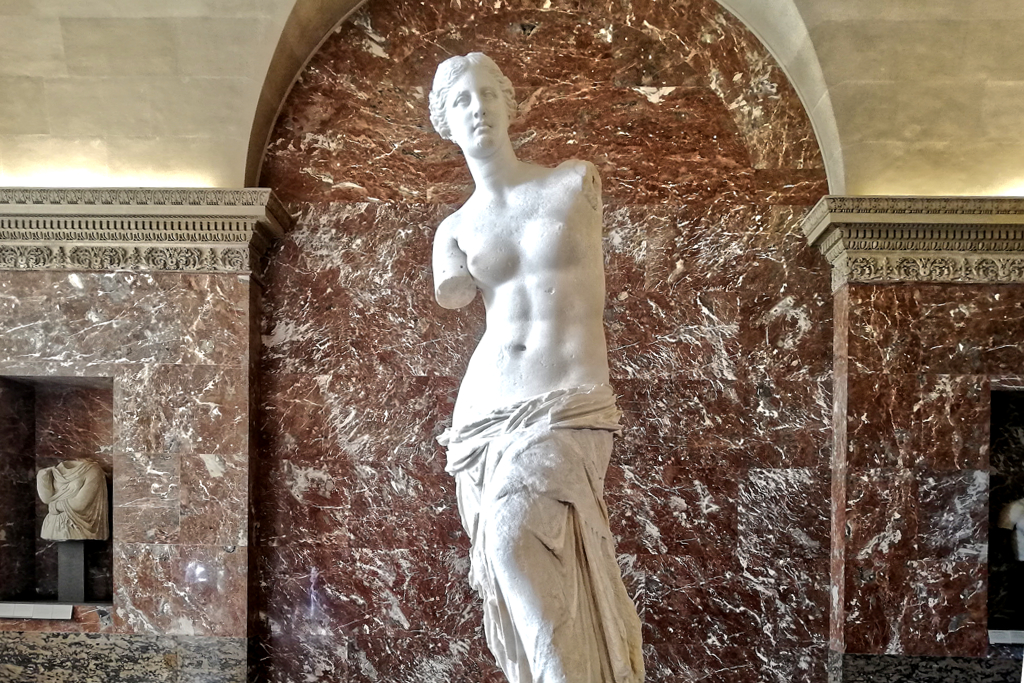
Plan Your Visit
The Musée du Louvre is open from Wednesday to Monday between 9 a.m. and 6 p.m. On Fridays, they are closing only at 9.45 p.m. The general entrance fee is 15 €uros on the spot and 17 €uros if you buy a timed ticket online*.
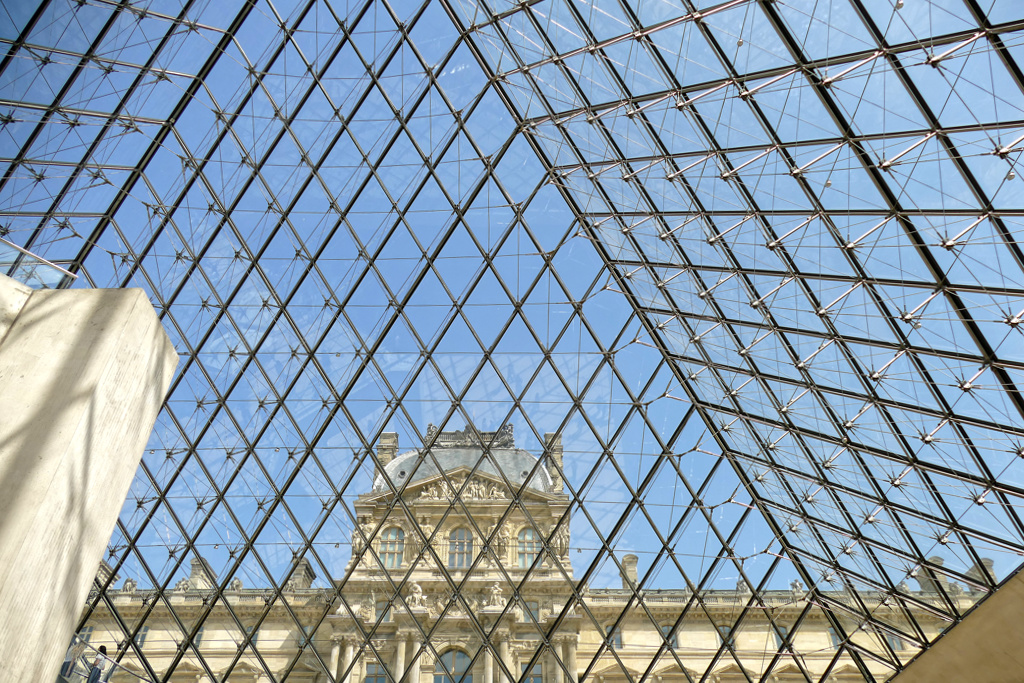
Make sure you book a time slot, preferably weeks before your visit, even if you have a Paris Museum Pass*!
Fun Fact
Not only does the British Museum in London house tons of artifacts looted brought back from more or less peaceful expeditions. The Louvre houses 60 ceramic tiles from the 17th century, which were taken from Istanbul in 1895. French restorer Albert Sorlin-Dorigny worked on the restoration of Hagia Sophia between 1895 and 1899 and took the opportunity to take numerous art treasures as quite precious souvenirs to France without much asking. Perfidiously, he replaced the tiles with replicas made in the Choisy-le-Roi faience factory. However, the Turkish Minister of Culture requested the restitution of the tiles only in 2011.
My Tip
In my post How to Avoid Copyright Infringement: Unexpected Traps, I also mentioned Ieoh Ming Pei’s famous glass pyramid. As a matter of fact, contrary to many other countries, France lacks complete freedom of panorama.
What does that mean?
Well, various French buildings and landmarks are protected by copyright, and commercial reproductions of these, for instance, in pictures, quickly result in copyright infringement.
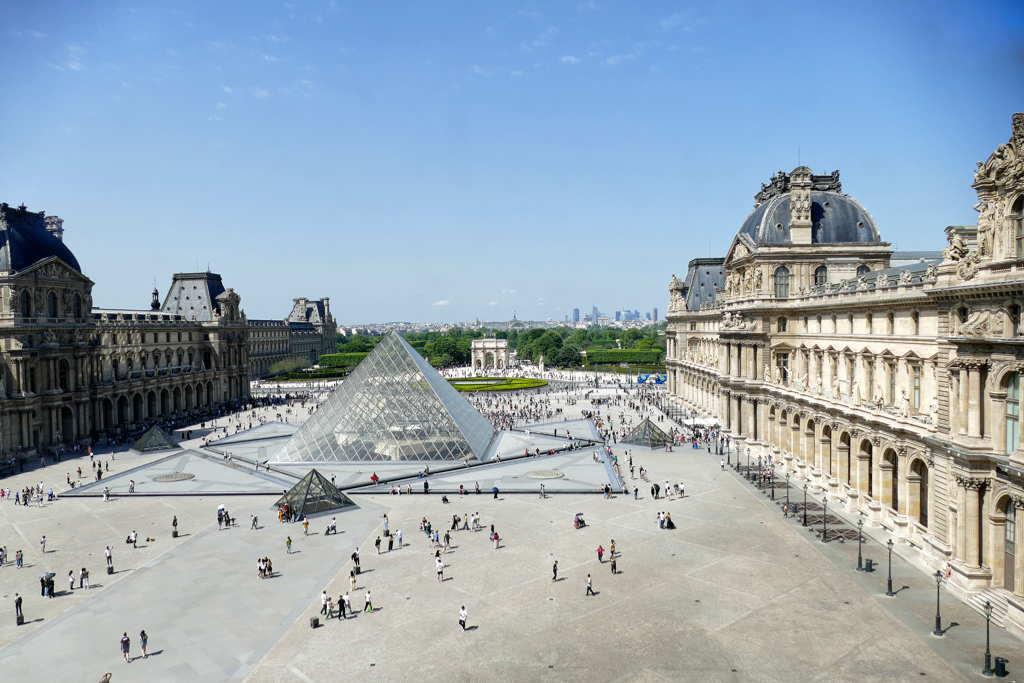
The Musée du Louvre holds the copyright of the pyramid. If the publication of your pictures violates their rights depends on your shot: If it’s taken from afar so that the pyramid is just a part of your motif, you should be fine. However, it should not be your picture’s main subject.
If you want to post a close-up of the pyramid, you should send an inquiry to the press department of the Louvre. They will then decide on the permissions for publishing.
Le Marais
The history of the Marais is a layered story that mirrors Paris’ evolution. Its name, meaning the marsh, recalls its origins as a swampy area on the right bank of the Seine. It was then gradually drained and cultivated during the Middle Ages. By the 14th century, religious orders began building monasteries and churches in the area. Eventually, the district’s fortunes rose dramatically in the late 16th and early 17th centuries, when French aristocrats and royal officials chose it for their grand hôtels particuliers. Actually, I’m getting into details of this era in my post 10 Most Beautiful Palaces in the Marais Neighborhood of Paris.
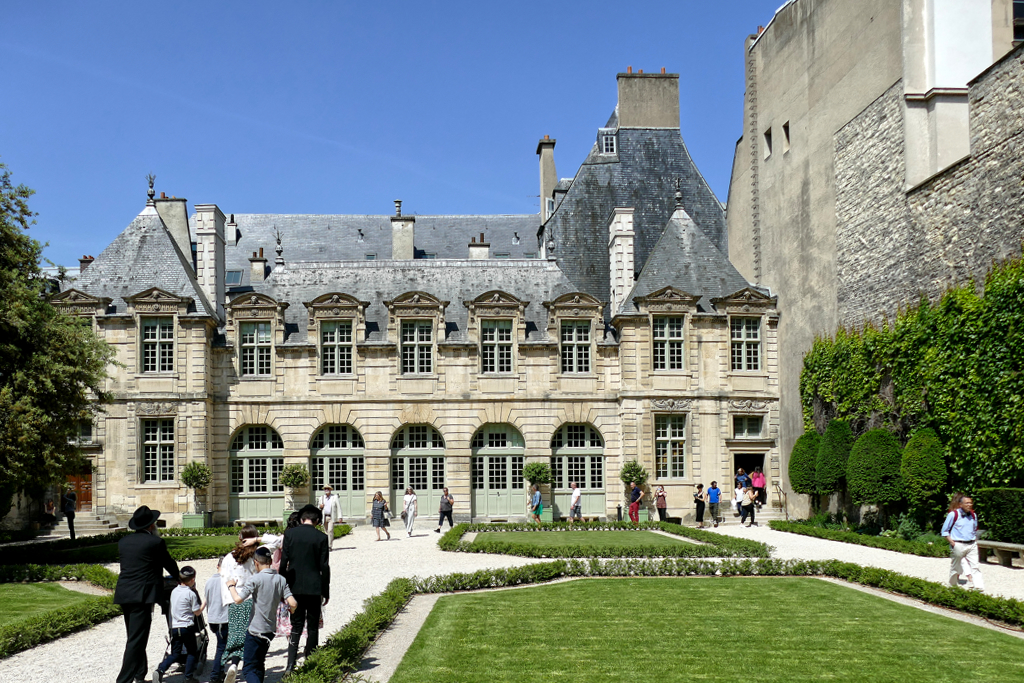
The heart of the district is the graceful Place des Vosges, the oldest planned square in Paris. The construction of the square under King Henri IV in 1612 cemented the Marais as one of the city’s most prestigious addresses. However, by the late 18th century, the nobility had moved west toward areas like Faubourg Saint-Honoré. Thus, the Marais entered a period of decline.
Risen From the Ashes
In the 19th and early 20th centuries, it became home to working-class residents. In addition, a Jewish community, especially from Eastern Europe, thrived here.
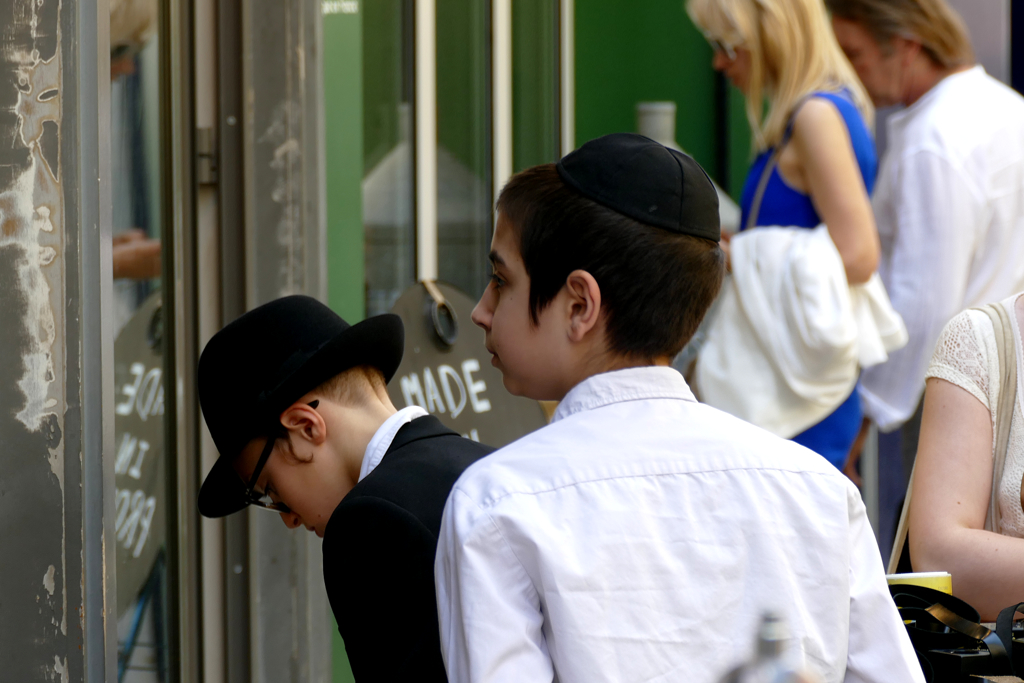
After World War II, many of its historic buildings fell into disrepair. Yet, in the 1960s, a major preservation push saved the Marais from demolition, restoring its architecture and reviving it as a fashionable and culturally rich neighborhood.
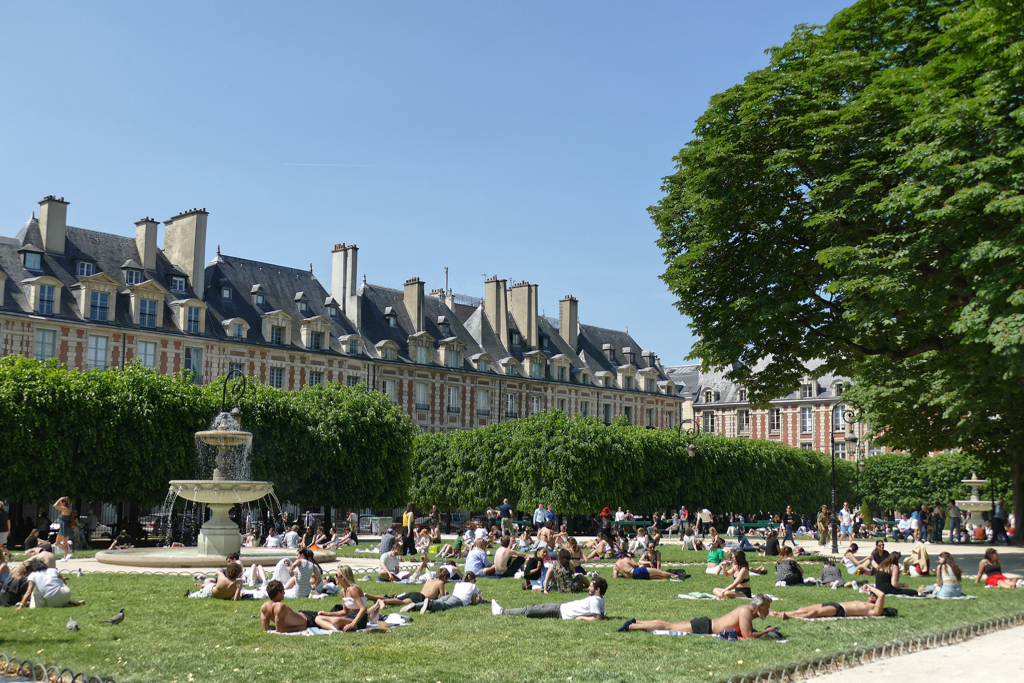
Today, the Marais district is one of the city’s most atmospheric neighborhoods. It is a tapestry of cobblestone streets, Jewish bookstores, aristocratic mansions, and Falafel eateries. Strolling through its narrow lanes, you’re never far from a hidden garden, a centuries-old doorway, or a café terrace perfect for lingering.
Centre National d’Art et de Culture Georges-Pompidou
Just west of the Marais lies the former so-called belly of Paris. Before redevelopment in the mid-20th century, this was part of the old Les Halles district. It was a bustling labyrinth of food markets and wholesale stalls. For centuries, bakers, butchers, fishmongers, and farmers from all over France brought their goods to Les Halles to supply the city. Then, the standard market was demolished and relocated to Rungis on the outskirts of the city, leaving a gap in the urban fabric. In the 1970s, the area underwent a major redevelopment.
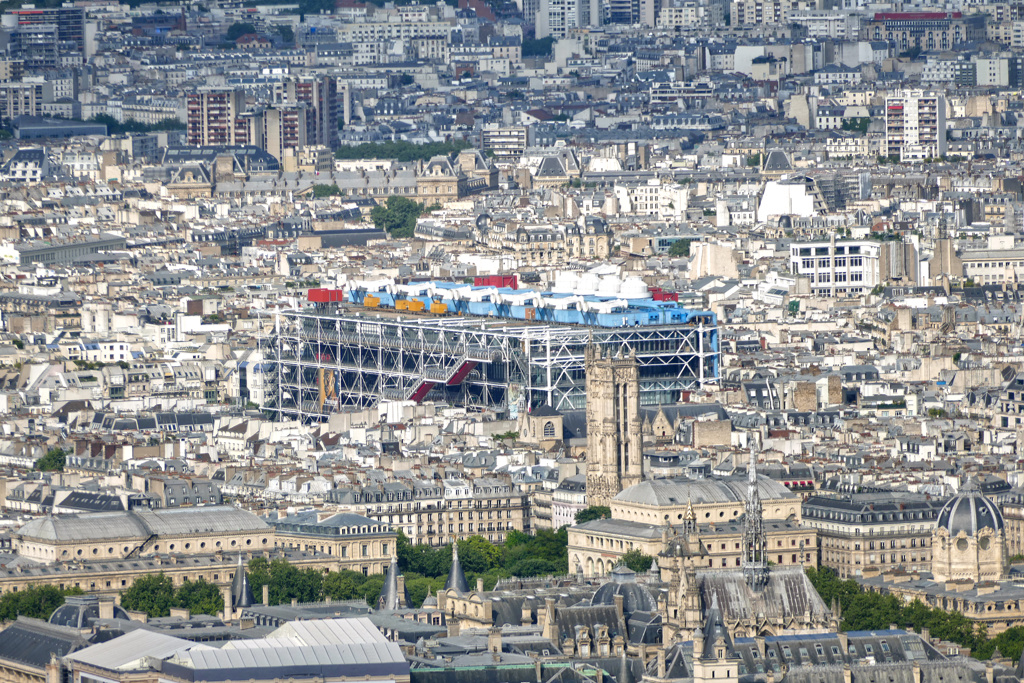
The construction of the modern Forum des Halles shopping center breathed new life into the district. Here, the energy of the old market blends with a spirit of creativity and constant reinvention. Just a short walk east takes you to the Centre National d’Art et de Culture Georges-Pompidou.
Unique Structure
At the initiative of former President Georges Pompidou, architects Renzo Piano, Richard Rogers, and Gianfranco Franchini designed the arts and culture center, which opened in 1977. The supporting structure and piping were visibly arranged on the exterior of the building. The supporting structure and ventilation pipes are painted white, everything related to electricity is yellow, the water pipes are green, the air conditioning pipes are blue, and everything related to movement, such as stairs and escalators, is red. This leaves the interior spaces largely open and more versatile.

In the squares surrounding the Centre Pompidou, artists and small-scale performers demonstrate their skills. The surrounding streets are lined with cafes, bookstores, and chic boutiques.
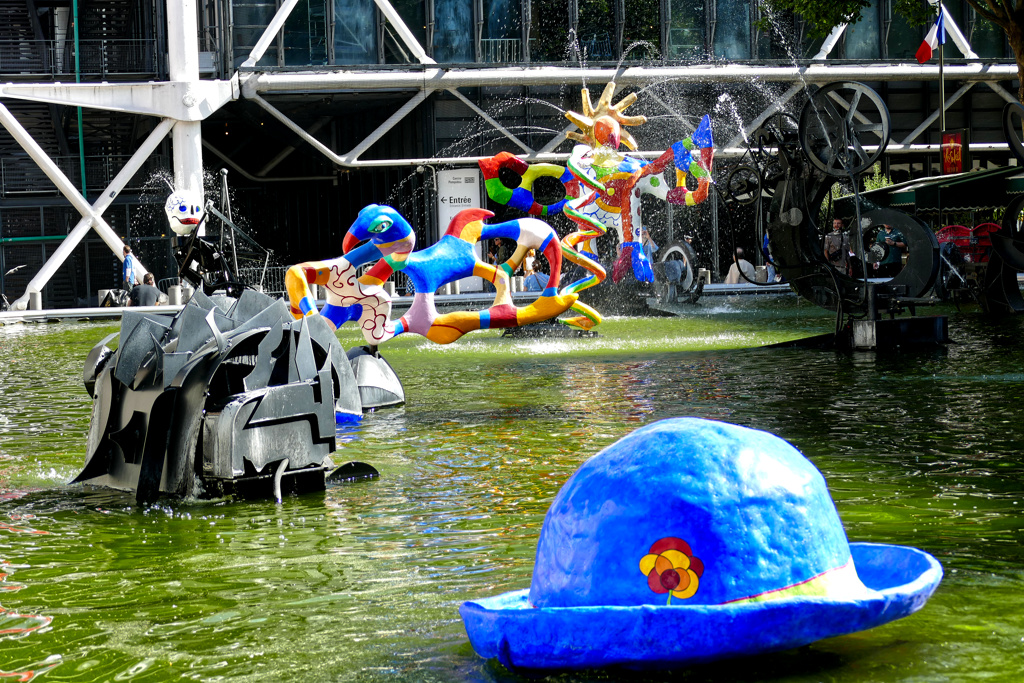
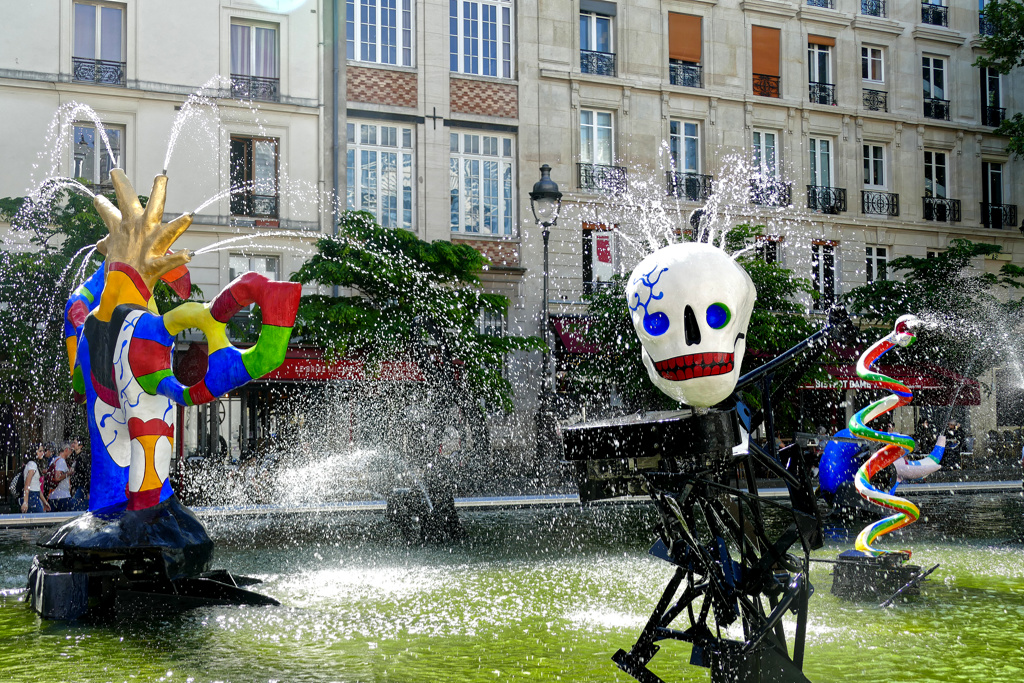
It features 16 colorful, moving sculptures inspired by the music of Igor Stravinsky.
Knowledge And Fun For Everyone
The Center Pompidou aims to grant free access to knowledge. It houses the library Bibliothèque Publique d’Information, the music research center Institut de Recherche et Coordination Acoustique/Musique IRCAM, a children’s workshop, a cinema, a theater, and lecture halls. The most important venue, however, is the Musée National d’Art Moderne, showing momentous works of art from the 20th century.
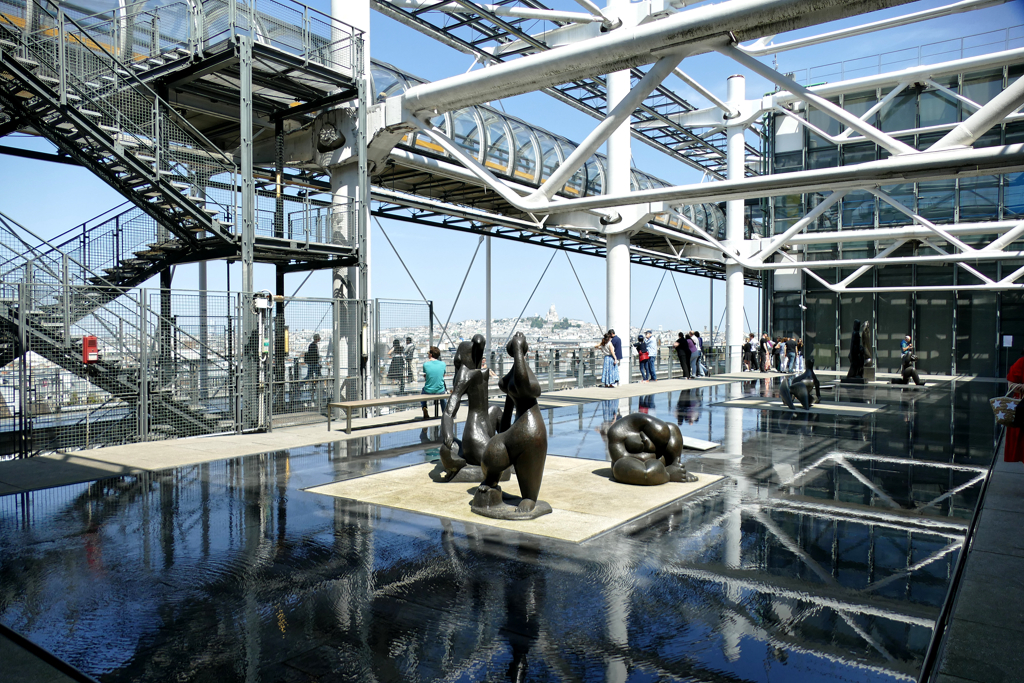
Also, there is a restaurant and a café as well as a huge bookshop. By the way, that’s a great place if you are looking for original and meaningful souvenirs from Paris.

In 2010, the Center Pompidou-Metz was opened in a building designed by Japanese architect Shigeru Banas as the first branch outside of Paris. Since 2015, there has been another branch in the Spanish city of Málaga showing around 90 masterpieces from the Parisian Musée National d’Art Moderne.
From 11 a.m. to 9 p.m., the entrance to the building is free of charge. On Thursdays, the museum is open until 11 p.m. The general admission to the Musée National d’Art Moderne is 15 €uros for the permanent collection and an additional 2 €uros if you also want to visit the temporary exhibitions.
Day Three
Arc de Triomphe
I think it’s a good plan to begin this day by climbing up to the top of the Arc de Triomphe de l’Étoile, Paris’ triumphal arch located in the center of Place Charles de Gaulle. No fewer than 12 boulevards run from this square in all directions.
The Arc de Triomphe de l’Étoile was commissioned by Emperor Napoleon I after the Battle of Austerlitz to celebrate his victories in 1806. Construction was finished in 1836. Beneath the arch lies the so-called Tomb of the Unknown Soldier. An Eternal Flame is burning in memory of the unidentified soldiers who fell in WWI.
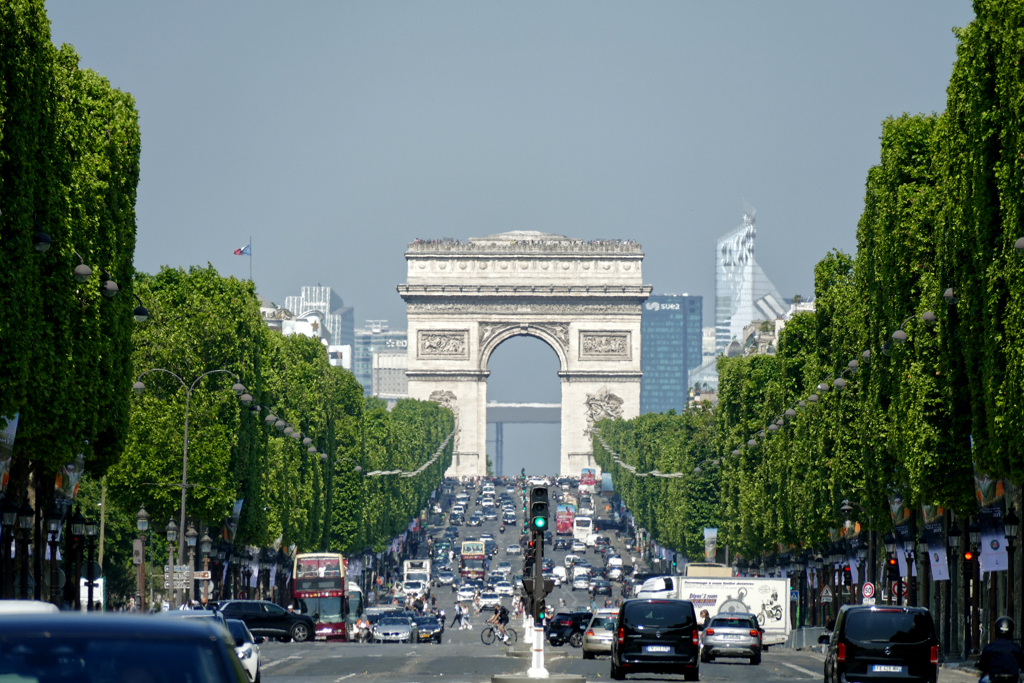
As I pointed out above, the Arc de Triomphe stands at the crossing of 12 roads in the center of some very busy roundabout traffic. And yet, you can spot people running like crazy across the road instead of comfortably crossing through the underpasses below the road.
Please, don’t be one of them.
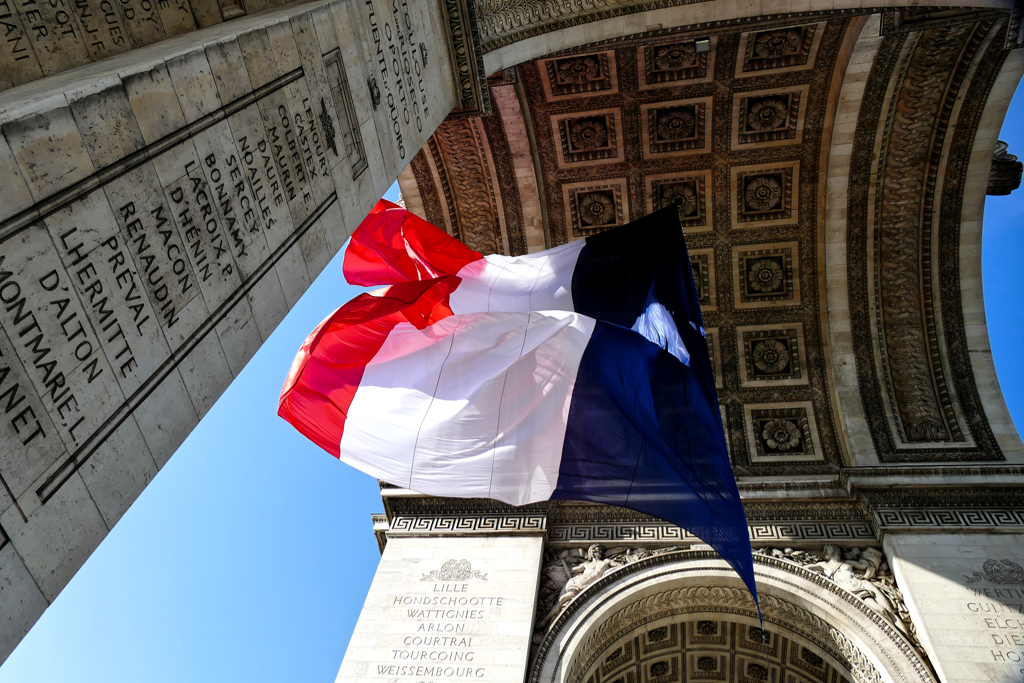
Obviously, the arch has a viewing platform at a height of 50 meters from where you have fantastic views of all of Paris – from Sacré-Cœur down the Champs Élysées, from the Eiffel Tower to the skyscrapers of La Défense.
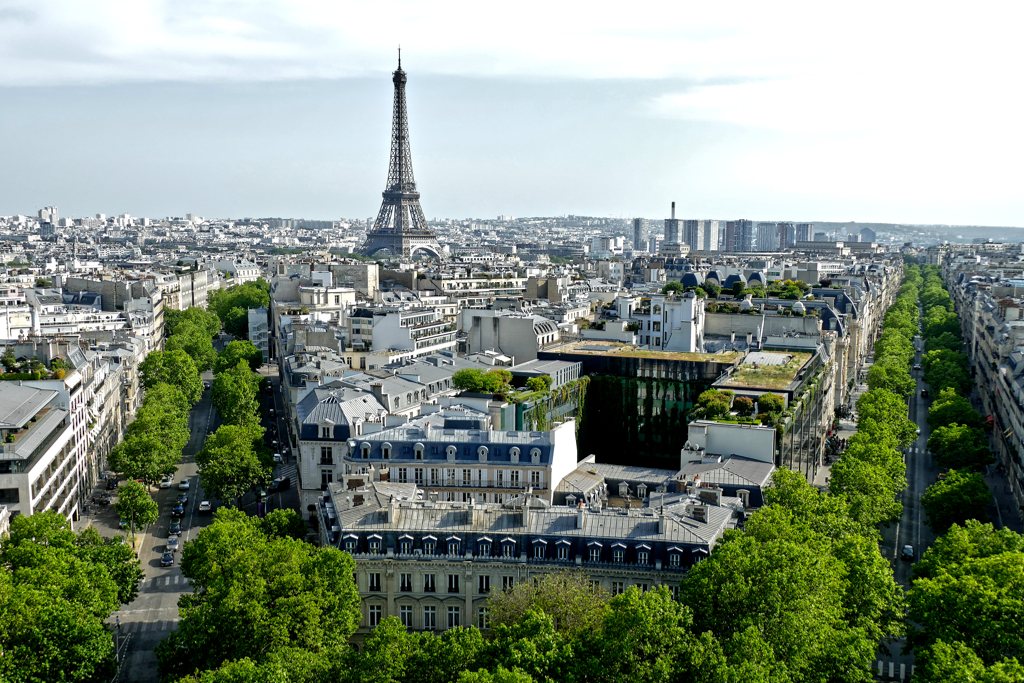
The arch can be climbed every day from 10 a.m. until 10.30 p.m. for an entrance fee of 13 €uros. You can buy individual tickets on this website*. However, I was a bit surprised that there wasn’t even the slightest warning that climbing the 284 steps of the spiral staircase can be quite a challenge. Actually, in the attic room below the platform, paramedics were treating a middle-aged lady. Yes, you guys, climbing up 284 in circles within a rather narrow staircase can be an issue for some folks, so consider that before buying your ticket.
Arch With a View
As a matter of fact, the view of the Avenue des Champs-Élysées from the Arc de Triomphe is far more impressive than from the avenue itself. It is based on pure myth that the Avenue des Champs-Élysées is still one of the most famous boulevards in the world. It stretches almost two kilometers from the Place de la Concorde to the Arc de Triomphe at the Place Charles-de-Gaulle. But apart from luxury shops that you would find in any other metropolis in the world, there really isn’t much to see here. It’s mainly tourists who squander their money in the shops along the Avenue des Champs-Élysées.
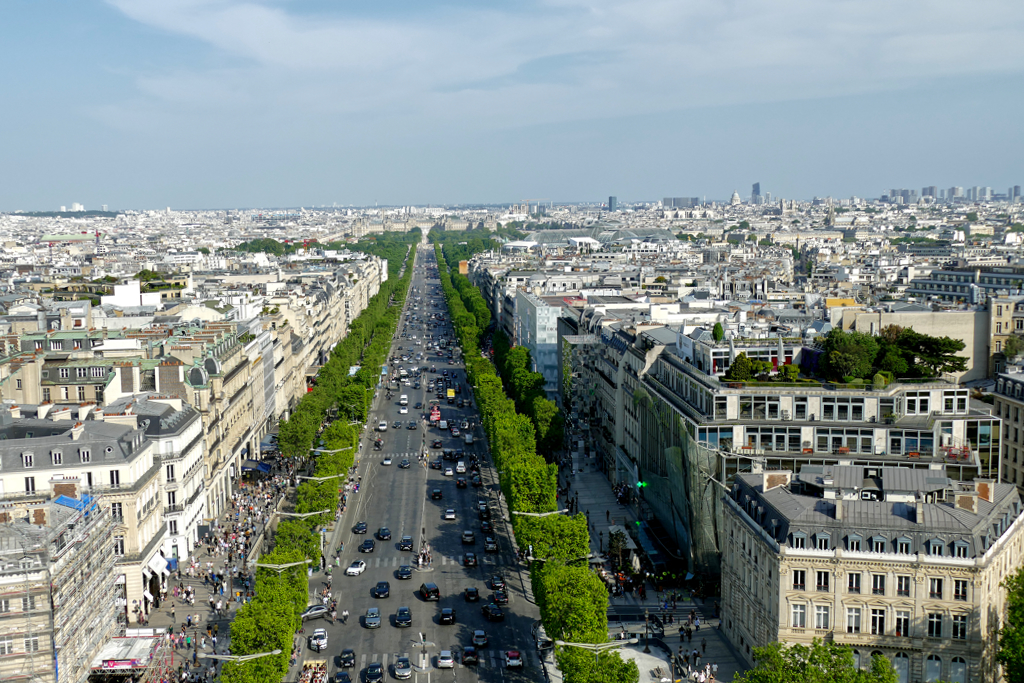
Nevertheless, the Avenue des Champs-Élysées forms the central section of the so-called Axe Historique. This axis begins in the east at the Palais du Louvre, runs through the Jardin des Tuileries, across the Place de la Concorde, and past the Arc de Triomphe. It flows into the Avenue de la Grande Armée, which leads out of the city across the Seine to the satellite town of La Défense.
My Tip
Apart from regular wreath-laying, there is also a patriotic ceremony with flags and music, and pomp and circumstance every evening at 6.30 p.m.
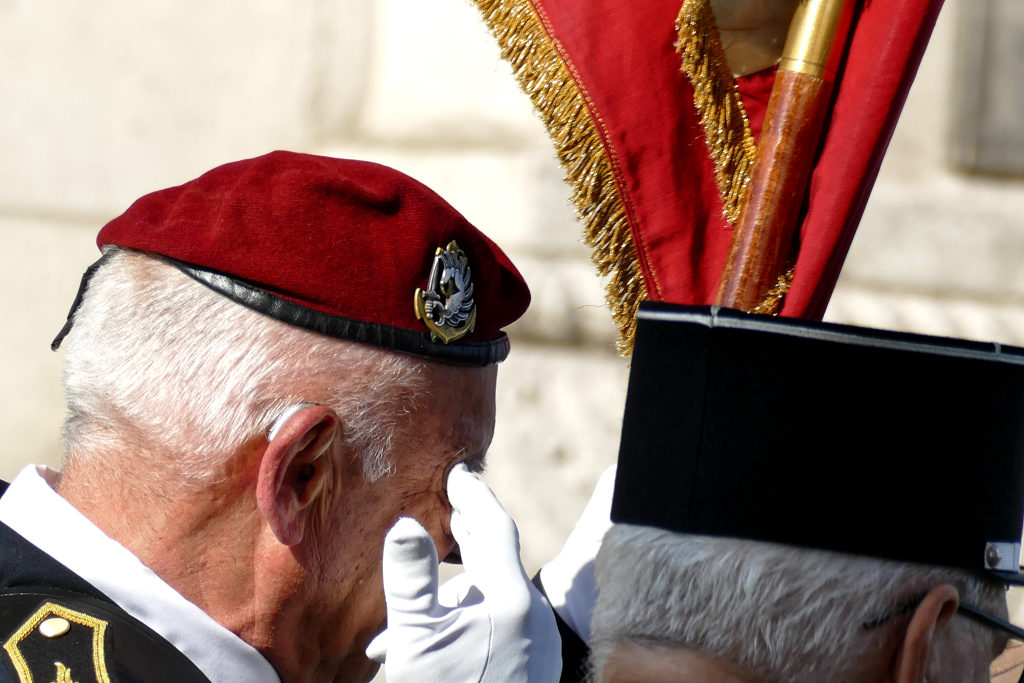
You can find out exactly who is organizing the particular ceremony and what is happening on the respective date in an online calendar.
Trocadero
Continuing to the most iconic Parisian building, you know, that tower everyone’s talking about, I recommend making your way first to Trocadéro. There are various buses as well as the métro #6 taking you there from the Arc de Triomphe in about ten minutes.
Trocadéro, sitting directly across the Seine from the Eiffel Tower, is one of Paris’s most iconic vantage points. You know, the kind of place where the city seems to lay itself out for you like a perfectly staged photograph. Its centerpiece is the Palais de Chaillot, a sweeping neoclassical structure built for the 1937 World’s Fair.
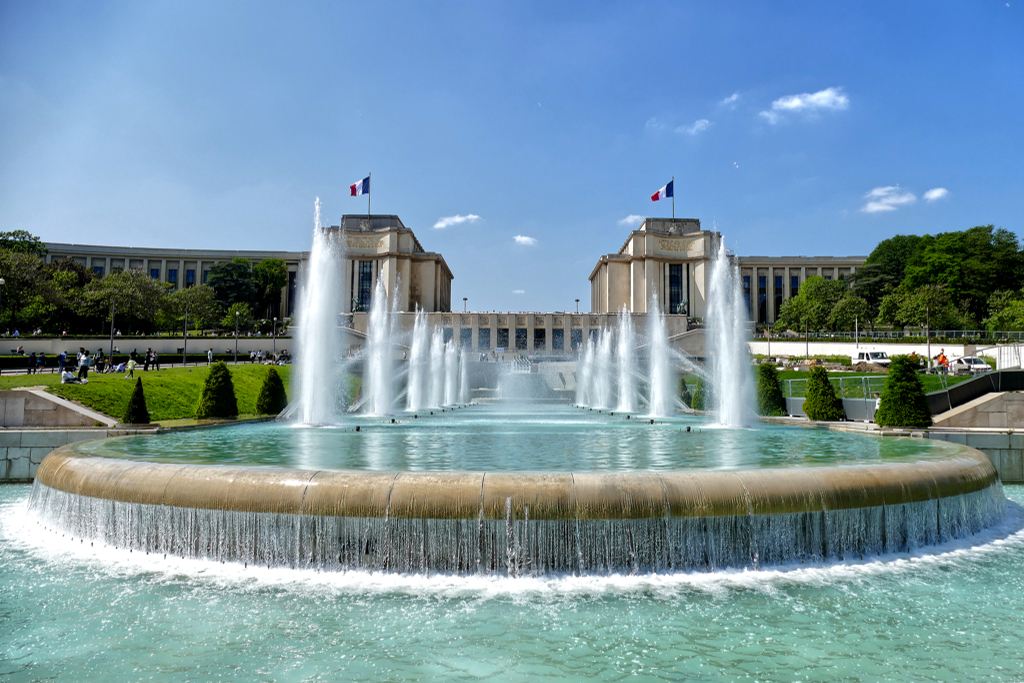
Its two curved wings embrace a broad terrace that opens onto spectacular views of the tower and the Champ de Mars beyond. Between the terrace and the river lies the Jardins du Trocadéro, a series of elegant gardens, sculptures, and the famous Warsaw Fountains, whose long water basins and high jets create a dramatic foreground for the Eiffel Tower, especially when lit at night.
But the Trocadéro is more than just a photo spot. The Palais houses several museums, including the Musée de l’Homme, dedicated to anthropology, and the Cité de l’Architecture et du Patrimoine, which celebrates architectural heritage.
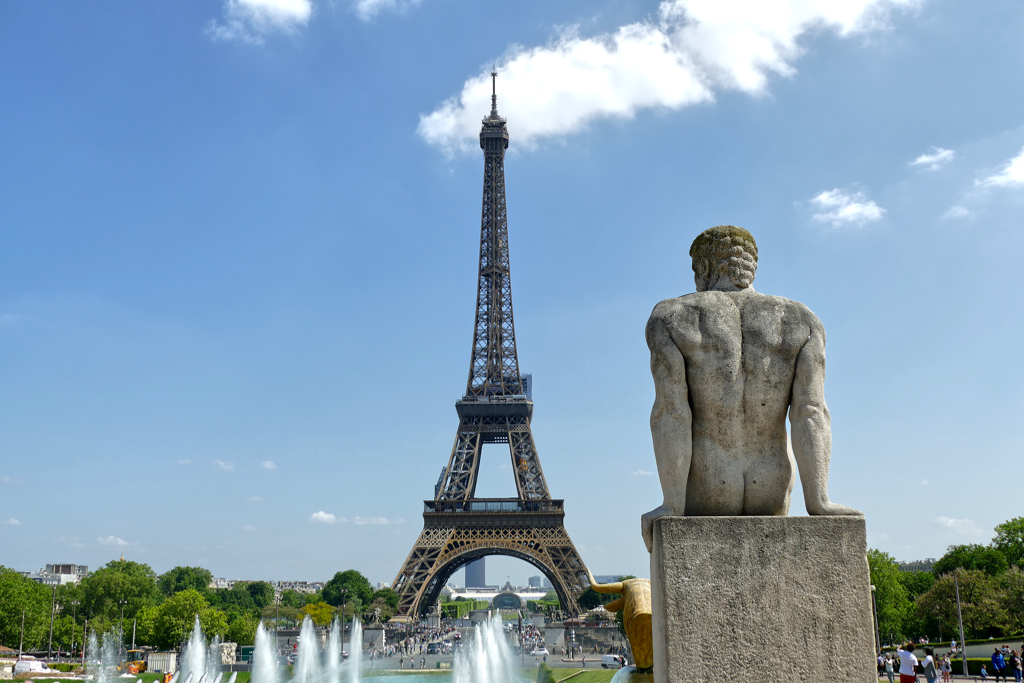
In the early morning, when the fountains are quiet and the sun begins to strike the iron lattice of the tower, Trocadéro feels almost serene. While at the wee hours, it can even be a place to pause and watch the city wake up, by midday, it’s alive with tourists, street performers, and vendors selling everything from crepes to miniature Eiffel Towers.
Tours Eiffel
Of course, a visit to the Eiffel Tower is an absolute must, especially if it’s your first time in Paris. But I dare say that climbing it isn’t absolutely necessary. Yes, you can then claim to have been there afterwards. But that’s the only perk. Because even though the view of Paris from up there is magnificent, the most important element is missing: the Eiffel Tower! Because you’re standing on it. If you want to look out over Paris, I recommend the Arc de Triomphe, the Tour Montparnasse, and the Centre Georges Pompidou – in that order. The roof terrace of the Galerie Lafayette department store also offers a pretty good view. While the view isn’t unobstructed in all directions, this vantage point has the great advantage of being completely free.
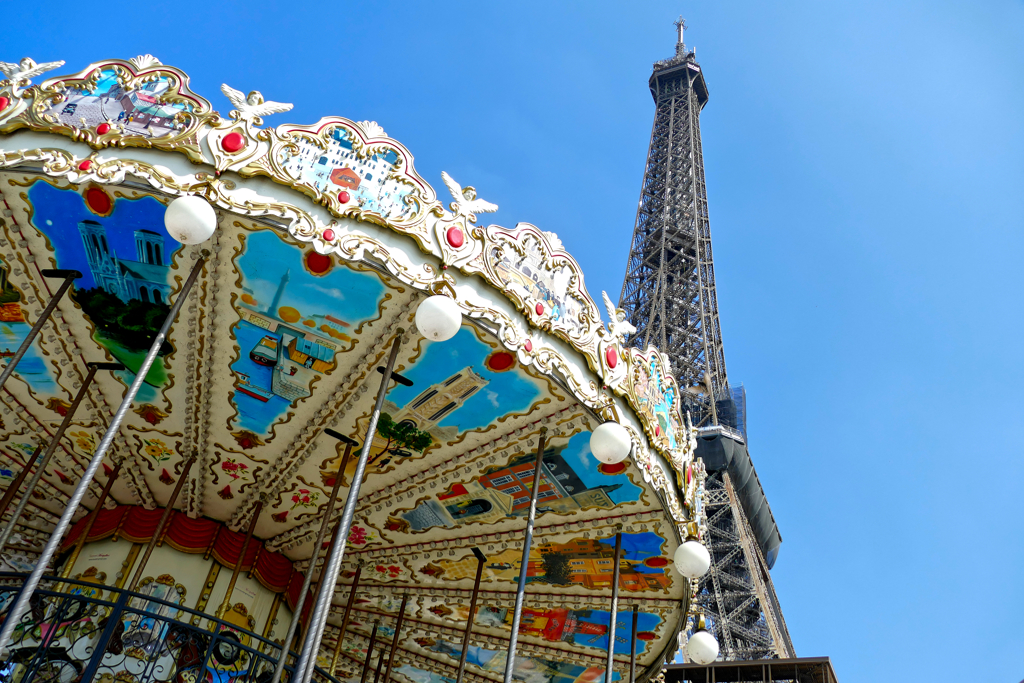
Built from 1887 to 1889, Gustave Eiffel designed it as a monumental entrance portal and observation tower for the Universal Exhibition commemorating the 100th anniversary of the French Revolution. At the time, the tower was the tallest building in the world. However, it was surpassed by the Chrysler Building in New York in 1930.
The tower became a significant part of French radio and television history, broadcasting the first European public radio program in 1921 and the first French television program in 1935. To this day, it remains the most important broadcasting facility in the greater Paris area. As the city’s tallest building, it still dominates the cityscape. With around seven million visitors annually, the Eiffel Tower is one of the most visited landmarks in the world!
The Eiffel Tower is open every day from 9.30 a.m. until 10.45 p.m. There are various ticket options depending on which level you want to visit and if you’re willing to climb the stairs or prefer taking the elevator. Either way, you can buy your ticket online*.
Tombeau de Napoléon et Musée de l’Armée
Directly behind the Eiffel Tower lies the expansive Champ de Mars park, which is usually teeming with tourists eager to catch an unobstructed view of the tower. Cross this Instagram paradise and you’ll come to what I consider to be a totally underrated landmark: the Hôtel des Invalides.
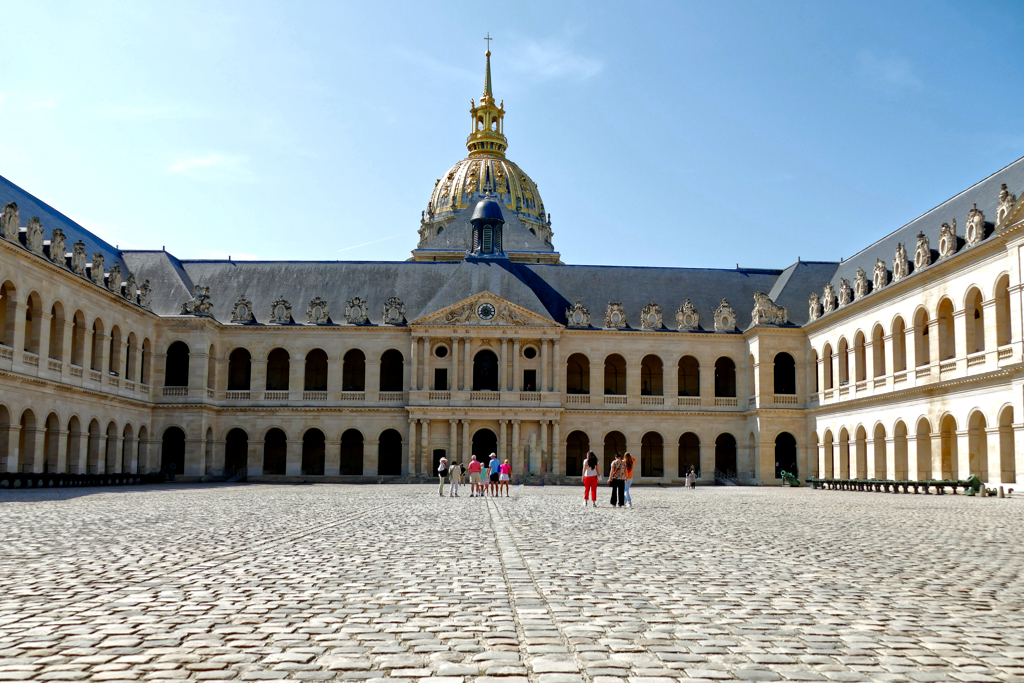
This might be a good moment to point out that a Hôtel in French is not necessarily a lodging option. It can be a private mansion, a villa, or a palace. For instance, a Hôtel de Ville is the city hall and by no means a guesthouse. The Hôtel des Invalides used to be a home for war invalids. Also, all those magnificent city palaces are called Hôtels – I’m introducing some of the most outstanding ones in my post 10 Most Beautiful Palaces in the Marais Neighborhood of Paris.
And finally, yes, a Hôtel is oftentimes actually a hotel.
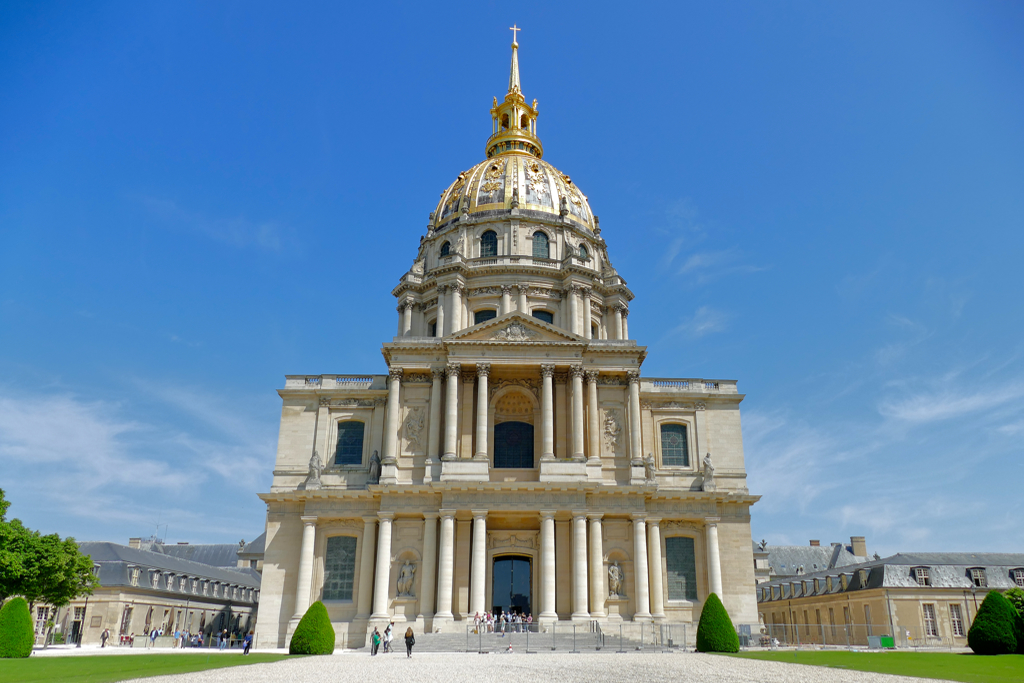
Today, the Hôtel des Invalides houses the Musée de l’Armée, which is the central museum of military history in France, housing photos, paintings, medals, armor, sculptures, uniforms, and weapons.
I don’t actually care about all that. But next to the museum is the Chapelle Royale des Invalides, which was built in the classicist Baroque style from 1679 to 1708. It was initially used as a church but was later converted into the final resting place of Emperor Napoleon I in 1840.
Coming Home
After Napoleon’s death on the island of St. Helena in 1821, it took extended negotiations with Britain to get permission to transfer the Emperor’s body from the British overseas territory in the South Atlantic to France. The coffin was first buried in the Chapelle Saint-Jérôme in a side wing of Les Invalides, as excavation and decoration of the actual crypt took twenty years. In 1861, the casket was finally lowered into the sarcophagus in the basement.
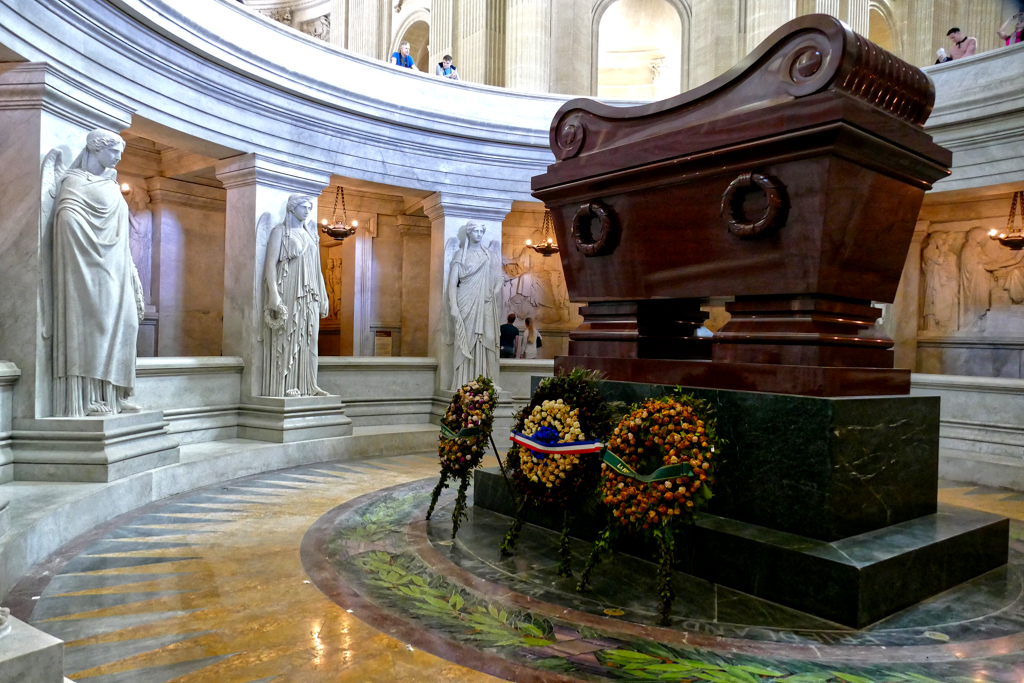
The crypt is located exactly under the dome. In the center stands a huge sarcophagus made of quartzite from Shokschinsk on Lake Onega in Russia. The twelve surrounding pillars are supporting the upper gallery. They are decorated with larger-than-life – and certainly taller than Napoleon – victories. Marble reliefs on the walls show Napoleon’s achievements like the Pacification of the nation, the Centralisation of the Administration, the State Council, the Civil Law, and all the little man’s other good deeds.
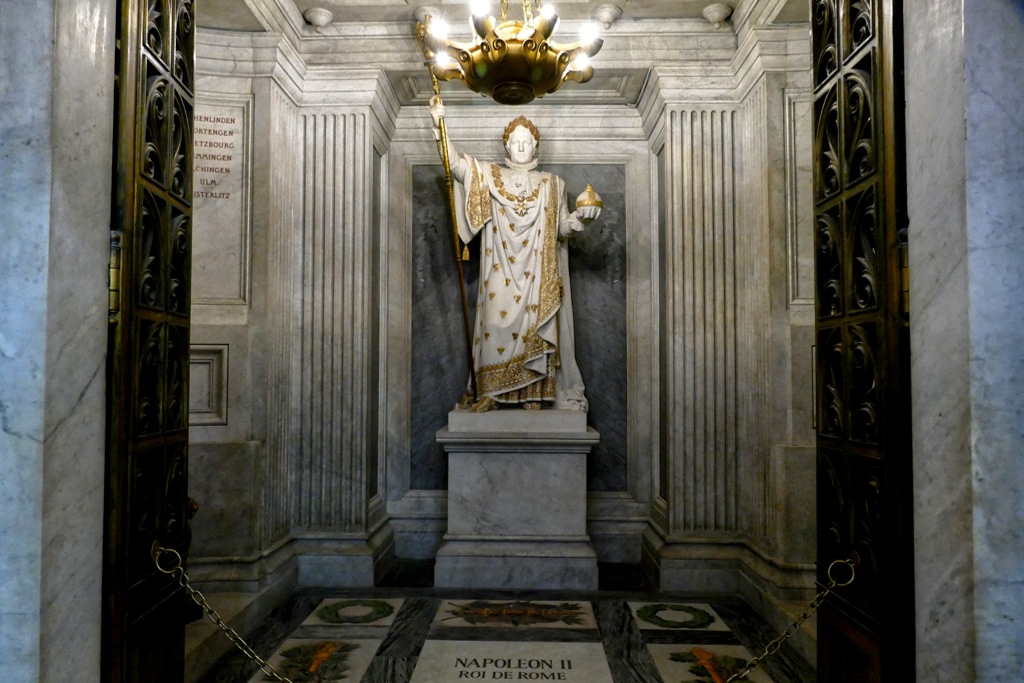
On the upper floor, there are further tombs of famous French military figures.
The entire Invalides complex is open every day from 10 a.m. to 6 p.m. The general entrance fee is 15 €uros and you can buy your ticket online*.
Musée Rodin
Just a few steps from the Dôme des Invalides is one of my favorite art museums in Paris, namely the Musée Rodin.
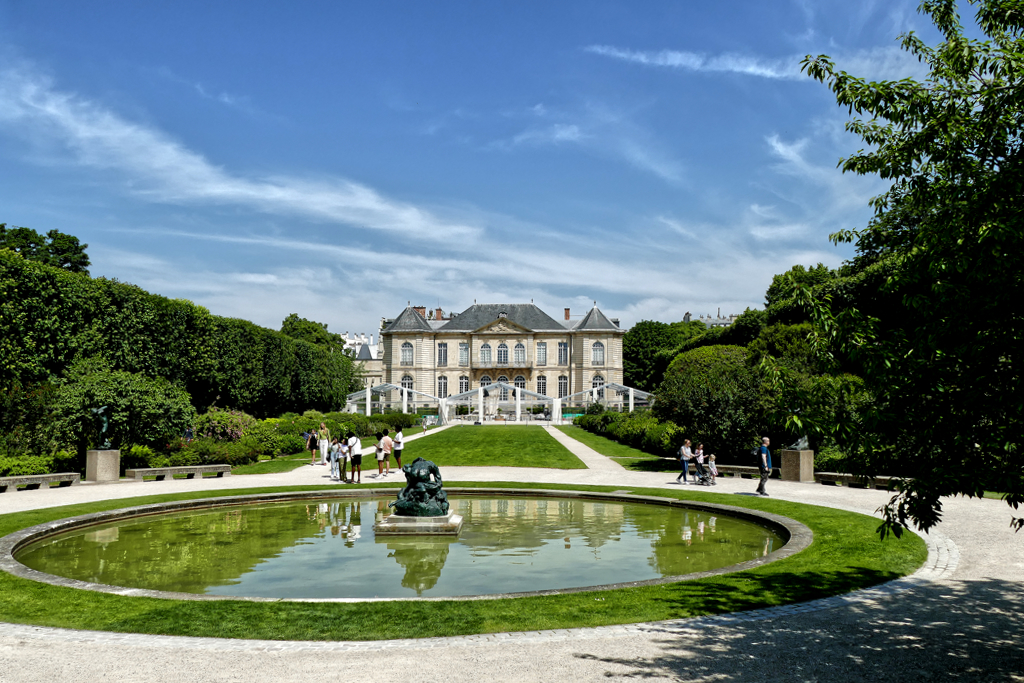
Constructed between 1727 and 1732, the Hôtel that today houses the museum was occupied by various tenants until the Duchess of Charost sold the property to the Society of the Sacred Heart of Jesus in 1820. From then on, the Couvent du Sacré Cœur became a higher girls’ school until the Law of Separation of Church and State permitted the French state to confiscate the property in 1904.
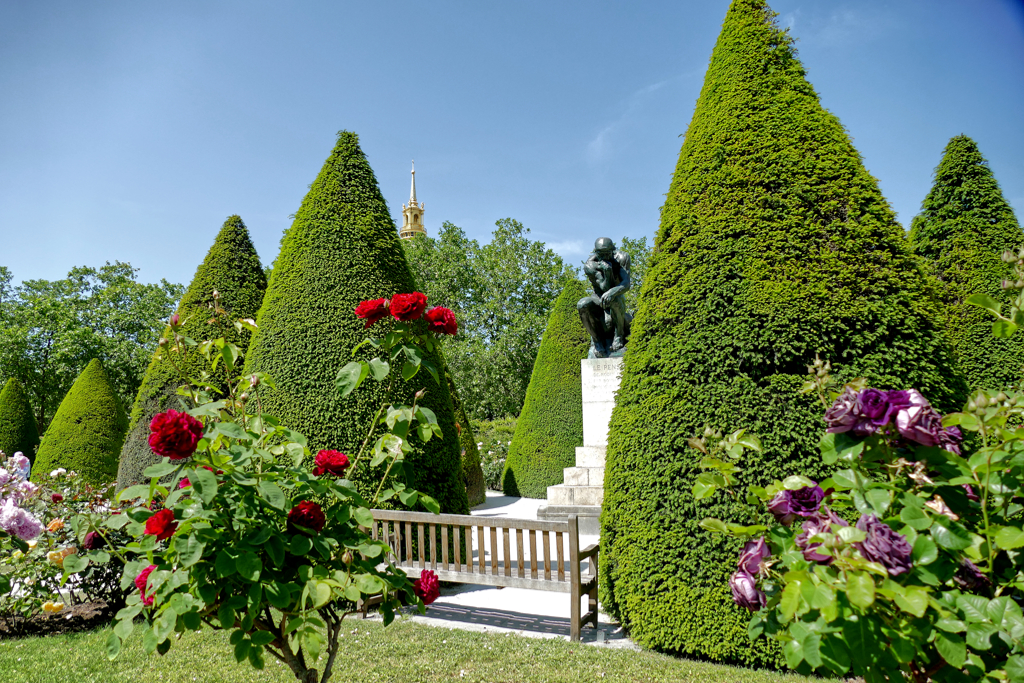
In the following years, artists such as Henri Matisse and Jean Cocteau lived in the mansion. In 1909, Auguste Rodin rented four rooms.
The same year, the property went for sale, but Rodin asked to live there for the rest of his life. Senator Gaudin de Villaine prevented the sale. In 1919, it became the Musée Rodin, however, the artist had already passed in 1917 and therefore did not live to see the opening of the venue.
François Auguste René Rodin
Auguste Rodin is considered a highly influential pioneer of modernism. Especially his groupings of elements were extremely unusual and far ahead of their time. In contrast to Michelangelo’s unfinished works, which were mostly left in their state for lack of funds, Rodin used this fragmentary style as an expressive artistic style.
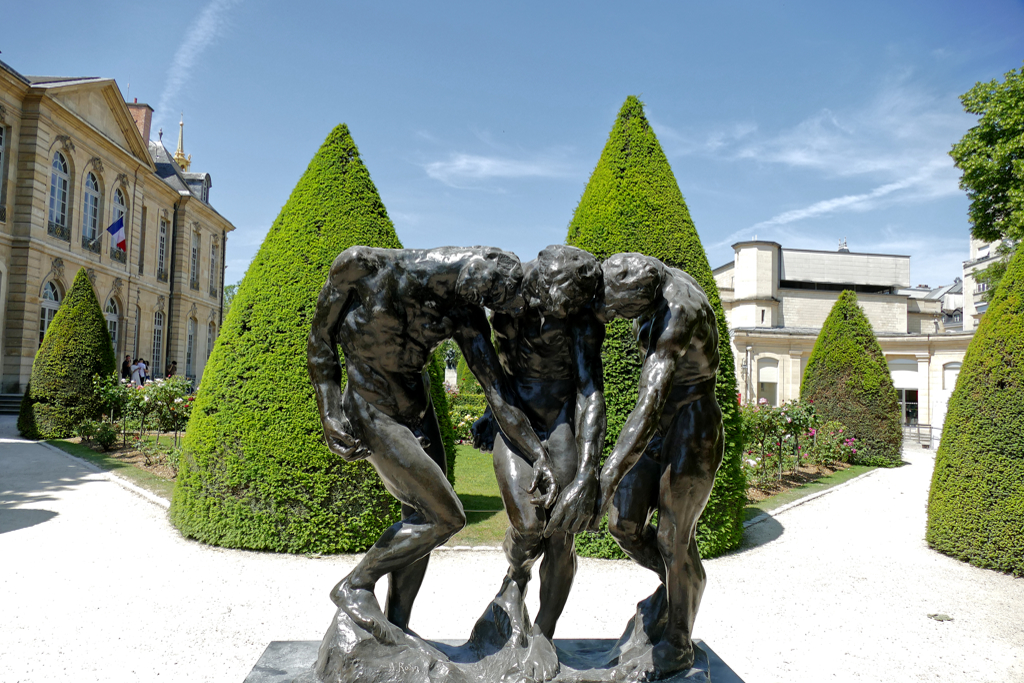
The Musée Rodin is open from Tuesday to Sunday between 10 a.m. and 6.30 p.m. The general entrance fee is 13 €uros and you can buy a timed ticket online*. Also, there is a combo-ticket that includes the Musée d’Orsay and costs 24 €uros.
Musée d’Orsay
And while we’re at it, the Musée d’Orsay should definitely be on your list if you’re visiting Paris. Since they also put together some very interesting special exhibitions, a visit is usually worthwhile during any stay in the city.
The building that today houses the Musée d’Orsay was originally the train station Gare d’Orsay. Built by Victor Laloux for the 1900 World Exhibition, it was the hub for traffic to the southwest of France until 1939. On the initiative of President Valéry Giscard d’Estaing, it was remodeled into a museum and opened in 1986.
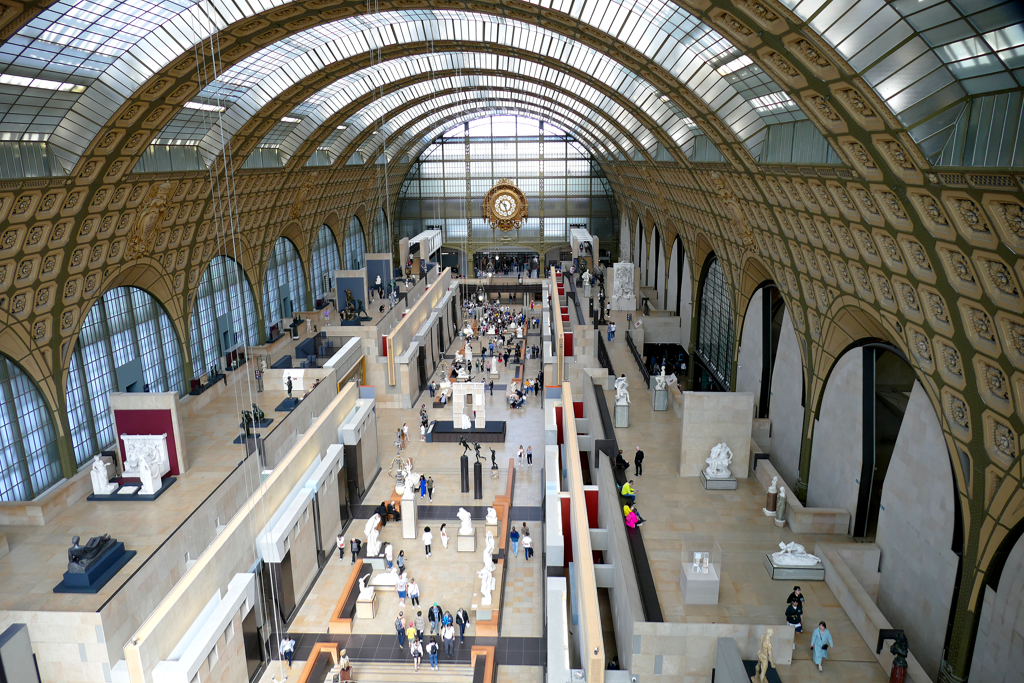
The Musée d’Orsay shows more than 4000 works. Apart from a few exceptions, all the paintings, sculptures, graphics, photographs, and furniture date from the period between the beginning of the Second Republic in 1848 and the beginning of World War I in 1914.
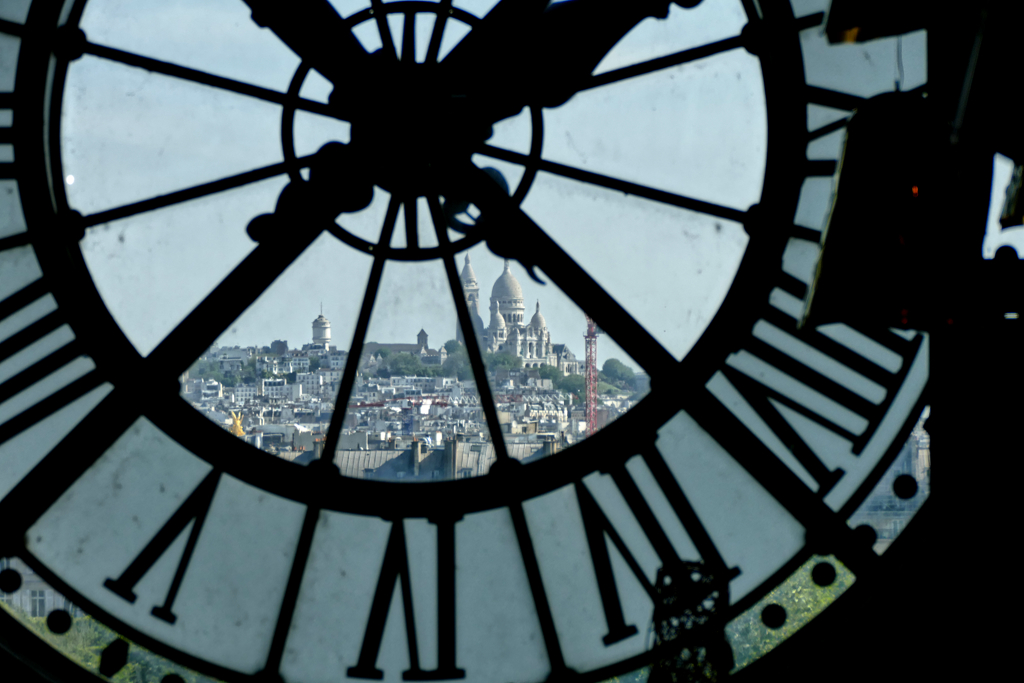
The Musée d’Orsay took over parts or even entire collections from other galleries such as the Musée du Jeu de Paume, the Musée National d’Art Moderne, and even the Musée du Louvre. Today, mainly the collection of French Impressionists is absolutely outstanding and unique in the world.
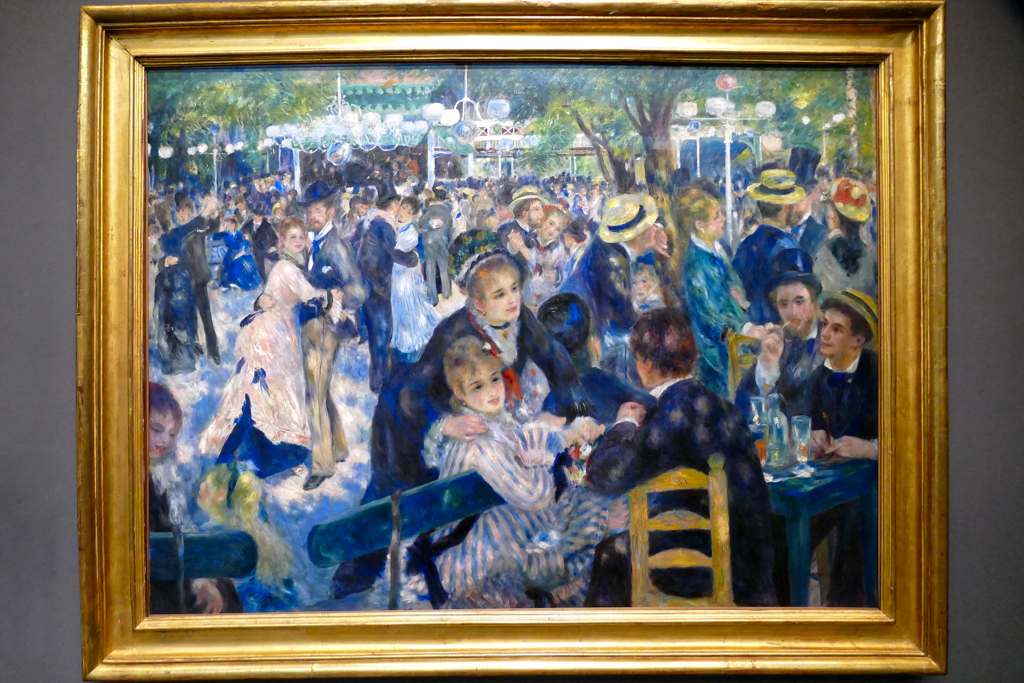
The Musée d’Orsay is open from Tuesday to Sunday between 9.30 a.m. and 6 p.m. On Thursdays, they are closing only at 9.45 p.m.
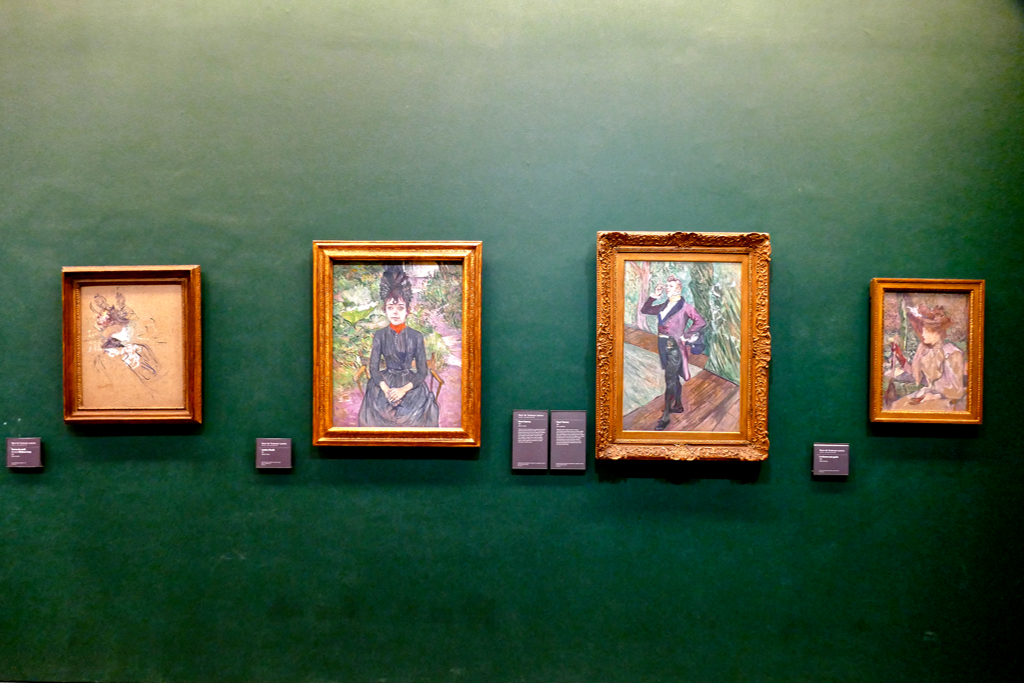
The general entrance fee is 16 €uros for the permanent collection, and you can buy a timed ticket online*. Also, there is a combo-ticket that includes the Musée Rodin and costs 24 €uros.
Keep in mind that while it’s not mandatory, pre-booking a time slot is recommended to skip the potentially very long ticket lines and ensure entry, especially during peak times.
Day Four
Cathédrale Notre-Dame de Paris
Notre-Dame de Paris Cathedral is considered one of the world’s most famous buildings. It stands on the Île de la Cité, a small island in the Seine, and is an outstanding example of French Gothic architecture. Construction began in 1163 under Bishop Maurice de Sully, presumably in the presence of King Louis VII, and spanned nearly two centuries. The main work was completed around 1345, but, as with many medieval cathedrals, it has been repeatedly restored, rebuilt, and expanded over the centuries.
Particularly striking are the two square western towers, which are almost 70 meters high, and the large west portal with its elaborately designed sculptures depicting biblical scenes and saints. Another hallmark is the enormous rose windows, whose colorful stained glass translates biblical stories into light. The use of flying buttresses made it possible to raise the walls and install large windows without compromising stability. The grotesque gargoyles were not merely decorative but also served to drain the water.
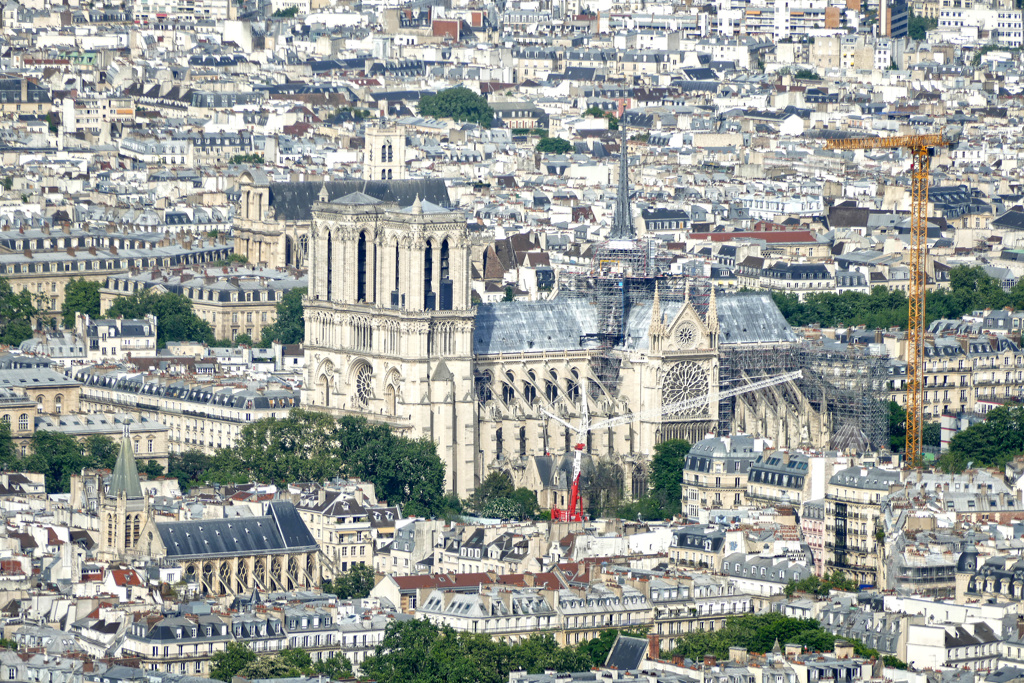
The cathedral has been the scene of numerous historical events. In 1431, Henry VI of England was crowned King of France here, and in 1804, the famous imperial coronation of Napoleon I took place in Notre-Dame, with Napoleon personally placing the crown on his head. In 1909, Pope Pius X beatified Joan of Arc in the cathedral. The cathedral also fell victim to the French Revolution, when many sculptures were damaged or destroyed, the interior looted, and parts of the church were used as a warehouse. It wasn’t until the 19th century that Notre-Dame regained importance thanks to the restorations by the architect Eugène Viollet-le-Duc and the popularity of Victor Hugo’s novel The Hunchback of Notre-Dame.
A Destructive Fire
On April 15, 2019, a major fire shook the world. During restoration work, a fire broke out in the roof structure and spread rapidly. The roof and the 93-meter-high crossing tower collapsed, destroying large parts of the medieval wooden framework. Firefighters narrowly prevented the two western towers and a large part of the interior from also falling victim to the flames. The famous rose windows and many works of art survived, but the damage to the building is significant.
The French government set an ambitious deadline of five years for the reopening. The work will initially focus on stabilizing the structure, cleaning lead contamination, and faithfully reconstructing the roof and tower. Historical techniques and materials will be used to preserve the building’s authenticity.
The cathedral has been reopening since December 2024. It is open daily from approximately 8 a.m. to 7 p.m., and admission is free. To avoid long waiting times of up to three hours, a free online time slot reservation is recommended.
Sainte-Chapelle
Almost opposite Notre Dame lies another jewel of High Gothic architecture, the Sainte-Chapelle. It is a masterpiece of Rayonnant Gothic and is located in the courtyard of the former royal palace, now the Conciergerie. Commissioned by King Louis IX, the chapel was completed in 1248. Its primary purpose was to house Louis’s outstanding collection of relics, including the alleged crown of thorns of Jesus Christ and fragments of the True Cross. The king had acquired these relics from Constantinople for enormous sums. They cost more than the construction of the chapel itself.
The chapel consists of two rooms, one above the other. The lower chapel served as an entrance and prayer room for the royal staff, while the upper chapel was reserved for the king and his court. The upper chapel is the true jewel of the building. It acts like a giant shrine of light, as its 15 tall stained-glass windows take up almost the entire wall surface of the upper chapel. The total glazing area is an incredible 600 square meters. The colorful windows depict the biblical history of salvation from Creation to Revelation in 1,113 scenes. They were also a political statement, as Louis IX saw himself as a ruler appointed by God and placed his empire in the context of divine order.
As Time Goes By
Over the centuries, the Sainte-Chapelle remained largely intact, but suffered severe losses during the French Revolution. Many relics were destroyed or scattered, the interior of the chapel was damaged, and the sculptures in the tympanum were removed. The building served for a time as a storage room for state archives. It wasn’t until the 19th century that a comprehensive restoration was carried out under the direction of the architects Félix Duban, Eugène Viollet-le-Duc, and Jean-Baptiste Lassus.
In addition to its art-historical significance, the Sainte-Chapelle still plays a role as a concert hall today. Due to its excellent acoustics, classical concerts are regularly held here.
The general entrance fee is 19 €uros, and you can buy a timed ticket online*.
Keep in mind that pre-booking a time slot is highly recommended to skip the potentially very long ticket lines and ensure entry, especially during peak times. Also, you might be interested in a combined Sainte-Chapelle and Conciergerie ticket.
Jardin du Luxembourg
Notre-Dame and Sainte-Chapelle are located on the so-called Île de la Cité, the most important of the three islands in the Seine and, in fact, the oldest part of Paris. From here, cross the Pont Saint-Michel to the legendary Rive Gauche, hence the left bank of the river. Here, the Latin Quarter and Saint-Germain-des-Prés are closely associated with intellectualism, art, and literature. You’ll find numerous museums, galleries, and bookstores here, as well as many cafés and small boutiques. Following Boulevard Saint-Michel south, you’ll reach what I’d consider Paris’ most beautiful park, the Jardin du Luxembourg. It is a former royal palace garden and part of the Palais du Luxembourg, the assembly hall of the upper house of the French parliament.
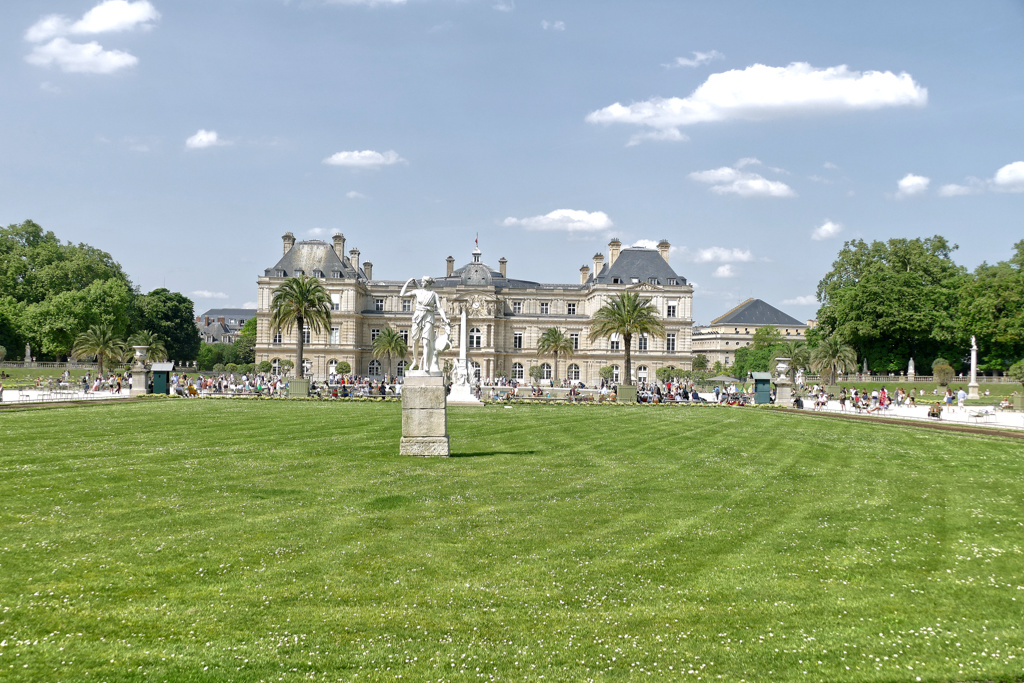
The park is roughly divided into two parts: Around the palace are geometrically arranged flowerbeds and terraces in the style of classicist 17th-century French gardens. The western part of the premises is arranged more freely in the style of English landscape gardens.
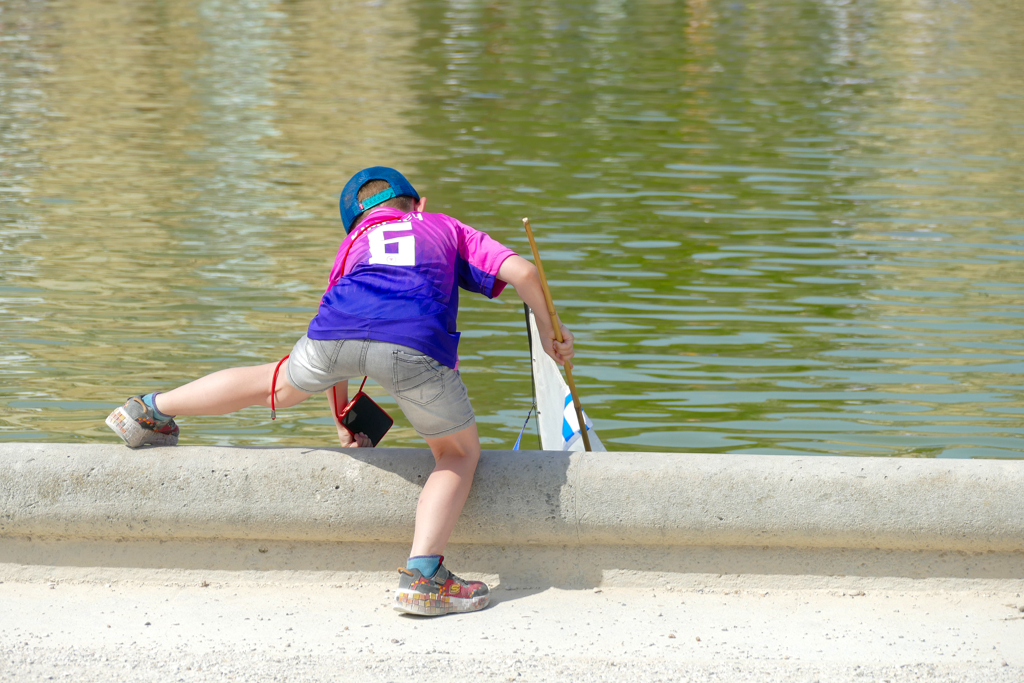
The garden is particularly popular with students from neighboring universities, obviously, as well as Parisian families, since it offers a wide range of leisure and sporting activities.
Depending on the season, the garden opens between 7.30 and 8.15 a.m. and closes between 5.30 and 9.30 p.m. You can verify their opening times during your visit on this website.
Tour Montparnasse
Just a few minutes west of the park is Montparnasse, home to the city’s main long-distance train station. Directly next to it stands the tower of the same name.
A Parisian saying goes that the platform of the Tour Montparnasse is the best vantage point in the city because you can’t see the tower from there. Unfortunately, I have to agree. The tower is one of the ugliest buildings I’ve ever seen. But the view from up there is one of the best in all of Paris!
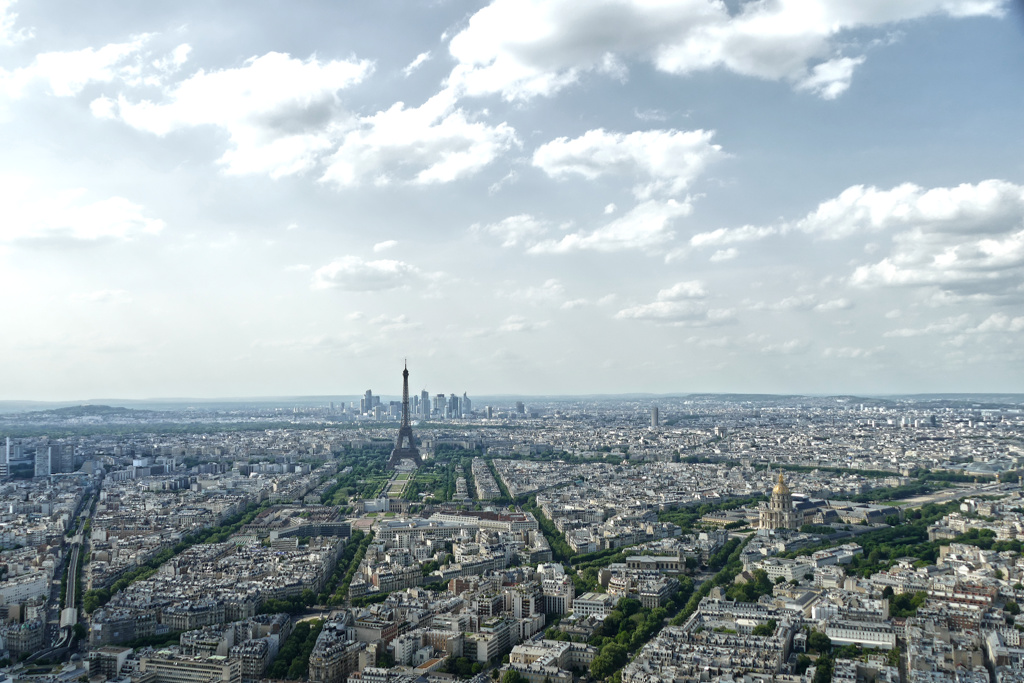
The Tour Maine-Montparnasse is a 210-meter-tall office skyscraper. It was completed in 1973. With its 59 floors, it was the tallest building in France until 2011 and remains the tallest structure within the city limits.
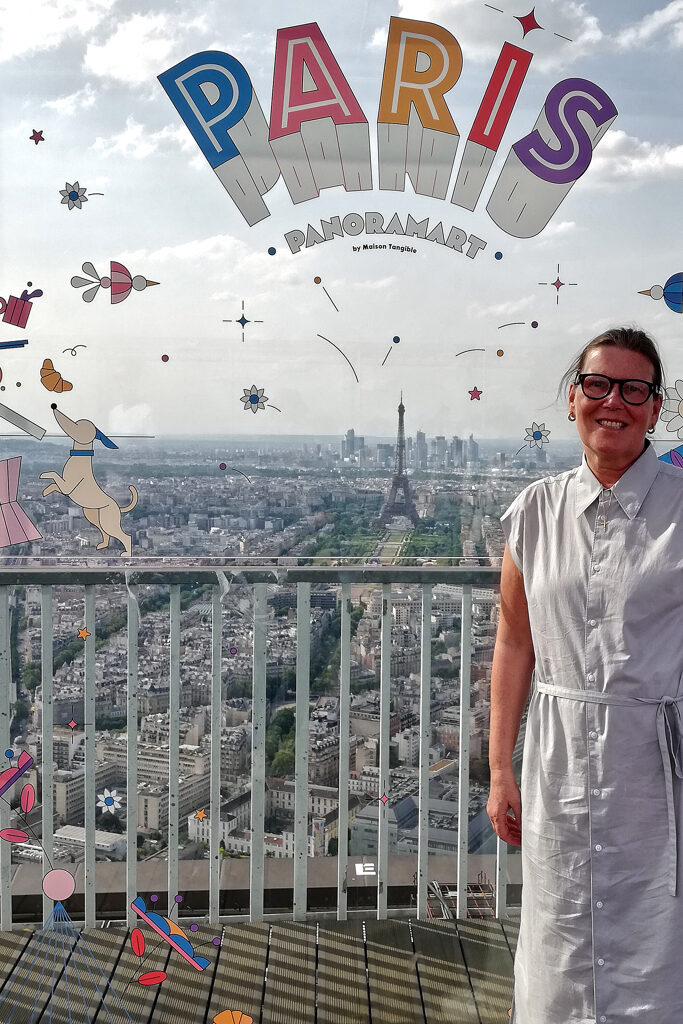
Its architecture stands out in Paris, but definitely not in a good way. Understandably, it attracted fierce criticism even during its construction. Shortly thereafter, the city banned the construction of large high-rise buildings in the city center and temporarily imposed a height limit of seven floors.
However, the Tour Montparnasse is a popular viewing point for visitors.
On the 56th floor is the public panoramic lounge with a restaurant, interactive information stations, and a panoramic café. A high-speed elevator takes you there in less than 40 seconds!
The roof terrace on the 59th floor offers amazing, totally unobstructed views of Paris, including all its landmarks.
The tower can be visited daily from April to September between 9:30 a.m. and 11:30 p.m. Between October and March, it closes at 10:30 p.m. Standard tickets are available online starting at around 23 €uros. The so-called Day & Night ticket allows two visits within 48 hours and sets you back around 35 to 42 €uros. It is highly recommended to purchase tickets online to get the time slot that suits you best and avoid waiting times.
Day Five
Paris has several nicknames: City of Love, City of Light, City of Fashion, to name just the most famous. I think Paris should primarily be nicknamed the City of Death. There are 14 cemeteries in the city, with Père Lachaise, Montmartre, and Montparnasse being just the most famous. There’s even a quite quirky pet cemetery. I’ll cover it in more detail in my post, PARIS for Free!
In this section, we follow in the footsteps of the deceased. It’s a bit creepy, but also incredibly interesting—and in places, even eerily beautiful.
Cimetière du Père-Lachaise
Let us begin where others have ended: In the legendary cemetery Cimetière du Père-Lachaise. It is the largest and one of the most famous cemeteries in the world. Its history begins in 1804. Napoleon I established a public cemetery outside the then city walls. It was modeled on English gardens, with winding paths, a park-like atmosphere, and a sense of melancholic dignity. As early as 1817, the remains of famous people were transferred there. When Honoré de Balzac also mentioned the cemetery in his works, this led to the reburial of notable figures, and the cemetery became considered a symbol of social prestige.
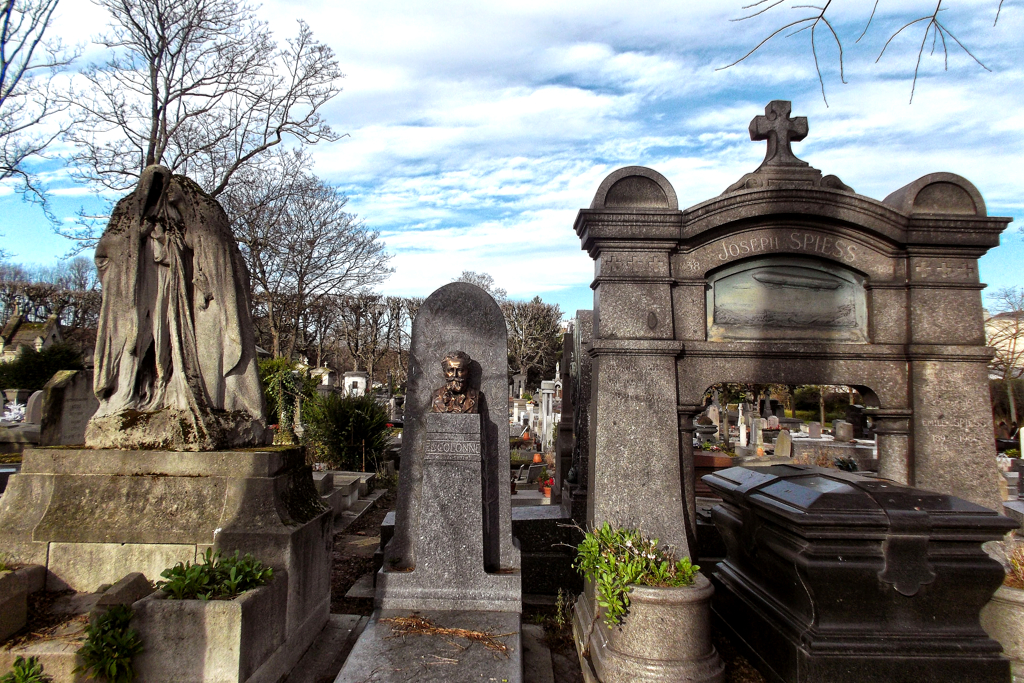
Today, Molière, Frédéric Chopin, Honoré de Balzac, Marcel Proust, Eugène Delacroix, Oscar Wilde, Jim Morrison, Édith Piaf, and many others rest there. The graves range from simple stone slabs to elaborate mausoleums and miniature chapels, making the cemetery an open-air museum of funerary art.
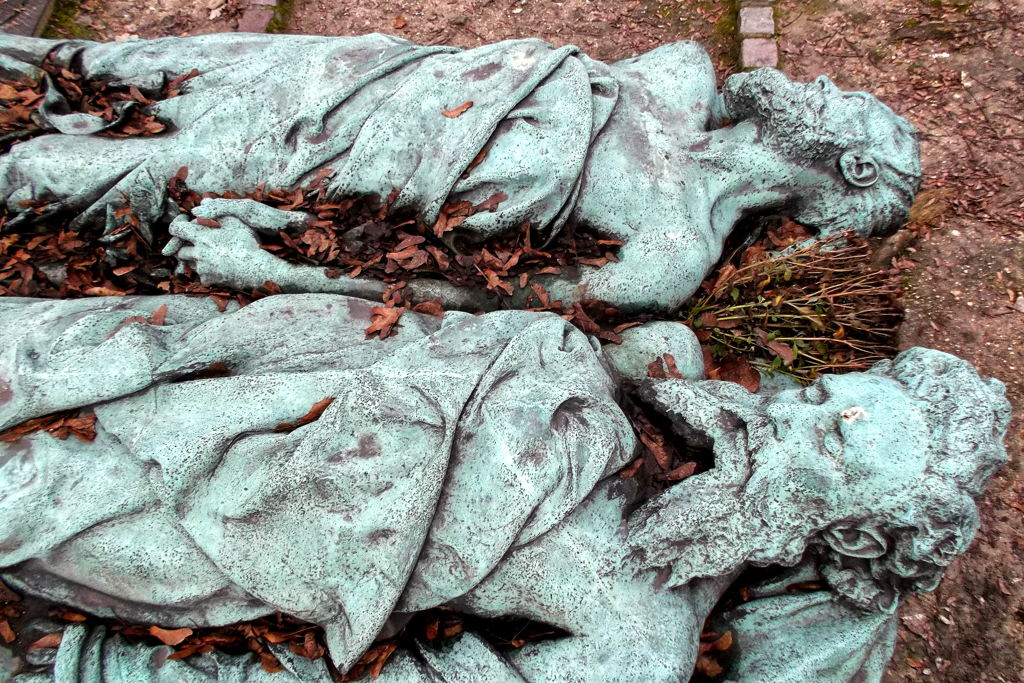
The cemetery has also been the scene of historical events. In 1814, Russian troops occupied the site during the Battle of Paris, and in 1871, 147 Communards were executed at the Mur des Fédérés in connection with the Paris Commune. Today, a memorial commemorates the victims.
Follow Etiquette
Père-Lachaise is not just a tourist attraction, but a place of remembrance and quiet farewell. Around 10,000 funeral services take place there every year. Visitors should behave respectfully at all times. Picnics, playing music, sports, or similar activities are prohibited, which should really be a given.
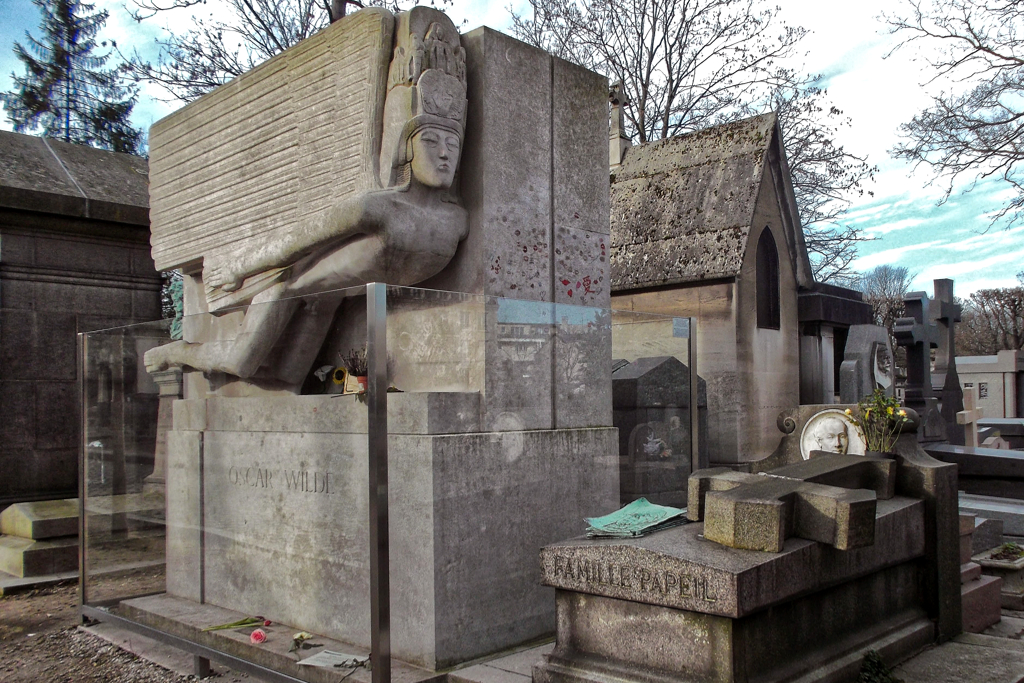
Nature also plays a major role. With more than 5,000 trees, such as cherry trees and maples, the cemetery also provides a green retreat for the living.
The immense size, with over 70,000 gravesites, often makes orientation difficult without a map. Good maps or guided tours from independent providers are very helpful.
A special resting place is Jim Morrison’s grave, which has become a place of pilgrimage for his fans. After years of vandalism, the stolen bust was recently recovered.
Paris Catacombs
Another not-so-vivid place is the Catacombs de Paris. By the beginning of the 19th century, the bones of around 6 million Parisians had been transferred to these catacombs as the growing population, epidemics, and famine had led to overcrowding of Parisian cemeteries.
The vaults were supported by pillars and expanded to include the bones of cemeteries that stood in the way of urban planning. A little disorganized at first, the gravediggers eventually began to pile up skulls and bones and arrange them in decorative patterns. Memorial plaques and wooden crosses marked the cemeteries of origin.
In 1809, the catacombs became a museum and are the world’s largest necropolis. Today, about two kilometers of the catacombs are open to visitors. However, the main part remains inaccessible to the public.
The Catacombes de Paris are open from Tuesday to Sunday between 9.45 a.m. and 8.30 p.m. The general entrance fee is 29 €uros and you can book your ticket online on this website and skip the lines.
Fun Fact
One wing of the catacombs belongs to the Banque de France. It’s the storage of the bank’s gold treasure.
Panthéon
The Panthéon is France’s national hall of fame and the burial place of famous French personalities. King Louis XV. commissioned the building as the church of the Abbey of Sainte-Geneviève. Architect Jacques-Germain Soufflot and his students built the Pantheon according to the one in Rome between 1764 and 1790.
Shortly after its completion, the leaders of the French Revolution declared the imposing domed structure a secular national hall of fame. It should honor significant personalities in French history. This was done by ornate monuments. In addition, it was planned to bury influential celebrities in the basement of the building. Below the ground floor is a massive system of corridors with numerous chapels honoring historical figures.
The list of personalities buried here is definitely impressive. The revolutionary leader Mirabeau was the first one to be buried in the Panthéon in 1791. However, after he had fallen out of favor, his body was removed in 1793. Also in 1791, Voltaire’s remains were transferred to the Panthéon, where they still rest today, making him the longest tenant. Sophie Berthelot, the wife of chemist and politician Marcellin Berthelot, was the first woman to be buried at the Panthéon in 1907. Second was Marie Skłodowska Curie, who had died already in 1934 but was transferred only in 1995. It’s not unusual that bodies are repositioned only long after their death: Novelist Alexandre Dumas died in 1870 and was moved to the Panthéon only 132 years later in 2002!
The Panthéon is open every day from 10 a.m. to 6 p.m. The general entrance fee is 11.50 €uros and 15 €uros if you add the panoramic view. You can book your ticket online on this website.
Fun Fact
Josephine Baker was the last celebrity to be brought to the Panthéon in 2021. However, it was just a symbolic burial as Baker’s cenotaph contains only soil from her birthplace in Missouri as well as from her final resting place in Monaco.
Out of Paris
Château de Versailles
Another unmissable day trip should lead you to the Palace of Versailles in the city of the same name. Apart from Neuschwanstein in Germany, the Château de Versailles is arguably the most famous castle ever. It is one of the largest palace complexes in all of Europe and was the main residence of the French Royals from the mid-17th century.
The Château de Versailles was initially designed as a hunting lodge for King Louis XIII. Built in 1661, the complex was remodeled and expanded in several steps under Louis XIV. Mind you, the château has 2,300 rooms and the largest part is more than half a kilometer long! During its time as a residence, a court of several thousand people roamed the palace. Obviously, it was the cultural and political center of France. Nevertheless, the French Revolution forced Louis XVI to leave Versailles in 1789.
Today, the Château de Versailles, including its extensive gardens and three pleasure palaces, is open to us underlings. In 1979, the Palace was included in the UNESCO World Heritage List.
The Château de Versailles is open from Tuesday to Sunday between 9 a.m. and 6.30 p.m. The general entrance fee is 19.50 €uros and the only option included in the Paris Museum Pass*.
Keep in mind that booking a time slot in advance with your Paris Museum Pass* is mandatory! However, there is a variety of additional options that include bike rides, boat rides, a gourmet break, an equestrian show, and more. You can book these comprehensive passes on this website*.
Practical Information
How to Get There
Plane
There are three airports serving Paris: The two main airports are Charles de Gaulle in Roissy, northeast of the city, and Orly south of the center.
There is a direct local RER train going between Charles de Gaulle Airport and the city center. It costs 11.40 €uros and takes about half an hour to Gare du Nord and a few other stops within the city limits. However, there isn’t a direct train line from Orly Airport. Either way, you have to change between the Orlyval Métro and the RER at the Antony Train Station. A trip costs 12.10 €uros and takes around 60 minutes.
However, both airports can also be reached by more expensive airport buses: For 16.20 €uros, the Roissybus takes you to and from the Charles de Gaulle Airport in about 75 minutes. The stop is at 11, Rue Scribe, close to the Opéra. Yes, it’s actually more expensive than the RER, and it takes longer. Beats me why people are taking it.
Anyway, there is also the Orlybus, which takes you from the stop at Place Denfert-Rochereau in 30 minutes to the airport. It also costs only 11.20 €uros, hence, in this case, the bus is a better option than the RER.
Finally, Paris Beauvais airport is located further north and is served by budget airlines. There is a bus going between Beauvais and the city center. It goes to Porte Maillot from where it also leaves around 3 hours before the departure of scheduled flights. You can conveniently check the departure on their website. A single trip costs 16.90 €uros, and a round trip 29.90 €uros. The ride can take up to 90 minutes, depending on the traffic.
Train
There are six Gares, hence, train stations in Paris taking passengers to destinations throughout the country and the rest of Europe: Gare du Nord, Gare de l’Est, Gare de Lyon, Gare d’Austerlitz, Gare Montparnasse, and Gare Saint-Lazare.
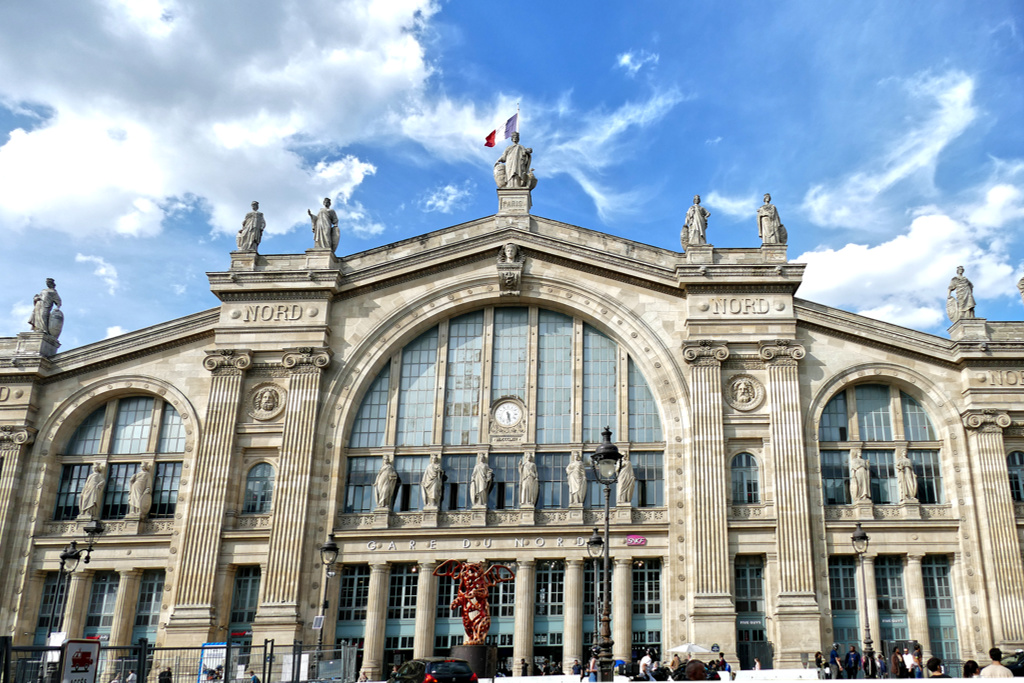
The Gare du Nord is the gateway to northern cities like Brussels and Amsterdam. From here, you can also go by Eurostar to London. In addition, it is an important hub in the Paris urban transportation network. Just a stone’s throw away is the Gare de l’Est, one of the oldest train stations in Paris. This is where you’ll catch the train to northeastern destinations such as Strasbourg, Frankfurt, Berlin, Hamburg, and Munich.
The hub for southeastern destinations, however, is the Gare de Lyon. From here, you go to the south of France and then to Switzerland and northern Italy.
Across the river Seine is Gare d’Austerlitz, the gateway to the center of France. However, currently, it’s being remodeled.
The most important train station when it comes to national travel is arguably the Gare Montparnasse, from where trains leave for Brittany, the Loire Valley, and the so-called Aquitaine. However, trains to Spain and even Portugal also leave from here. In addition, Montparnasse is an important hub of local and regional public transport.
Finally, there is the Gare Saint-Lazare from where you’ll leave for Mont-St-Michel and Dieppe.
Obviously, you can buy all kinds of train tickets online. The national train company SNCF has an informative website in French and English. However, make sure to double-check from which station your train is leaving.
Fun Fact
Many impressionist painters had a soft spot for the Gare Saint-Lazare: Edouard Manet, as well as Claude Monet, made this railway station the main motif of many of their paintings. There’s an anecdote of Monet showing up unannounced, demanding that the station master blow steam on his command.
Bus
Travelling by long-distance bus is getting really popular in Europe. The cheap prices make up for the little loss of time compared to trains. And since various companies are competing, the service is usually very reliable.
One of the most popular bus companies in Europe is Flixbus. They are going to Paris from many European cities, like, for instance, Amsterdam, Berlin, Brussels, Lisbon, London, Prague, and many others.
There are nine Flixbus stations around Paris, of which the one at Bercy-Seine is the most central one. Note that it is located inside the Parc de Bercy.
How to Get Around
Public Transport
I’d argue that of all European cities, Paris has the most comprehensive network of public transportation. The world-famous metro alone has an incredible 302 stations. In fact, you’re never farther than 500 meters from a metro station. While this is absolutely fantastic, changing lines is a downer since some stations are huge and built like multi-level mazes. I kid you not, it happened to me that I was walking in circles since I missed the correct tunnel. However, I never heard of anybody getting lost down there forever, so don’t worry.
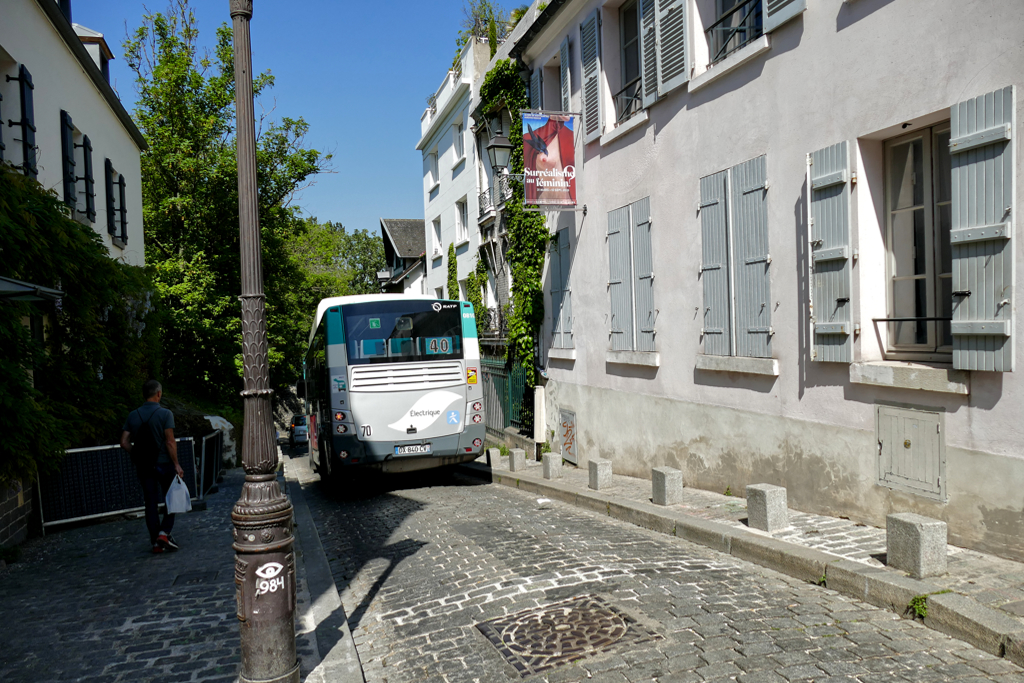
In addition to the already comprehensive metro network, there are local trains called RER, there are trams, and there are buses, obviously. So no, nobody needs a cab in Paris.
Which Ticket to Buy
It used to be so simple: you either bought a single ticket or a carnet consisting of ten of these adorable little tickets, and that was fine. That’s currently being discontinued. While you can still use your remaining paper tickets, you can no longer buy them. Now you have a Navigo card onto which you can load journeys. But you need to know whether you want to take the bus or the metro, as there’s a price difference.
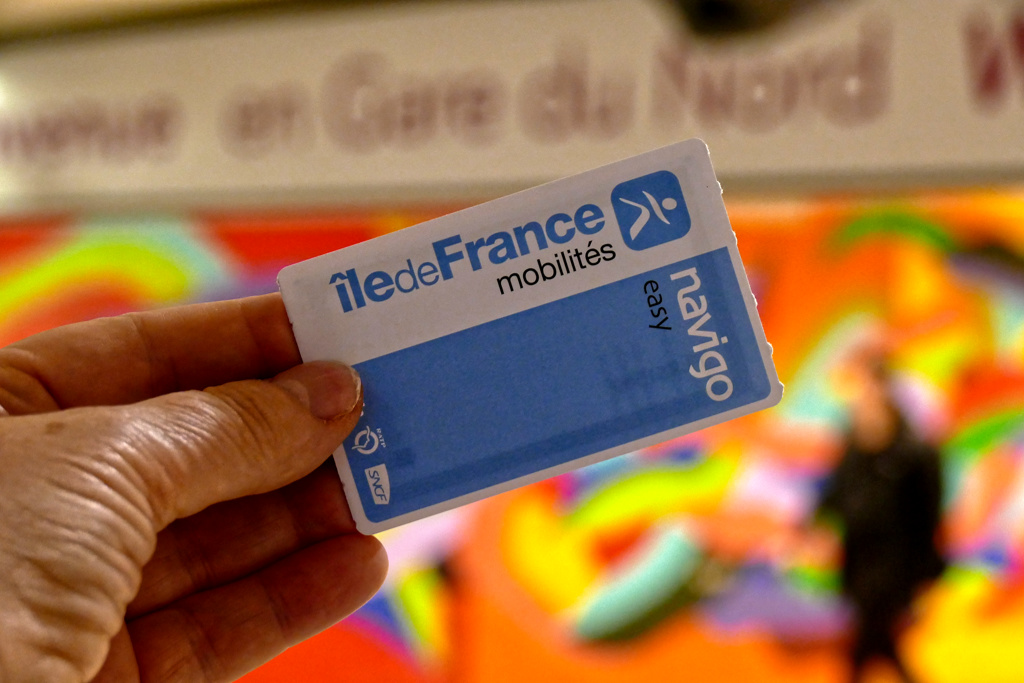
While you’re going through the turnstile with your card at the metro, you have to hold it up to the small ticket validator on the bus. Make sure it beeps. If there’s a ticket check and you haven’t validated the journey, you’ll be in trouble.
Travelling the Easy Way
The easiest way is to load a day ticket for 12 euros onto your Navigo card. It’s valid for all local transport, and you’ll have peace of mind for the whole day.
In any case, make sure to keep whatever form of ticket you might have until the end of your trip. In some places, you need to insert it in a turnstile to leave the station. Also, there might be ticket controls within the station, and if you cannot show a validated ticket, you’re in trouble
Note that there are travel passes for 1, 2, 3, or 5 consecutive days. You can choose between a pass valid for zones 1 to 3 in the center and a pass for all zones in Paris and the entire Île-de-France, including airports, Disneyland Paris, and Château de Versailles.
| 1 Day | 2 Days | 3 Days | 5 Days | |
| City Center | 12.00 €uros | 19.50 €uros | 26.65 €uros | 38.35 €uros |
| City Center and Île-de-France | 25.25 €uros | 38.35 €uros | 53.75 €uros | 65.80 €uros |
Kids under 4 years of age travel for free, and those under 12 pay half price.
Walking
Although I refrain from referring to walking as an exclusive option to explore the city, you will be walking a lot. With about 10 kilometers from north to south and around 11 kilometers from east to west, the very city of Paris is surprisingly small. And as it is expectably picturesque, you’ll be strolling more than you have ever planned. Yes, you’re never more than 500 meters from the next Métro-station. But that’s not necessarily the line you need. Hence, why not walk the short ten or twenty minutes? Well, let me tell you, those quickly add up to hours and many kilometers.
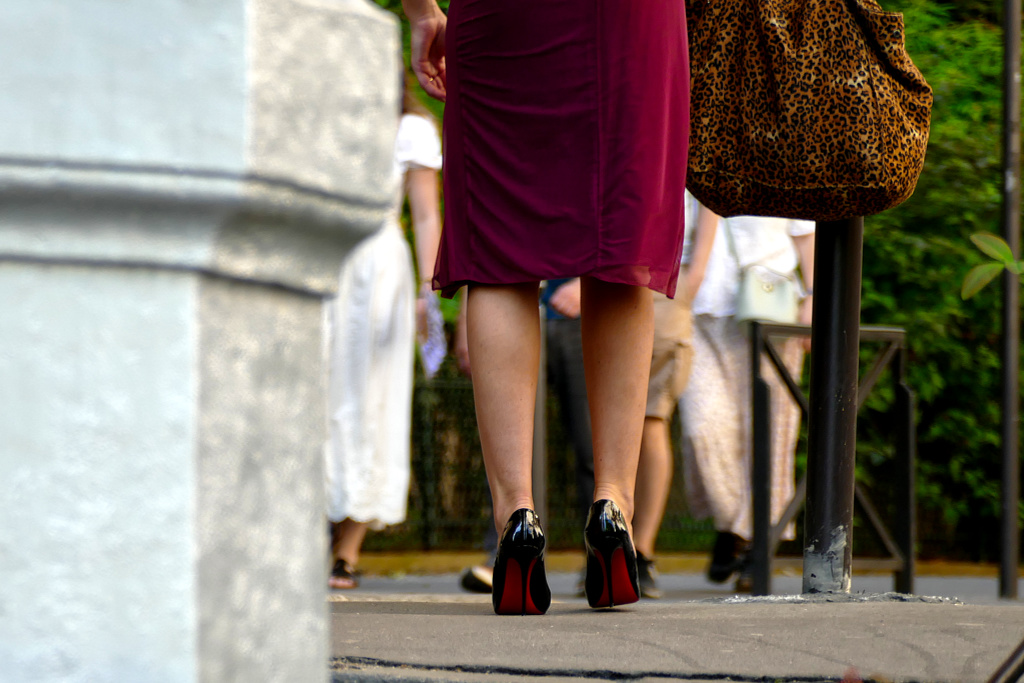
Even if you explore just the very center, I highly recommend taking the Métro from time to time. But even then, you’ll be on your feet a lot. Also, many streets are paved with cobblestones. And finally, keep in mind that Paris is very hilly in some places, so you’ll have to climb steep streets’n’stairs.
Therefore, do yourself a favor and wear sensible shoes like loafers or sneakers – or even light hiking boots. Don’t even think about wearing thin heels, you’ll ruin your shoes, your feet, and thus, your day.
Cycling
I was very surprised by how many people are cycling in Paris. It’s much less than in Amsterdam or Copenhagen, obviously, but apparently, the Tour de France rubbed off on the average citizen.
As a visitor, you can join the fun and rent a bike. The company Vélib offers regular bikes, which are green as well as blue e-bikes. Both kinds have baskets and locks in case you need to take a break. They need to be picked up respectively returned at one of the many stations located throughout Paris.
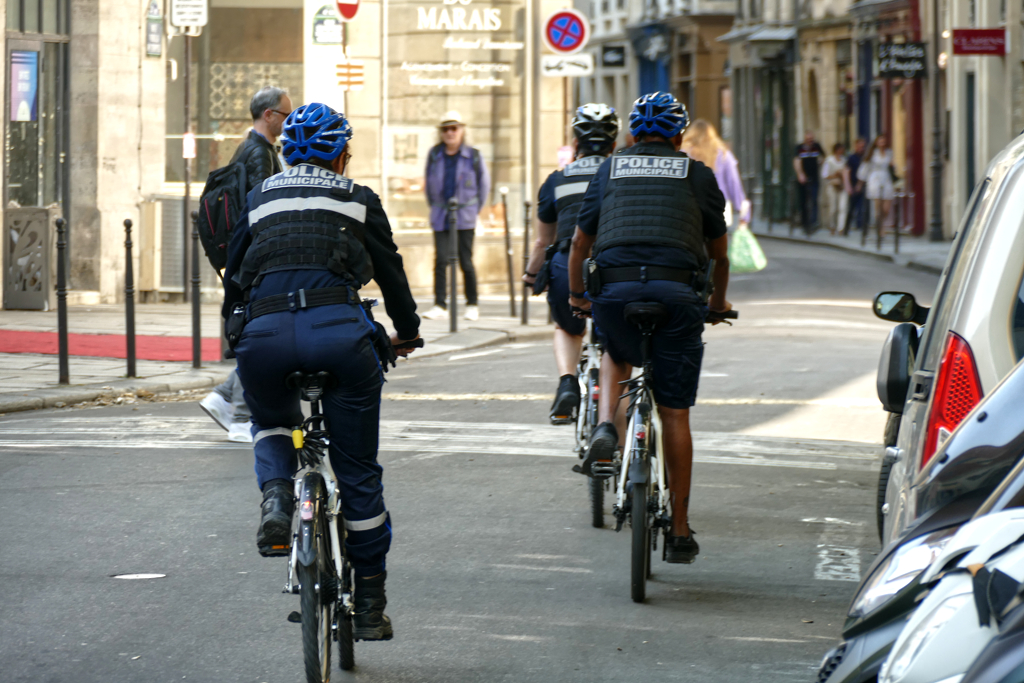
You can sign up for passes online. However, if you cannot receive a text message on a French phone to confirm your payment, you’ll need to sign up at one of the terminals. Make sure to take a picture of the passcode on the screen in case something goes wrong with the confirmation. You get an account number and a PIN. Keep them thoroughly.
There are passes that anyone with a valid credit card can obtain, as well as subscription options for residents or long-term visitors.
You’ll be charged two fees: Firstly, you’ll be charged for the pass right away, whether you ever use the bikes or not. Then, there is the rental fee for the actual use.
Pay As You Ride
Occasional users should get the Ticket-V for three €uros. It is suitable for a single-use rental of a green bike or an e-bike for up to 45 minutes. After that, you’ll have to pay one €uro for each additional 30 minutes on a regular bike or two €uros for e-bikes.
The Pass 24-hour Classique costs five €uros. For 24 hours, you can use the green bikes for free for up to 30 minutes. After that, your credit card will be charged one €uro for each additional half hour until you return the bike. This way, you can use as many bikes as you like without paying more than the pass fee. All you have to do is switch bikes after 30 minutes.
If you decide to use a blue e-bike with your Pass Classique, it will cost 2 €uros for every 30 minutes with no free minutes.
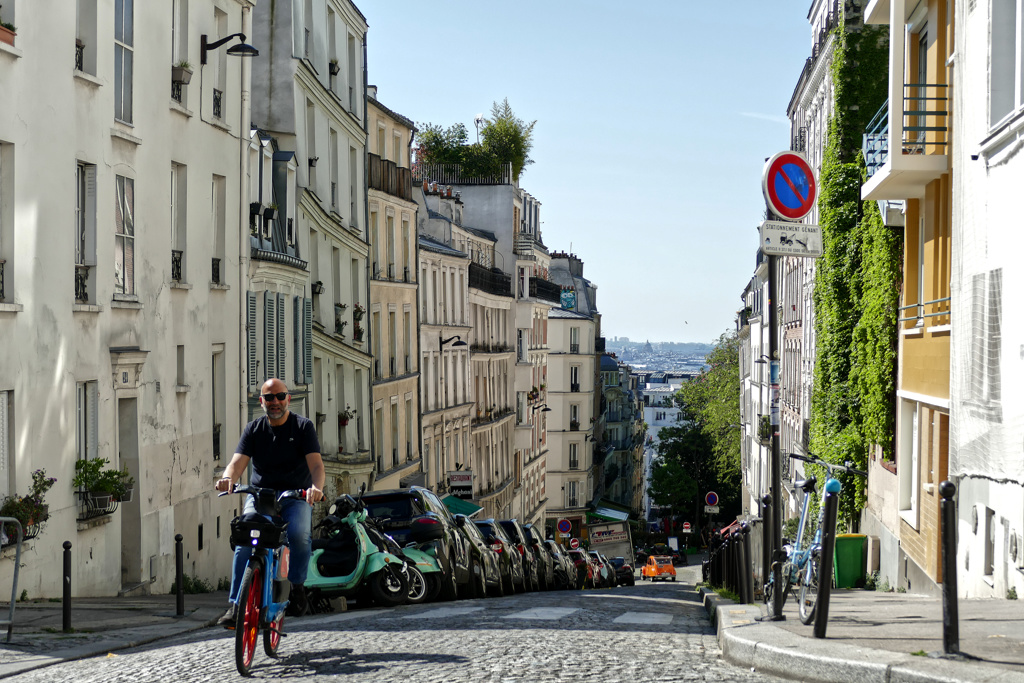
If you opt for either the Pass 24-hour Electrique, which costs ten €uros, or the Pass 3 Jours for 20 €uros, the first six trips on a blue e-bike are free for up to 45 minutes. Then, you’ll be charged one €uro for each additional 30 minutes. If you decide to use a standard green bike with this pass, it’s free for up to 60 minutes per trip. After that, it’s one €uro per 30 minutes.
Apart from the Ticket-V, all passes allow you to take up to five bikes at a time with one account. This comes in handy for small groups or a family since you have to open just one account for the entire party.
Visiting Organized
I’m an avid solo-travelling woman. Since solo travel doesn’t equal solitude, I love to join organized tours here and there since it’s the best way to meet fellow travellers.
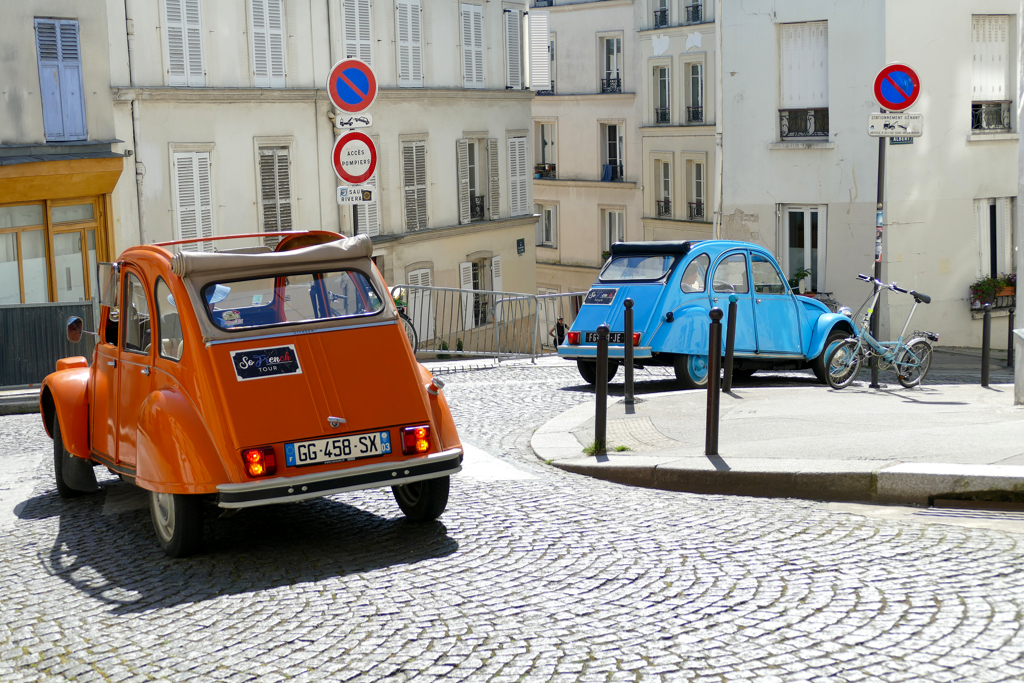
Especially if you have only a short time for exploring Paris, an organized trip will enable you to see the most in a relatively short period of time. However, make sure to book the activities of your choice well ahead, especially during the high season*:
Where to Stay
Since Paris is one of the most touristy cities in Europe, there is a wide choice of accommodation, and all of them are crazily expensive.
It’s an easy equation: Of the three aspects of a good standard, convenient location, and affordable price, you always have to waive one. If you find a good standard hotel in a convenient location, it won’t be at an affordable price. A hotel in a convenient location at an affordable price won’t have a good standard. And finally, a good hotel at an affordable price won’t be in a convenient location.
I opted for the last option, which brought me to the neighborhood of Port de Bagnolet. At the Campanile Paris Est*, I had a squeaky clean room on the 7th floor and the métro station Gallienne literally at my feet. Also, right next to the Campanile Paris Est* is a shopping mall with a couple of fast-food restaurants and a huge supermarket. Although commuting around half an hour back and forth every morning and evening might not be everyone’s cup of tea, I paid a fraction of what I had paid in the city center.
On this map, you can choose suitable lodging options in Paris according to the location and your budget, obviously*:
What to Eat
Wow, that’s a toughie! Not because there aren’t many choices – no, on the contrary: There are trizillions of choices, from Michelin-star-decorated restaurants to delicious small falafel joints. It’s Paris, after all!
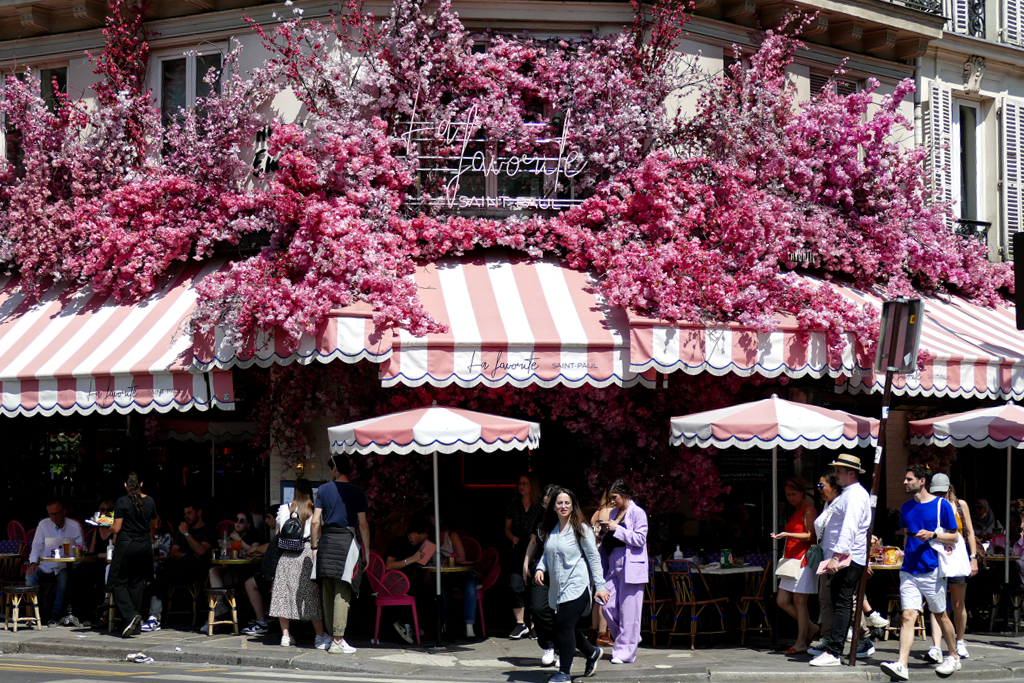
Obviously, there is no way to get food for free. But there are ways to eat decently and still not break the bank.
It starts with breakfast. If it’s included, take it. Coffee is quite pricey in Paris, expect to pay at least around 4 €uros for a small cup of coffee. Add two pastries and you’ll probably be at 8 €uros. And I am talking about an average bakery, not a cafe. There, you’ll pay even more. So if you can start the day with a large breakfast at your hotel, I’d suggest you go for it.

Finding a nice lunch at a reasonable price shouldn’t be such a big deal. Many eateries have a plat du jour or a menu or formule that includes a starter or a dessert and sometimes even water and wine. You won’t get that at dinnertime. In general, it’s better to stuff face at noon and opt for a sandwich or some hearty pastry in the evening.
A good option to get some nice snacks is, for instance, Carrefour City and Carrefour Express. But also other supermarkets offer ready-made hot and cold meals. I don’t claim it will be the fanciest meal you’ve ever had, but it is an option that will save you lots of money.
Classic Cuisine
When I travel, I try to find this mom-and-pop eatery where I rub shoulders with locals. Not tourist traps, but nothing over the top, either. A place where the average towny enjoys his or her lunch.
Therefore, my very favorite restaurant in Paris is Chartier.
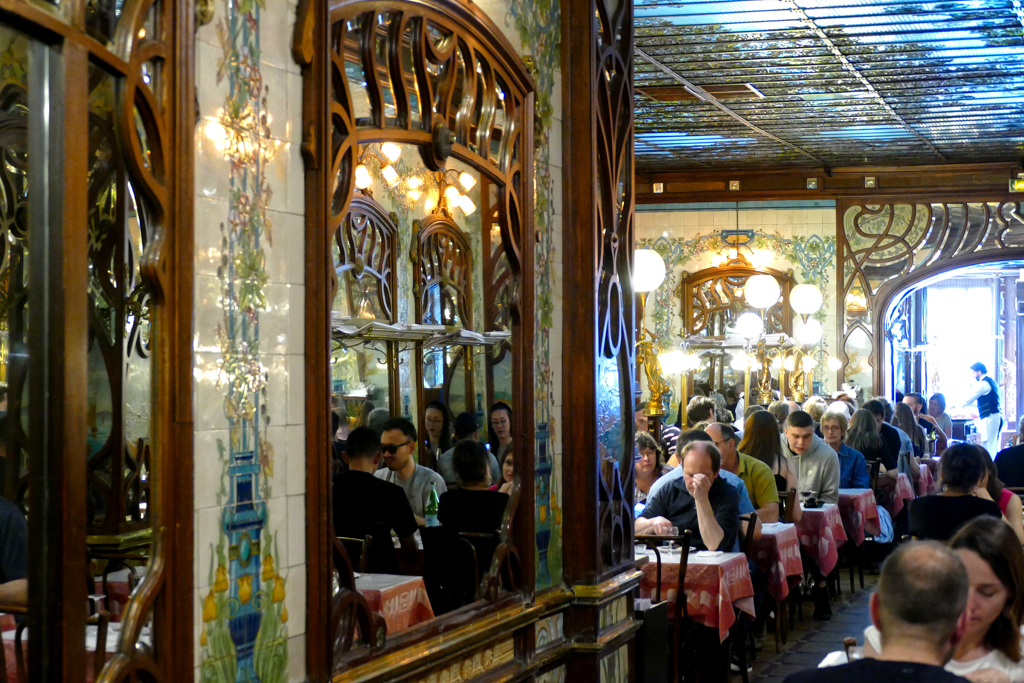
The first Bouillon Chartier opened in 1896 and is located in a back building on Faubourg-Montmartre. The interior is designed in an Art Deco style and hasn’t changed over the decades. The spacious hall offers seats for over 300 people and looks a bit like an old-fashioned train station eatery. It even has a large clock on the wall! The busy waiters are pacing between the small tables in long white aprons, black vests, and bow ties. They write down the order right on the paper tablecloth in front of you, where they also sum up l’addition at the end of your meal.
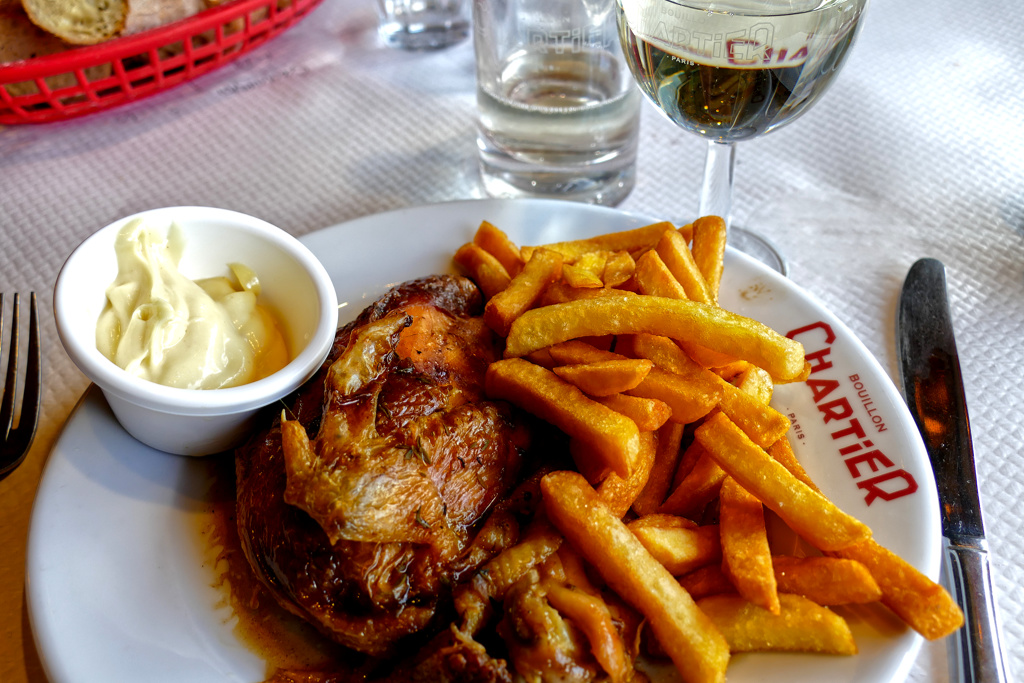
Due to the fantastic quality at very reasonable prices, Chartier has first been popular with locals, but now tends to be overrun with tourists. Therefore, I do not go to the original Chartier anymore but prefer their branches in the vicinity of the Gare de l’Est and in Montparnasse. You’ll find all three restaurants on the map below.
Mussels From Brussels
Another one of my favorites is the restaurant chain Léon de Bruxelles, albeit it is rather a staple food of Brussels than a Parisian classic. But as Moules-frites is quite popular among the French, too, Léon is always fairly busy, especially at noon. They have seven or eight branches in various arrondissements in Paris, you’ll find three on the map below.
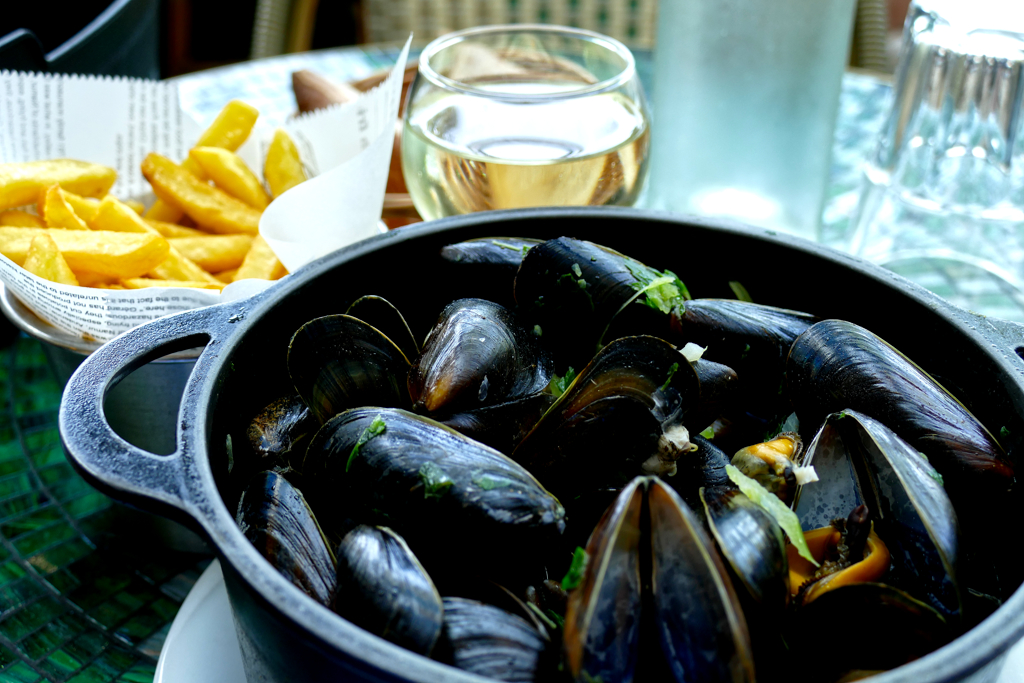
Last but by no means least, I love the Levante eateries in the Marais district. The most famous one is certainly L’As du Fallafel, where even celebrities like Lenny Kravitz enjoy their kebab.
I don’t know how long Mr. Kravitz had to wait in line. When I got there, the queue went all the way down the Rue des Rosiers. Anyway, L’As is just one of the countless Middle Eastern eateries, hence, you won’t go home hungry.
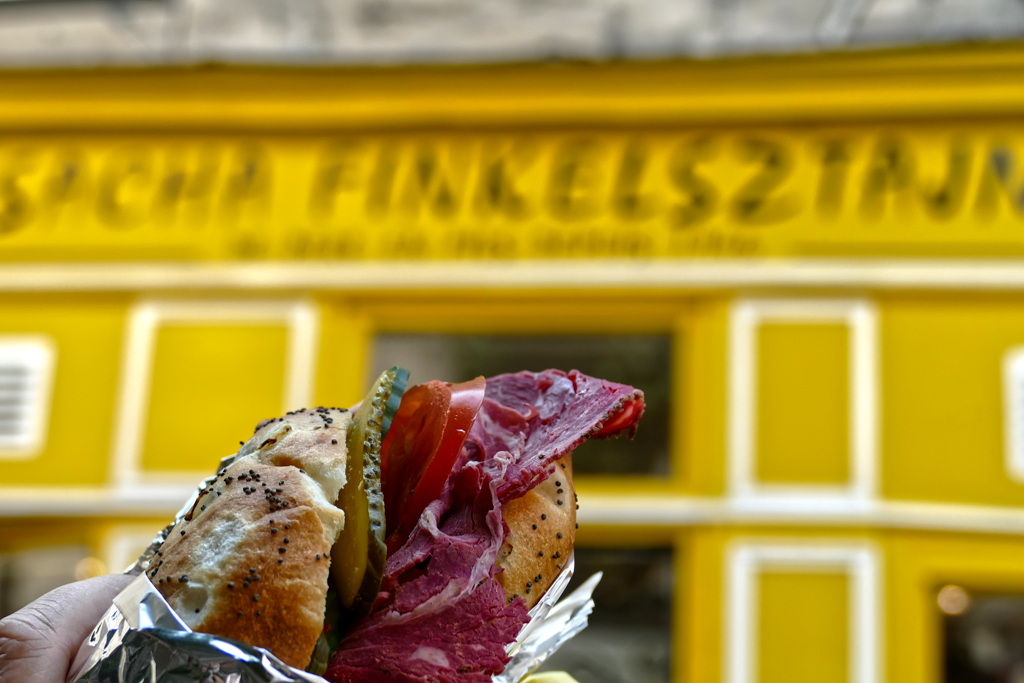
A great alternative is a sandwich or some cake from La Boutique Jaune. Sacha Finkelsztajn opened his classic grocery store in 1946, and since then, you can buy all kinds of traditional Jewish bread and cakes, canned goods, condiments, and other groceries. And for around 10 €uros, they fix you a delicious classic Jewish sandwich.
My Tip
The most idyllic place to enjoy your snack is the Jardin des Rosiers Joseph Migneret. It is a beautiful, lush garden nestled between historic mansions. The main entrance lies a bit hidden in the building on Rue des Rosiers 10. The garden is open weekdays from 8 a.m. to 7 p.m. and weekends from 9 a.m.
Cash And Cards
Since 2001, 20 European countries have paid with €uros, and France is one of them, obviously. The exchange rate is 1 US$ = 0,85 EUR as of October 2025, but you can check the conversion on this page.
Also, you can pay with credit cards, even for the smallest amount, basically everywhere.
Language
The French are famous for many great things. Presumably, speaking foreign languages is not one of those. Nevertheless, I got the impression that after many decades, Parisians are now bowing to the fact that their city is one of the most visited metropolises in the world, and there is no harm in learning at least a few words of English. I felt like hearing a lot more English around me than in previous years, and I also got the feeling that Parisians now mock’n’hate their visitors a bit less for forcing them to communicate in foreign tongues.
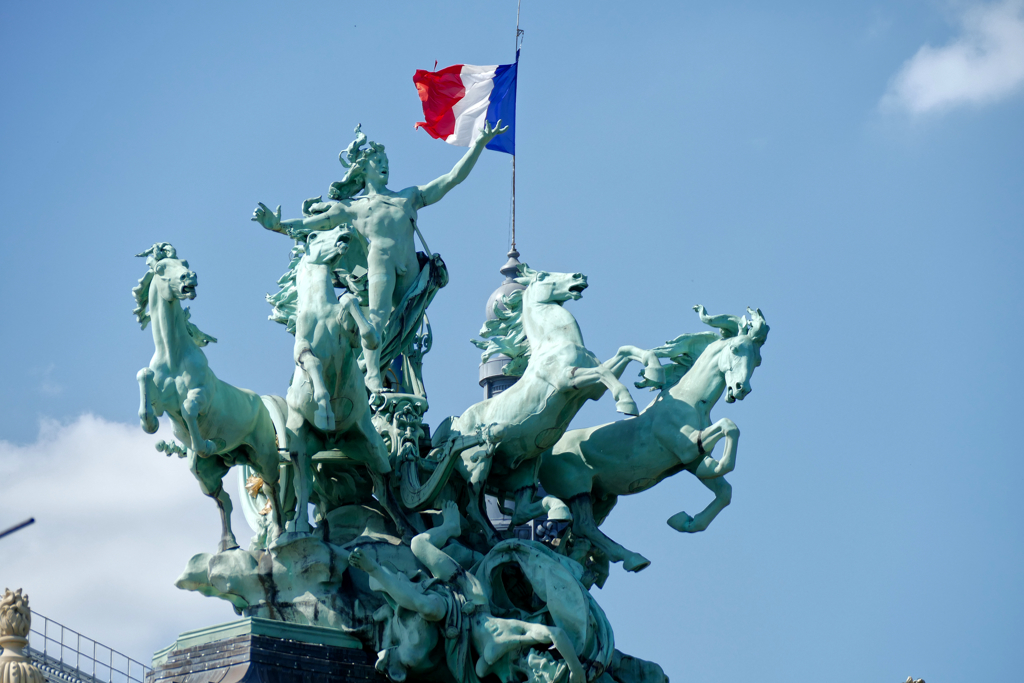
In return, you might want to meet the French halfway by learning at least some polite phrases with the help of babbel or Lingohut, for example.
Connection and Communication
Since June 2017, no roaming charges have applied within the EU with a European mobile phone contract. This applies in all 27 countries of the European Union, as well as in Great Britain, Iceland, Liechtenstein, and Norway, and to all contracts.
In case European roaming is unavailable, you can connect to the internet without any issue at basically every museum, eatery, café, and, of course, hotel.
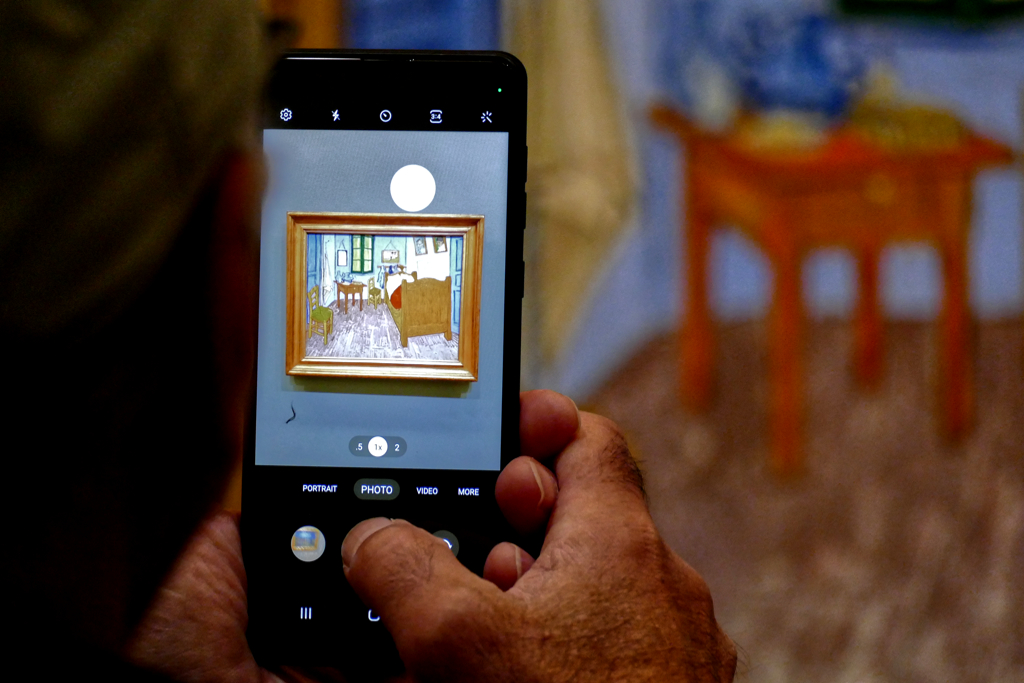
If you insist on being online 24/7, you can get a SIM card, obviously. There are prepaid SIM cards from many companies. The cheapest one is distributed by Orange France and costs only 2.99 €uros. Other brands are SFR France, Bouygues Telecom, and Free Mobile. They cost 10 €uros. Keep in mind that some companies might also charge an activation fee.
In France, they use plug types C and E. Their voltage is 230 V, and the frequency is 50 Hz. Whereby, as nowadays, all these chargers have integrated adapters, in general, the voltage and frequency don’t really matter.
By the way, you’ll find this information and many more comprehensive travel tips in my post World’s Most Complete Travel Information – an indispensable globetrotter classic.
There’s More
So, you reached all the way to the bottom of my inspirational guide to Paris, aimed mainly at first-time visitors, and still want more? No problem, I’ve got you covered! In my post PARIS Museum Pass: Skip the Lines and See It All for Less, I’m introducing a magical key to the city’s amazing museums. So, check out how to get access to no less than 50 museums and monuments at a very reasonable flat rate.
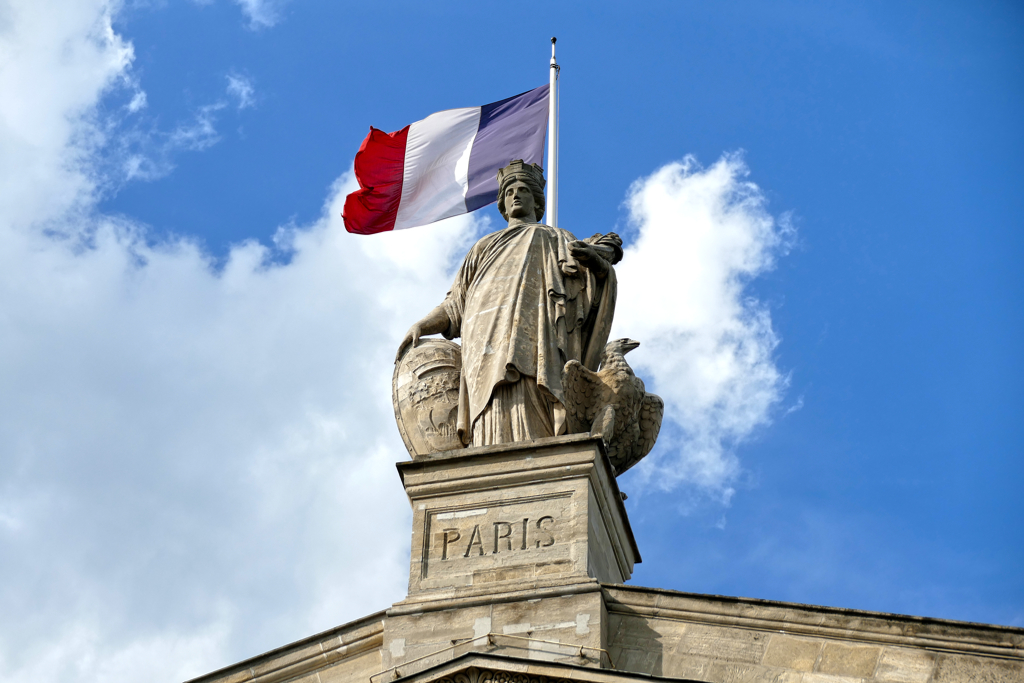
But it gets even better: In my post Paris for free!, I’m introducing parks, panoramic viewpoints, and even museums that won’t cost you anything at all! Don’t believe me? Just rush over and see for yourself!
What’s also completely free is a self-guided walking tour to the most beautiful town palaces you’ll find in the Marais district. With my comprehensive guide 10 Most Beautiful Palaces in the Marais Neighborhood of Paris, you can explore this fascinating quarter at your own pace.
The same goes for urban art, obviously. My post Best Street Art in PARIS: How Mehdi Ben Cheikh Transformed the 13th Arrondissement Into An Open-Air Gallery guides you through a rather non-touristy part of the city where some of the most powerful murals are waiting for you.
And finally, if you are just on a stopover in the city of lights’n’love, check out my guide 24 hours in Paris, where you’ll find a thoroughly planned itinerary for either a sunny or a rainy day.
Map
On this map, you can see where all the must-sees I’m introducing in this post are located.
Clicking on the slider symbol at the top left or the full-screen icon at the top right will display the whole map, including the legend.
Pinnable Pictures
If you choose to pin this post for later, please use one of these pictures:
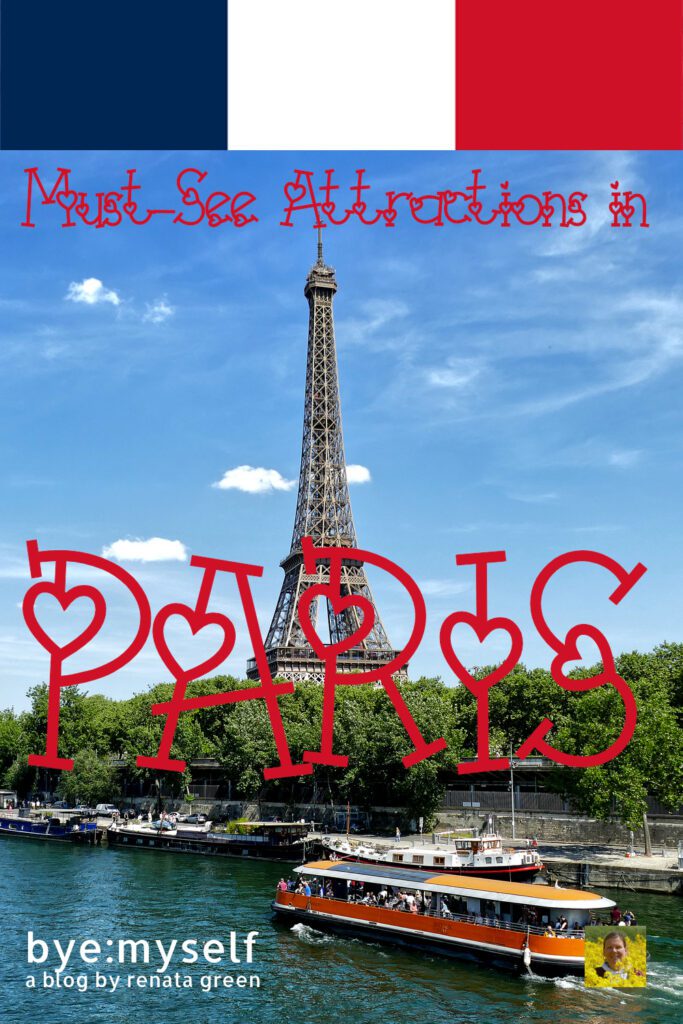
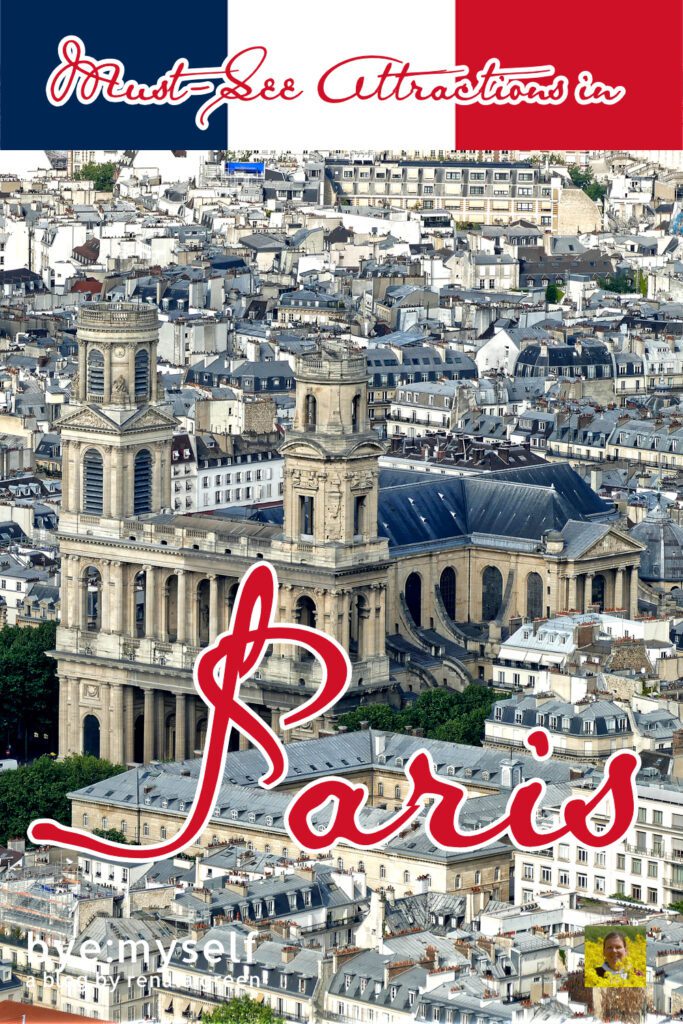
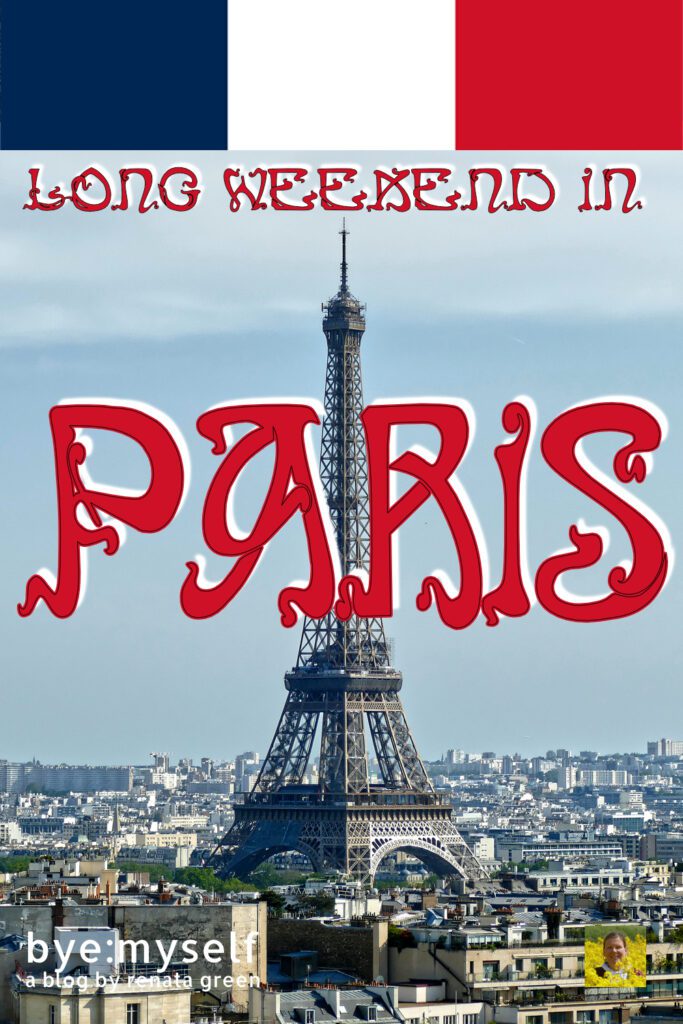
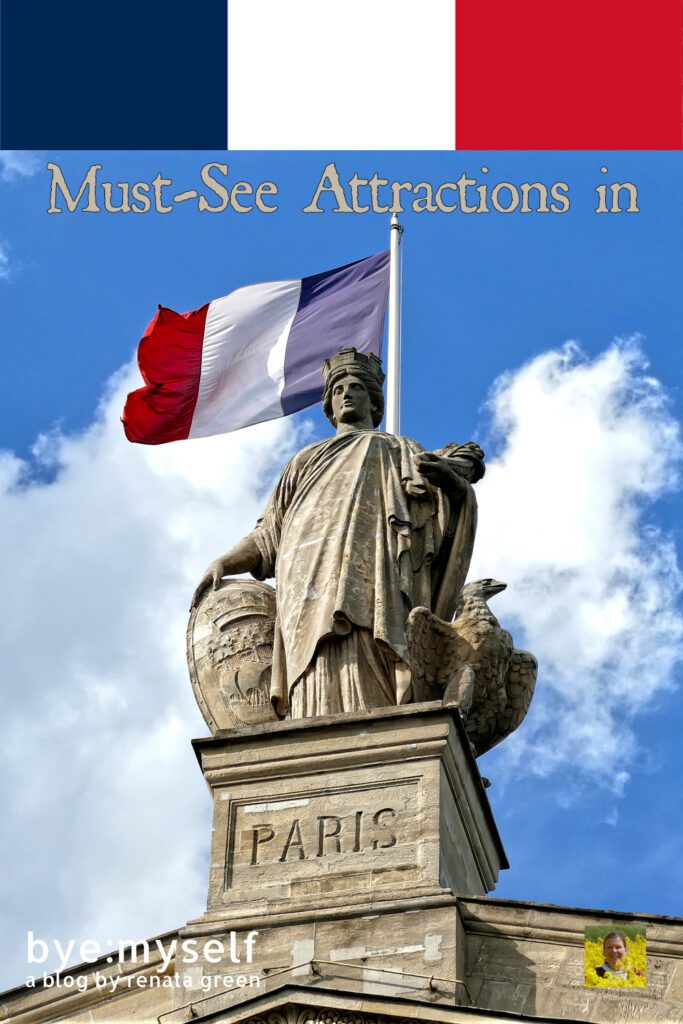
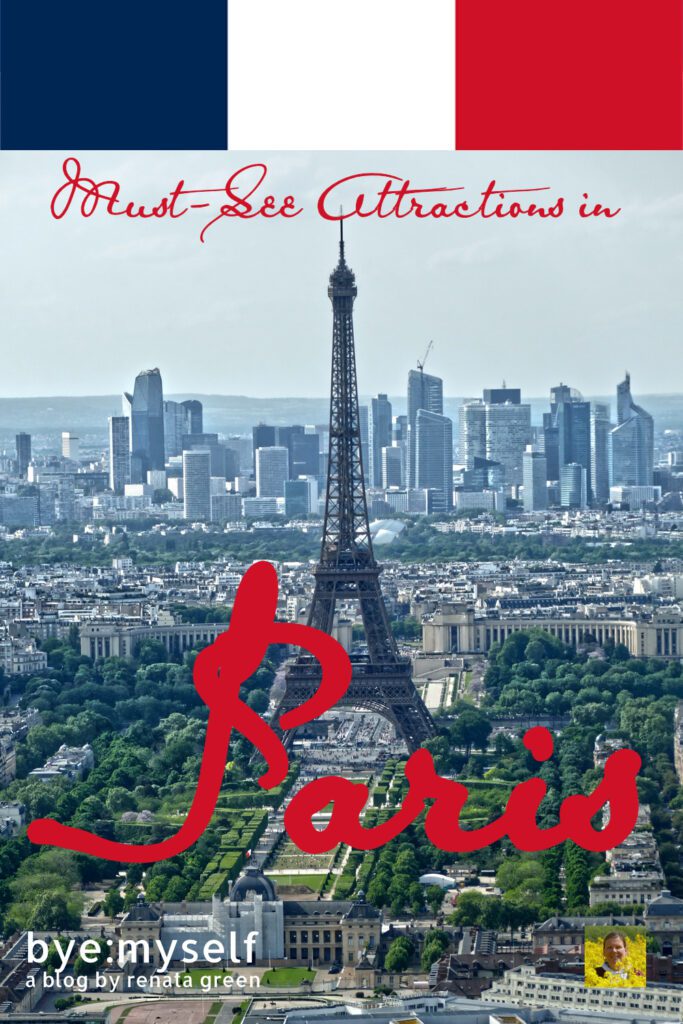
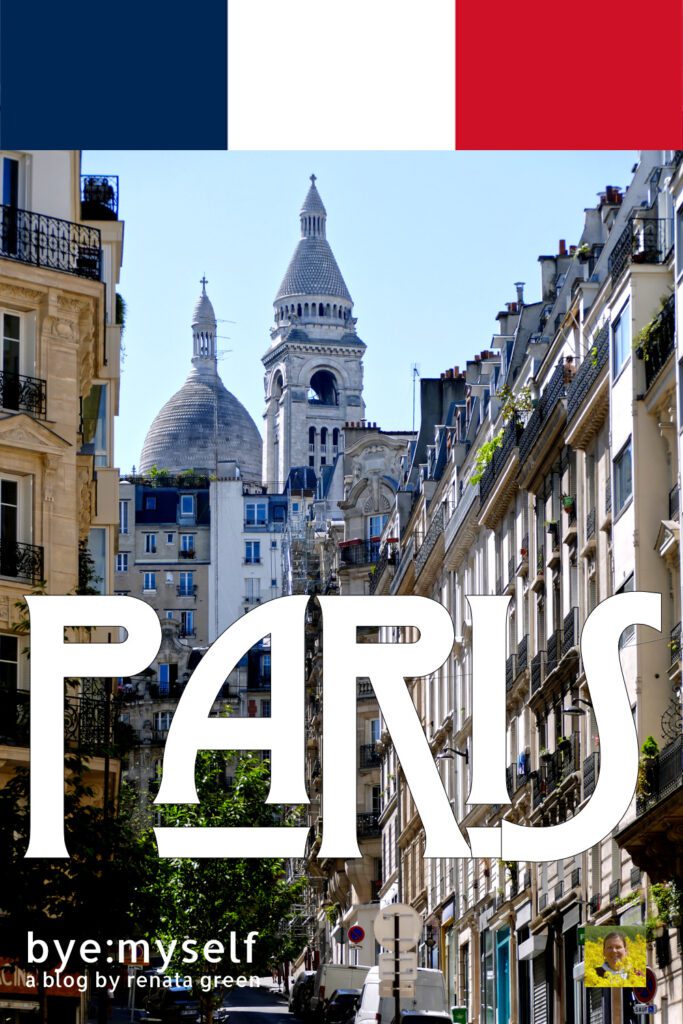
Did You Enjoy This Post? Then You Might Also Like These:
Best Things to Do in AIX-EN-PROVENCE in One Day
The Best Street Art in MARTINIQUE
PARIS for Free!
FRANCE: An Easy Circle Trip to the Five Best Cities to Visit in Provence
What Not to Miss in PARIS: 20 Must-Dos, Not Only for First-Timers
The Best Beaches in Martinique You Can Easily Visit by Public Bus
One Day in ARLES – What Not to Miss in Vincent’s Picture-Perfect City
24 hours in PARIS
* This is an affiliate link. If you book through this page, not only do you get the best deal. I also get a small commission that helps me run this blog. Thank you so much for supporting me!
